Your cart is empty
Have an account?
Log in to check out faster.

Best Sellers

ILCA (Laser) Sailing 101
What is the ilca (laser) class.
Note: In this article, the terms "Laser" and "ILCA" are going to be used interchangeably. Worldwide, the class is now officially known as the ILCA, despite originally being called the Laser .
The Laser class is a one design dinghy originally designed by Bruce Kirby and Ian Bruce in 1969. Although the original intent behind the design was a recreational, family-friendly boat, the Laser has gone on to become one of the most popular racing boats in the world, with over 220,000 produced.
What makes up a boat?
Being a one design and Olympic class, all Laser boats conform strictly to the Laser class rules. In order to compete at continental and international championships, you will need to ensure that your equipment is ILCA class certified, and complies with the measurement standards set out by the class. There is a number of non-class legal equipment available, and if you're just planning on sailing for fun, these are a great option for getting started. (Hint: google Intensity Sails)
A relatively lightweight hull for its size, the Laser is 4.23m long, has a beam of 1.42m and weights 57kg. All hulls are built from glass reinforced plastic (AKA fibreglass) and are known for their robust construction and light weight.
One of the unique features of the Laser class is the three different rigs which can all be used with the same hull. This allows sailors of different ages, weights and abilities to participate in a single class. The rigs are:
Laser Standard (ILCA 7)
Laser Radial (ILCA 6)
Laser 4.7 (ILCA 4)
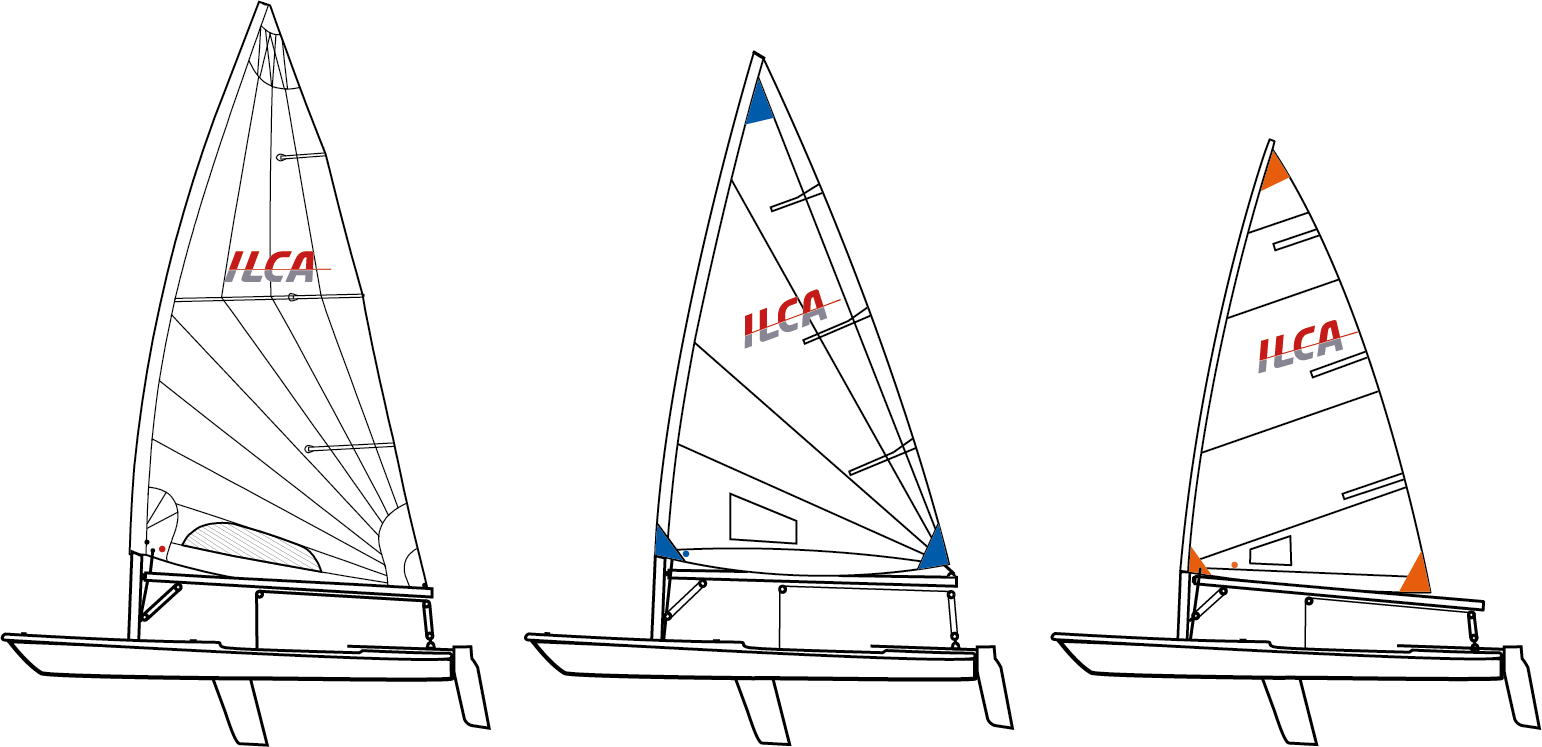
Masts/Spars
Each Laser rig consists of three pieces - the bottom mast, top mast and boom. The bottom mast is specific to each rig size, but the same top section and boom can be used with all three rigs.
Similar to the bottom mast sections, each Laser rig also has its own sail, and they are all different sizes.
Control Lines and Rigging
In the early 2000s, the class introduced the Turbo Kit rigging, which made a significant difference in the techniques and ease of sailing the boat. Although the Turbo rigging is standard nowadays, the old systems can still be found, and can be used to race.
One thing that many sailors like about the Laser is the speed and simplicity of its rigging. The boat has only four main control lines: the mainsheet, vang (kicker), cunningham and outhaul.
Similar to the hull, ILCA foils are also made from fibreglass. The centreboard (daggerboard) is inserted in to the case aft of the mast step, and the rudder clips easily on to the gudgeons on the transom of the hull.
Accessories
Launching trolley - unless you will be beaching (not recommended) or storing your boat on a dock, you will need a trolley to launch your boat. Most boats are sold with these.
Road Trailer - if you would like to sail at different venues, or compete away from home, one of the easiest ways to transport your boat is with a road trailer. The Laser was originally designed to be loaded on to the roof of a car, and if you would like to find out more about transportation methods, we have a full article here .
Tiller and Extension - these come in both aluminium and carbon varieties, and both can be used to race.
Clothing - you can wear anything while sailing the Laser, but I would recommend getting at least a life jacket (better safe than sorry), and a pair of hiking pants. Hiking pants will protect the back of your legs from the deck, and allow you to sail for longer.
Who Can Sail the Laser?
Another great things to mention about the Laser is the range of uses and abilities the boat caters to. Lasers can be sailed on the weekend with your family for fun, or raced in the Olympics and everything in between!
What is the optimal weight for the Laser?
Thanks to the three rig sizes in the Laser class, the weight range in the Laser is quite large. Generally, the Laser Radial (ILCA 6) is suitable for sailors between 60kg and 75kg while the Laser Standard (ILCA 7) is suitable for sailors 75kg to over 90kg. The Laser 4.7 (ILCA 4) is designed specifically for younger and lighter sailors with an optimal weight range between 45kg - 60kg.
What ages are the sailors?
Laser sailing is a sport you can do for life, and nearly every Laser regatta there will be an age category catering to everyone from junior sailors through to master ages. Generally the age categories are U19, Open (20-35), and Masters (over 35). Depending on the regatta, there may also be additional age divisions including U17, and U15. It’s never too late to start sailing a Laser!
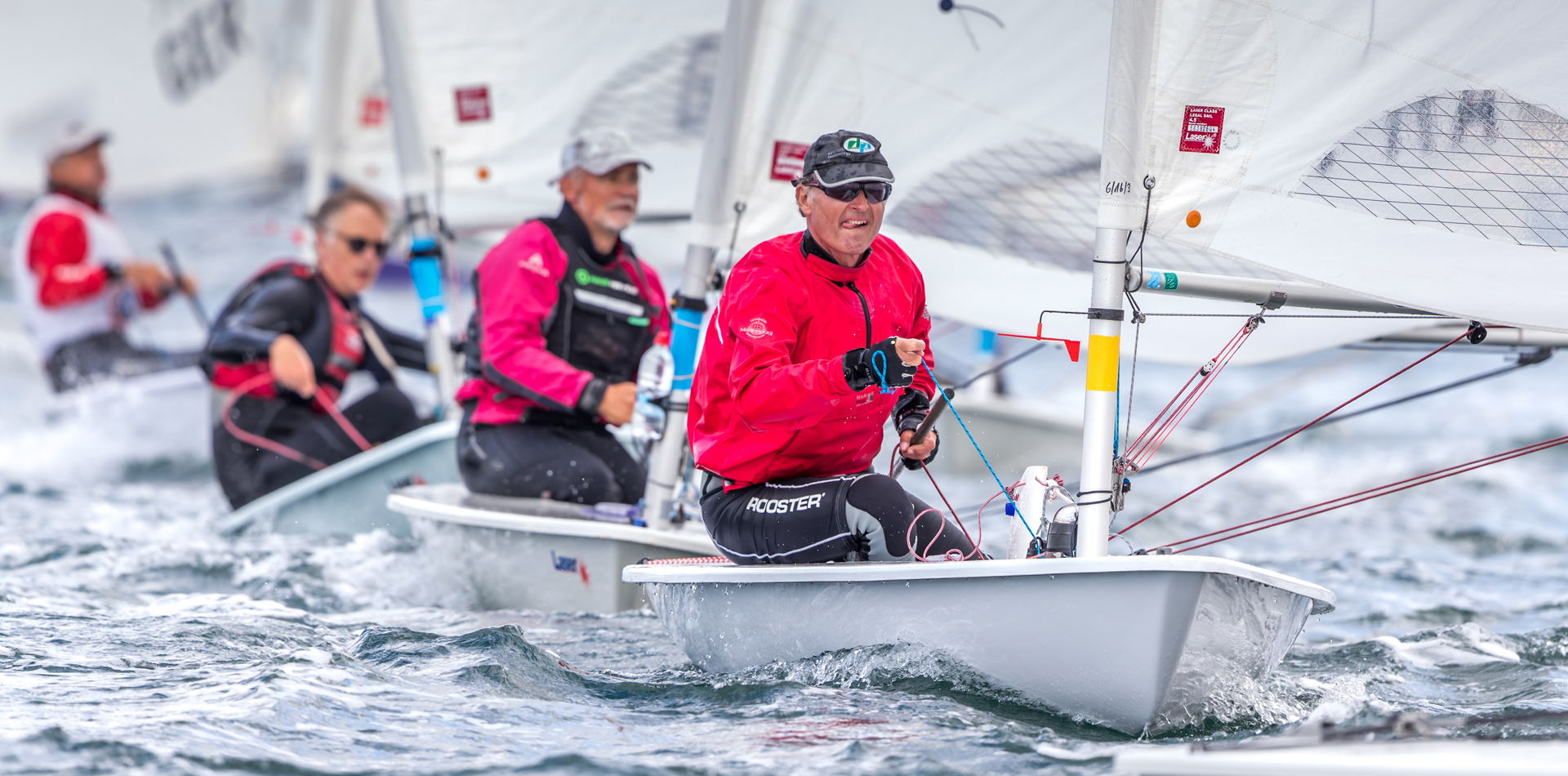
Where to Sail a Laser?
The Laser world is divided in to 6 different regions:
North America
Central and South America
Rest of World
with each region comprising of various member countries and districts. Being the most popular dinghy class in the world, there are Lasers in over 120 countries around the world, and it's likely there is a sailing club with at least one boat near you. For more information and contact details for an association in your country, ILCA have a directory of ILCA District Contacts .
Laser Racing
Since the inception of the class, the Laser has been considered one of the world's premiere racing classes thanks to its low-cost, availability and one design nature providing tight competition at all levels. Since 1996, Laser racing has been included at the Olympics, and many Olympic laser sailors have gone on to the pinnacles of high performance sailing. If you want to see the calibre of some of the sailors who have competed in the Laser, be sure to check out our ranking of the Top 10 Male Sailors and Top 10 Female Sailors of all time.

Outside of the Olympics, the ILCA class also organises World Championships for all rigs and age divisions on a yearly basis. These include the following regattas:
Masters World Championship (all divisions and rigs)
U21 World Championship (ILCA 6 and ILCA 7)
ILCA 4 Youth World Championship
ILCA 6 Women's World Championship
ILCA 6 Youth World Championship
ILCA 6 Men's World Championship
ILCA 7 Men's World Championship.

The full list and dates of upcoming ILCA World Championships can be found on the ILCA website .
Each ILCA region also hosts their own continental championships, and these also have a typically high attendance, and strong calibre of racing. The list of championships for each of the regions can be found here:
Oceania (out of date)
Starting Out with ILCA Sailing
If you're now feeling ready and excited to kick off your Laser journey, here's some things you might want to know before getting on the water
Getting a Boat
Due to their popularity, nearly every sailing club around the world will have at least one Laser lying around which you could try out before you buy your own boat. Many clubs also have rental programs where you can borrow or lease their boats for a minimal cost. This is a great way to get started and see if you enjoy the class.
If however, you're already at the point where you want to get your own boat, there will also be plenty of second hand boats which you could consider upgrading to. If you want some advice on looking for a used Laser, we have a complete second hand Laser Buyer's Guide .
Alternatively, I may have done such a good job convincing you to start ILCA sailing that you're ready to throw yourself in to it headfirst and buy a new boat. If that's the case, contact me at daniel.self@sail27 .com and I can help you find the best boat for you, or connect you with a great Laser dealer in your area.
Training and Coaching
Regardless of your ability, getting a coach is going to help you improve your sailing and much faster than you would by yourself. There are plenty of ILCA coaches all around the world, and the best resource I have found for finding a coach is ILCA's Coach directory . Another great option is to talk to your local sailing club or ILCA district association - they're sure to know someone in your area who can help you get started in the class.
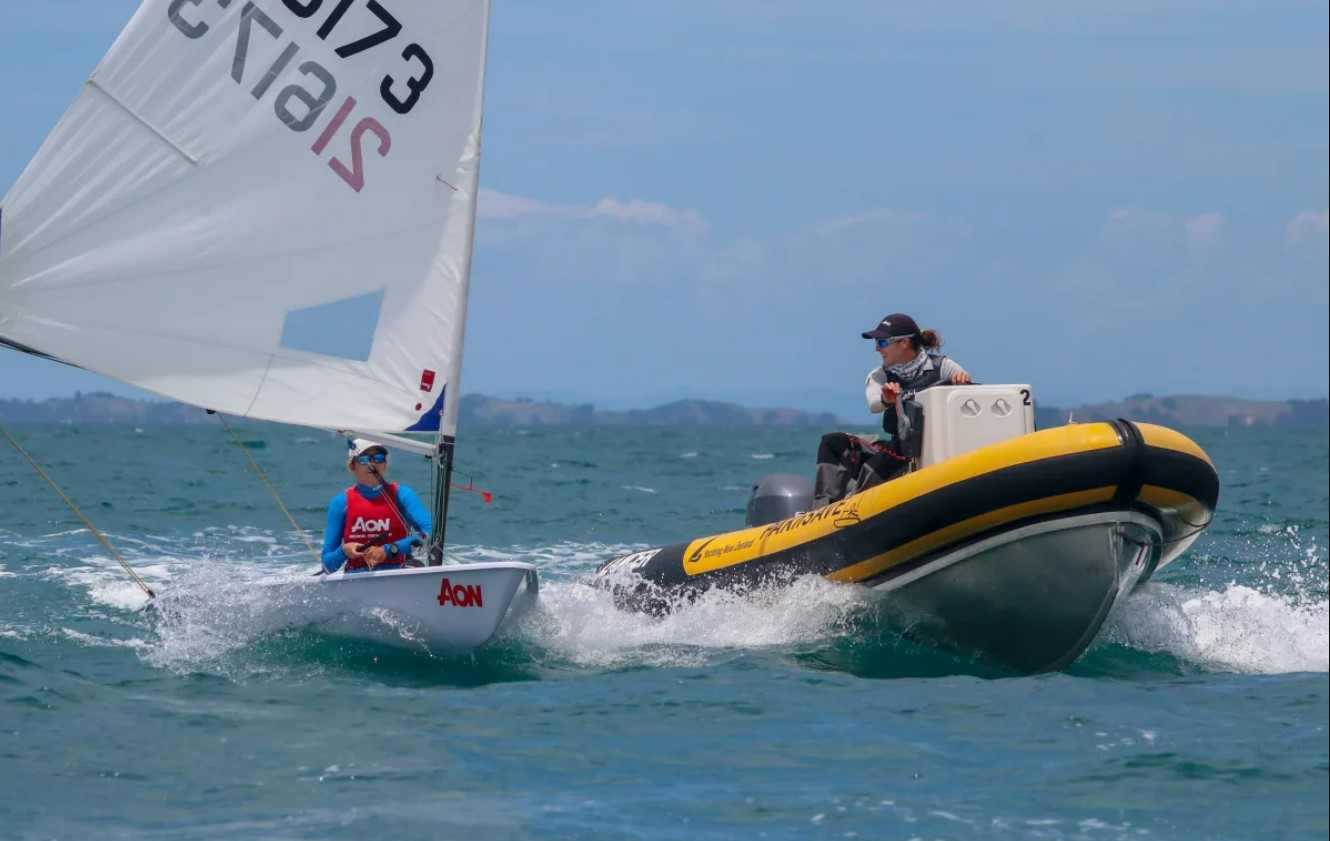
Since the COVID pandemic, online Laser coaching has become more accessible, and the guys at the International Sailing Academy have some great courses which can help you get from an intermediate to advanced Laser sailor.
You may however still be more of a 'book person' (that's how I started as well). If that's the case, I would recommend the RYA Laser Handbook. Although its a little older now, this is the most comprehensive guide to Laser sailing that I've read. Even as I got further in to my sailing journey, I would often refer back to this book for new tips.
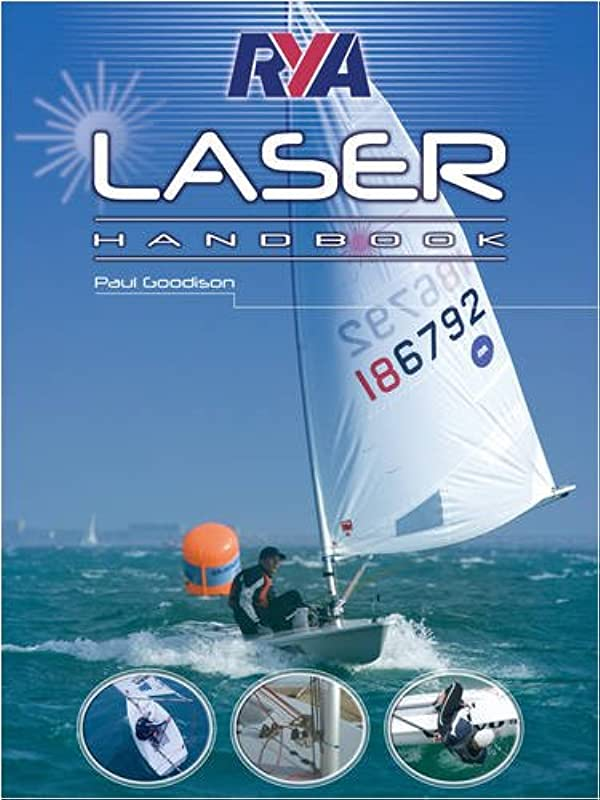
Wrapping Up
With all of that information, you should now be well versed on the ILCA class, and how you can get started in it. If you need any further information, feel free to comment below and I'll try to answer as well as possible. Otherwise, happy sailing and I'll see you on the water sometime soon!
Leave a comment
Please note, comments need to be approved before they are published.
- Choosing a selection results in a full page refresh.
- Opens in a new window.
- 1 Introduction
- 2.1 The Laser 4.7 / ILCA 4…
- 2.2 The Laser Radial / ILCA 6…
- 2.3 The Laser Standard / ILCA 7…
- 3.1 Hull Specs:
- 3.2.1 Laser Standard / ILCA 7 Rig
- 3.2.2 Laser Radial / ILCA 6 Rig
- 3.2.3 Laser 4.7 / ILCA 4 Rig
- 4 The International Laser Class Association
- 5 The Laser Sailing Community
- 6 The Appeal of Laser Sailing
- 7 The Future of Laser Sailing
- 8 Conclusion
Introduction
The Laser Dinghy, a one-design racing sailboat, was designed by Bruce Kirby and unveiled to the public at the 1971 New York Boat Show. Since then 200,000+ Lasers have been built to date and are sailed across 140+ countries, with its popularity being primarily due to its simplicity and performance.
The original concept for the Laser centered on creating a boat that was easy to build, sail, and purchase, thereby making it accessible to a broad range of sailors. The Laser quickly gained popularity and became the boat of choice for many sailing schools and clubs worldwide. It also rapidly gained recognition as a racing boat and debuted as the single-handed open-class dinghy in the 1996 Olympic Games.
Racing is very competitive due to the one-design restrictions, which means sailors are truly able to test their ability, rather than rely on differences in hull shape, sails, and other gear to gain an advantage.
Besides being used for competition, the Laser is a popular choice for recreational sailing. You can spot these dinghies on lakes, rivers, and oceans worldwide. With its one-design nature, ease of use, and practicality, the Laser Dinghy is set to remain a popular sailboat for many years to come.
The Laser Dinghy – 3 Sailboats In 1

The laser dinghy comes in 3 rig sizes:
- 4.7 / ILCA 4
- Radial / ILCA 6, and
- Full/Standard / ILCA 7 rig
This means that sailors of just about any ability or age can enter the sport, and advance with minimal cost.
Rigging is easy using a sleeved sail over a mast with no stays, and can be launched and sailed single-handedly with ease. Minimal parts mean minimal breakages and maintenance.
The Laser 4.7 / ILCA 4…
utilizes a smaller sail than the Standard rig (4.7m 2 / 50.6 ft 2 which is 33% smaller) and a shorter pre-bent lower mast section. It is ideal for lighter sailors (up to 121lb / 55kg) and beginners.
The Laser Radial / ILCA 6…
uses a smaller sail than the Standard rig (5.76m 2 / 62 ft 2 which is 18% smaller) and a shorter more flexible lower mast section. It is suitable for sailors between about 121lb – 154lb / 55kg – 70kg. The Radial is the most popular class of Laser, as it is suitable for the largest amount of people, including youth, women, and masters. The radial sail can easily be identified by the sail cut in a radial pattern emanating out from the clew.
The Laser Standard / ILCA 7…
has a 7.06m 2 / 76 ft 2 sail, and is more suitable for sailors above about 143lb / 65kg. This rig is suited to heavier sailors in windy conditions where weight, strength, and fitness are critical.

Summary of Key Laser Dinghy Specifications
Hull specs:.
- Length overall (LOA): 4.23m / 13ft 10.5in
- Length waterline (LWL): 3.81m / 12ft 6in
- Beam: 1.42m / 4ft 8in
- Hull Weight: 57kg / 125lb
Laser Sail Area Specs:
Laser standard / ilca 7 rig.
- Sail area: 7.06m 2 / 76 ft 2
- Luff: 5.13m
- Leech: 5.57m
- Foot: 2.74m
Laser Radial / ILCA 6 Rig
- Sail area: 5.76m 2 / 62 ft 2
- Luff: 4.56m
- Leech: 5.01m
Laser 4.7 / ILCA 4 Rig
- Sail area: 4.70m 2 / 50.6 ft 2
- Luff: 4.09m
- Leech: 4.54m
- Foot: 2.48m

The International Laser Class Association
The International Laser Class Association (ILCA), a global organization with regional sites, governs the Laser class of sailboats. The organization is responsible for developing and enforcing the class rules, which ensure that all Laser boats are built to the same specifications and are eligible to compete in official Laser regattas. The Laser Class Association also organizes and oversees major regattas and championships, including the Laser World Championships and the Laser Masters World Championships.
Membership in the Laser Class Association is open to anyone who owns or sails a Laser boat. Members have access to a wide range of benefits, including access to official class materials and publications, as well as opportunities to compete in official Laser events. The Laser Class Association also offers support and guidance for sailors who are interested in organizing their own Laser regattas.
The Laser Class Association plays a vital role in promoting and supporting the Laser class of sailboats and is a great resource for anyone who is interested in Laser sailing.
The Laser Sailing Community
The Laser sailing community is a vibrant and passionate group of sailors who share a deep love for the sport. From beginners and avid enthusiasts to professional athletes, this global community is bound by a common bond – the thrill of sailing the Laser. As one of the most popular sailing classes worldwide, Laser sailors come from diverse backgrounds, cultures, and age groups, united by their shared passion for the sport.
Laser sailing’s popularity extends across various regions, making it a truly international phenomenon. From the shores of Australia to the coasts of Europe, and the lakes of North America, the Laser class has a widespread following. Its appeal lies in the boat’s versatility, allowing sailors to compete in a wide range of sailing conditions, from challenging regattas to more relaxed lake racing. This popularity has fostered a thriving competitive racing circuit, attracting skilled sailors to local, national, and international events.
One of the most cherished aspects of the Laser sailing community is the camaraderie and sportsmanship among its members. Whether on the water competing fiercely during races or on shore sharing stories and experiences, Laser sailors exemplify a strong sense of friendship and mutual respect. Sailors often support and encourage each other, both in victory and defeat, creating a welcoming and supportive atmosphere for newcomers and seasoned sailors alike. The camaraderie extends beyond the racecourse, with events often turning into social gatherings where lifelong friendships are forged.
In the Laser sailing community, it’s not just about winning races; it’s about being part of a global family that shares a profound connection to the sea and the sport of sailing. The sense of unity and passion that emanates from this community is what makes Laser sailing not just a sport but, for many, a way of life. Whether you’re an aspiring sailor or a seasoned competitor, joining the Laser sailing community opens doors to an unforgettable journey filled with exciting challenges, lasting friendships, and the sheer joy of sailing.
The Appeal of Laser Sailing
Laser sailing offers a unique and attractive experience that captivates sailors of all levels. Its versatility, simplicity, and accessibility make it an ideal choice for both beginners dipping their toes into sailing and seasoned sailors seeking thrilling challenges on the water. The statement “It’s easy to learn but hard to master” describes it well and explains why it is so popular.
At the heart of Laser sailing’s appeal is the boat’s remarkable agility and responsiveness. The Laser’s lightweight hull and sensitive controls allow sailors to feel intimately connected with the water, empowering them to navigate with precision and grace. Whether cruising around or pushing the limits on a windy day, the Laser promises an exhilarating experience for all.
For those of us who are a bit more competitive, Laser sailing provides an unmatched thrill. The class’s popularity in local and global racing circuits opens up a world of exciting opportunities to test skills and compete against fellow enthusiasts. From local club races to prestigious international events, including the Olympics, the thrill of competitive Laser events creates an unforgettable sense of camaraderie and accomplishment that drives sailors to continually seek new challenges on the racecourse.
The Future of Laser Sailing
The Laser class continues to evolve with recent developments and potential future advancements. Technological innovations and advancements in materials are constantly being explored to enhance the boat’s performance while maintaining the strict one-design principle. As the class adapts to new challenges and opportunities, it remains committed to preserving the essence of Laser sailing – simplicity, accessibility, and competitive racing.
The Laser sailboat’s enduring popularity among sailors worldwide ensures that its future remains bright. With a strong and dedicated global community, the class continues to attract sailors of all ages and skill levels. The appeal of Laser sailing lies not only in its exciting on-water experiences but also in the lasting connections and friendships forged within the community.
As a class that thrives on inclusivity and camaraderie, Laser sailing’s relevance is poised to endure for generations to come. As new sailors discover the joy of Laser sailing and experienced sailors continue to push their boundaries, the future of Laser sailing remains a vibrant and promising one.
The Laser sailboat’s rich history, innovative design, and enduring popularity have solidified its place as one of the most beloved sailing classes worldwide. From its humble beginnings to becoming an Olympic icon, the Laser’s impact on the sailing world is profound, inspiring countless sailors to take to the waters and embrace the thrill of the sport. Its versatility, agility, and competitive edge make it a vessel of choice for sailors of all levels, from enthusiastic beginners to seasoned professionals.
As you dive deeper into the exciting world of Laser sailing, I invite you to explore further content on this website. Discover more about Laser sailing and the thriving global community that shares your passion. Whether you’re looking to purchase your first Laser dinghy , fine-tune your racing skills , or simply immerse yourself in the beauty of sailing, the Laser class promises a journey filled with excitement, camaraderie, and boundless possibilities. So, let’s celebrate the joy and passion of Laser sailing together.
Previous: Laser Sailing FAQ
Next: How To Learn To Sail
32 Comments
I am switching my boat from sailing 470 to sailing a laser now. I intend to sail laser primarily to qualify for the Olympics.
My question is if my height is good enough to sail laser standard. My height is 167 cm (5 ft, 6 inches) and weight is 68kgs.
Thanks, Vincent
Hi Vincent. Thanks for your question. I would say that at 167 cm and 68kgs, you would be at the lighter/shorter end of the scale for sailing a full rig laser. You may be able to put on some bulk before the next Olympics to handle it a bit easier. I think everyone has different opinions on what is the ideal weight for a laser. A lot depends on the conditions and your skill. Just for your info, I did some research on stats for Australia’s gold medalist at the 2012 London Olympics Tom Slingsby. He was reported to be 83kg & 186cm at the time. Good luck with it, and all the best. Brendan
My Grand daughter would like to switch froom sail Terra to Laser. What is the minimum height for the class
Hi Norman Thanks for your question. I’m not sure that there is a minimum height. It’s more about the weight. For a Laser 4.7, the ideal weight is around 110-130 lbs (50-58 kg). Any lighter and she may have trouble keeping it flat in a breeze. cheers Brendan
Hi, I am looking to buy a laser and am 5ft 10 (178cm) and around 68kg, I sail in a harbour so short chop is the worst condition, do you think I’m big enough for a standard?
Hi Giles I don’t think it’s as much about the height as it is the weight. At 68kg, you might be a little on the light side for a full rig. But it depends on how windy it tends to get also. If it’s generally pretty windy, you might struggle, but if it’s often fairly light, you may be ok. This thread has a good discussion on the ideal weight for laser standard sailor. Hope that helps. Brendan
Hi My sea scout troop has taken possession of a Laser 2. It lacks a suit of sails and a rudder. talking to others, no one is sure if the rudders are identical to Laser 1’s. Can you advise?
Hi Pete Thanks for your question. I am not very familiar with the Laser 2, so did some research. However, it was very hard to come up with information on the Laser 2 specs. From what I could tell, the rudders are different between the Laser & Laser 2, however, I was not able to find the actual specs on the Laser 2 rudder. For a measurement diagram for the Laser rudder, click here (click on the “Mast Top Section, Boom and Foils” tab). For an image of the Laser II rudder, check this out . As you can see, it looks slightly different to that of the standard Laser rudder . Sorry I can’t be of more help than that. Maybe some other readers can provide some more info. cheers Brendan
Hello, I am 6 feet tall and weigh 53 pounds, what laser whould be good for me?
Hi Alessandro Thanks for your question. I hope you mean 153lb, and not 53lb!! Opinions vary, and it depends on your fitness and ability. If you are just starting out, you may be best suited to a Radial Laser, but you are in the overlap zone between the Radial and Full rigs. So it depends a lot on your experience and fitness. It can also depend on where you live. If it tends to be quite windy on a regular basis, then you may opt for a smaller rig. Conversely, if it’s often quieter on the water, then a bigger rig may help. I’m a few lb/kg heavier than you, and I have a full-size / standard Laser rig. I find it’s great for the lighter days, but can be a bit overpowered on the heavier days. I don’t mind though, as it just makes it more exciting when you go around the top mark. cheers Brendan
Hi I’ve just brought a laser with a radial sail but a Standard mast. I was gonna make a Radial mast out of the right alloy tube but I need the measurements. Would anyone know what is The length of a radial mast?
Thanks Kaleb
Hi Kaleb Here are the measurements for the different Laser masts for each of the top and bottom sections. cheers
How tall is the mast on the “std” Laser? I had one once and it was fun getting it into the hole on the hull! Cliff
Hi Cliff Yes, it can take a bit of getting used to, when putting the mast into the mast step. Looking at this site , the total laser mast length should be approx.: – top section (including top plug) = 3600 – 305 = 3295mm – bottom section (including base plug) = 2865mm Overall laser standard mast length = 6160mm / 20.2 ft (approx.) Hope that helps!
Hi, I am 155 cm tall and weigh 49 kg. Am I suitable for sailing a laser 4.7 or should I sail a 420?
Hi D I’m not an expert with the 420. For a laser 4.7, I think you would be a bit on the light side, but it also depends on how fit, strong, and experienced in sailing you are. It may also depend, to some extent, on where you live (some places are windier than others)… if you have a strong sea breeze every afternoon, then this may be too much.
Hi, I’m a fairly experienced optimist sailor and I need to change my class due to my age. I am 157 cm tall and I weigh 46 kg. Would I be able sail a laser 4.7? The place I live can get very windy at times. Thank you
Hi Defne I think a 4.7 should be ok, but it would depend on your experience and level of fitness. Since you say that you are a fairly experienced optimist sailor, then that will definitely help. You might struggle a bit on the windy days though. If you can, ask around your local club and try to take a 4.7 out for a spin. Let us know how you go! All the best.
Hi I sail optimists and are looking into a laser as the next boat. I weigh 122 pounds and was wondering if I should get a radial or a 4.7 rig
Hi Noah Your situation is similar to the previous comment in June, so not sure if you saw that. It depends on a few things… including how experienced you are, how fit and strong you are, and what the typical conditions are like where you sail. At your current weight, you’re probably at the lower end of the ideal weight range for a radial. But if you are young and still growing, you might want to get the radial and grow into it over the next year or so. But you might struggle a bit at 1st on the windy days. See if you can take one of each out for a spin and give it a test for yourself. Best of luck with it!
Hello I have a Laser Radial sail with a “33” number above the boat sumber. the boat number is 177137 so its not an abbreviation of that … do you know what the 33 means? Thanks!
Hi Russ I’m not sure what the “33” about the boat number would refer to. Maybe some other readers may be able to help? Sorry I can’t help more than that. All the best with it.
Hi. I am currently building an El Toro dinghy. I do not want to have to handle the full 14 foot one-piece mast. I read somewhere that you can retrofit a laser 4.7 mast and sail onto an El Toro hull. A Sabot boom is marginally cheaper than a laser 4.7 one, and I was wondering if a laser 4.7 mainsail would fit a sabot boom. Thanks!
Hi Alexander I am not an expert on sabots, but from my research… The Laser 4.7 sail has a foot of 2.48m / 8.1ft. The sabot sail has a foot of 7ft and a boom of 7′ 3″. So the sabot boom looks too short for a Laser 4.7 sail.
Can anyone please tell me in what year Laser #66750 would have been made?
Hello Steve According to research that I had done previously, it looks like sail number 66750 would have been made in 1979. See this link for more info. cheers Brendan
Hi, I have sailed Sunfish sailboats, and years ago I crewed for a friend on his J24 in PHRF races. I love the idea of excitement when I sail, but I would also like to be able I sail with a passenger. Can a Laser be sailed with a passenger for entertainment? I did not see anything about the maximum capacity of the hull. Doug
Hello Doug A Laser sailing dinghy is designed as a single-handed boat, meaning it is typically meant to be sailed by one person. However, it is possible to sail a Laser dinghy with two people, although it may not be the most efficient or optimal way to use the boat. It is only a small dinghy, so the extra weight will affect the performance. There is not much room in the cockpit for 1 person, so for 2 people, it will be even more cramped. If you just want to go out and have some fun (and you and your passenger aren’t too big), then you can probably do that. But there are many other dinghies available that are specifically designed for two-person sailing that would be a better option.
Hello, I am looking for the width of the bottom part of the mast, to design a fitting for a wind indicator. Although I have looked through many sites (including the ones linked in the comments), I can’t find the specific measurements. James
Hello James The Laser mast diameter is approx. 2.5″ or 64mm.
I holiday in Finland and have just been given a laser to use but I need a hand trolley to get it over the stones on the shore. When I had a laser before many years ago, I had a light hand trolley made with plastic tubing. Do you or anyone else have a model on how to make one? I have wheels
Hello Brian I do not have any plans or instructions, but there are a few forums that discuss how to make a homemade dolly. Check out some examples here and here . Otherwise, there are new dollies for sale. Have a look at this page for more info. cheers
Leave a Comment Cancel Reply
Free Shipping Over $99* - 366 Day Returns - Dedicated Customer Support

- Call Us +1-503-285-5536
- Sign in & Register
- Recently Viewed
Guide to Laser Sail and Rig Sizes

Over 200,000 Laser sailboats have been built over the last 40 years, more than most other small dinghy sailboats. In this article we are going to answer one of the most common questions we get: What size rig do I have? This will help answer what size sail and/or rig you already have and what size sail and/or rig you need to purchase to update your Laser.
What size rig / sail do I have? Standard vs. Radial vs 4.7 Explained
The Laser sailboat has had a number of different rig sizes, with the intention of making the boat sailable by a wide range of sailors (and different sailor weights) by simply swapping out the lower mast section and sail while keeping all other components the same. There are currently three different rig sizes and they are commonly referred to as 'Standard', 'Radial' and '4.7'. Below you will find an image that shows the three rigs side by side, and in the following section we'll explain each one.

Laser Standard / MK2 / ILCA 7
This is the most common Laser rig size, and the original rig on the boat when it was designed. It features a 7.06 square meter sail (about 76 square feet). In 2018, the Laser Class approved a new 'Standard' sail, which is referred to as the 'MKII' or 'Mark 2' to distinguish it from the first version. The difference, among other things, is in the panels. The original 'Standard' sail featured horizontal cut panels. The new MkII sail has radial cut panels. There is no difference in size between these two versions, and as of 2020 all new Laser Standard sails are available in this updated cut.

How to tell if you have a 'Standard' sail: The first and most obvious way to tell if you have a 'Standard' sail is to look at the panels. If they are horizontal, it is most likely a standard sail. Next, you can measure the luff (the front edge of the sail along the mast sleeve). This measurement should be about 5130 mm or 200 inches from the top of the sail to the bottom.
How to tell if you have a 'Standard' lower mast section: The 'Standard' lower mast section should measure about 2865 mm or 113 inches . It is a fairly stout mast section compared to the two smaller mast sections.
Laser Radial / ILCA 6
Originally called the 'M' rig when first designed, the Laser 'Radial' sail is smaller than the 'Standard' sail at 5.76 square meters (62 square feet). At the time, it was the only Laser sail to feature the radial cut panels, which allowed the sail to be de-powered more easily in bigh winds. Per the notes about the 'Standard' rig above, both the Standard and Radial sail feature the radial cut design. Another typical indicator of a Radial size sail are the blue panels at the tack and clew of the sail.
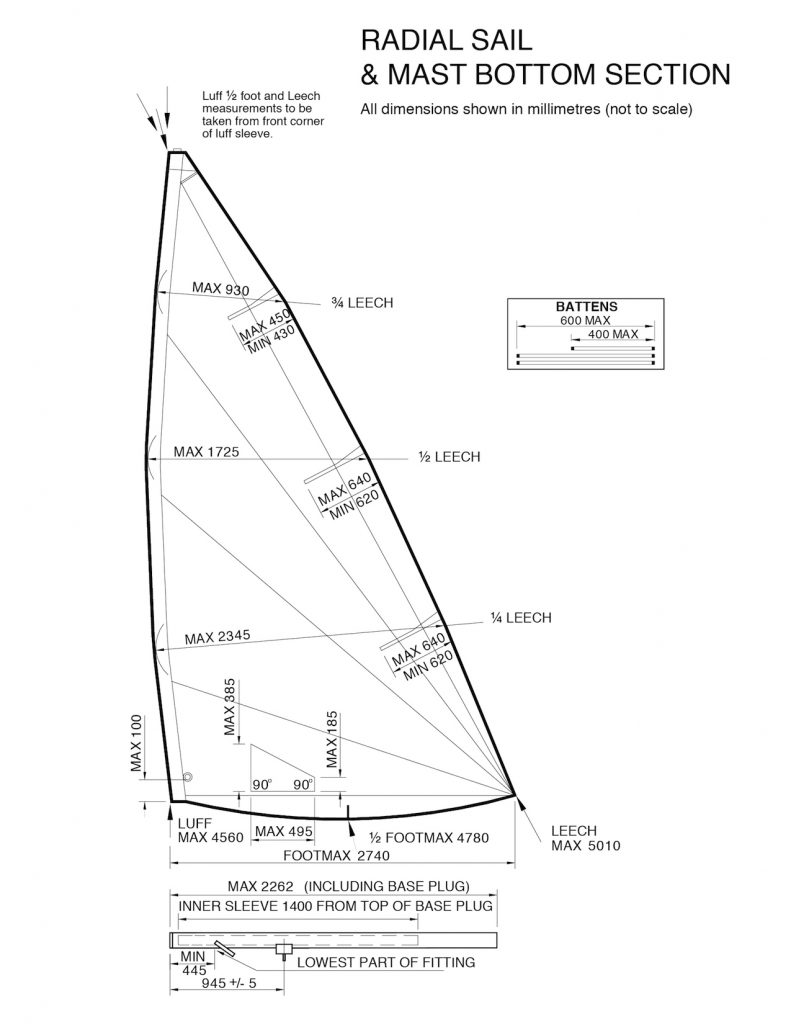
How to tell if you have a 'Radial' sail: The first and most obvious way to tell if you have a 'Standard' sail is to look at the panels. If they are radial, as in emanating out from the center, it is most likely a radial sail. Next, you can measure the luff (the front edge of the sail along the mast sleeve). This measurement should be about 4560 mm or 180 inches from the top of the sail to the bottom.
How to tell if you have a 'Radial' lower mast section: The 'Radial' lower mast section should measure about 2262 mm or 89 inches . It is also a bit smaller in diameter than the standard section.
Laser 4.7 / ILCA 5
The Laser 4.7 (or ILCA 5) is the smallest of the three Laser sails and was designed for young sailors just getting into Laser sailing. The 4.7 lower mast section is also different from the others in that is has a pre-bend near the boom fitting, allowing the sail to depower much easier. This is the least common Laser sail size, and if you have an old one around, chances are it is not a 4.7 sail.

How to tell if you have a '4.7' sail: The 4.7 is similar to the old 'Standard' sail as it has cross cut panels. Many 4.7 sails also have an obvious 4.7 logo somewhere on the cloth. Next, you can measure the luff (the front edge of the sail along the mast sleeve). This measurement should be about 4080 mm or 160 inches from the top of the sail to the bottom.
How to tell if you have a '4.7' lower mast section: The '4.7 lower mast section has a pre-bend in it and should measure about 1810 mm or 71 inches . The bend is the easiest way to tell it apart from the others.
Subscribe To Our Newsletter
Sign up for our newsletter to receive exclusive discounts, new product announcements, and upcoming sales.

- O’pen Skiff Purchase Page
- ILCA – Element 6
- RS Sailboats
- Sunfish – Recreational
- Sunfish – Race Version
- Sunfish Sails
- LaserPerformance Sunfish Parts Price List
- 420 – Zim Sailing
Finding the Right Laser Rig: Formula
- Racks by Dynamic Dollies and Racks
- Load Rite Trailers
- Load Rite Sunfish Trailer
- **NEW** LoadRite for Sailboats
- Sunfish Dolly by Dynamic
- Optimist Dolly by Dynamic
- How to Apply Laser Sail Numbers
- Applying Laser Sail Numbers
- North Sails for LaserPerformance Dinghies
- About/Contact
Choices of Rigs for your Laser Hull :

Finding the Right Laser Rig – 3 Choices:
Now this is where it becomes a bit interesting because all three rigs fit and work exceptionally well with the Laser hull. Any sized sailor can sail with one of these rigs in most conditions and have fun. But what if you are thinking competitively? What is optimal for you? The quick and simple formula is this:
- 4.7 Rig – Designed for smaller sailors 110 – 140 lbs. (50 – 65 kg).
- Radial Rig – Used as the women’s Olympic class, and designed for sailors 140 – 175 lbs. (65-80 kg).
- Full or Standard Rig – Used as the men’s Olympic class, and designed for sailors 165 lbs.+ (75 kg+).”Olympic sailors are in the 180 lbs. range but club sailors do well weighing in over 200 lbs. in certain conditions.” Paraphrased from propercourse.blogspot.com
Laser 4.7 Rig:
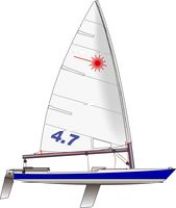
Laser Radial Rig:

A look at the hardware that changes the 3 rigs:
The Upper Mast section on the left side in this drawing is identical for all 3 rigs. It mates together with the other lower 3 mast section choices shown at the right. These parts are all available from Shoreline Sailboats along with class legal sails. The lower mast sections come with a gooseneck and vang tang; completely ready to go.
No matter which rig you choose, the Laser is a challenging boat that rewards athleticism, subtle steering, and trimming techniques, as well as tactical excellence.
Share this:
- Click to email this to a friend (Opens in new window)
- Click to share on Facebook (Opens in new window)
- Click to share on Twitter (Opens in new window)
- Click to print (Opens in new window)
- Click to share on Pinterest (Opens in new window)
- Click to share on LinkedIn (Opens in new window)
- Click to share on Tumblr (Opens in new window)
- Click to share on Reddit (Opens in new window)
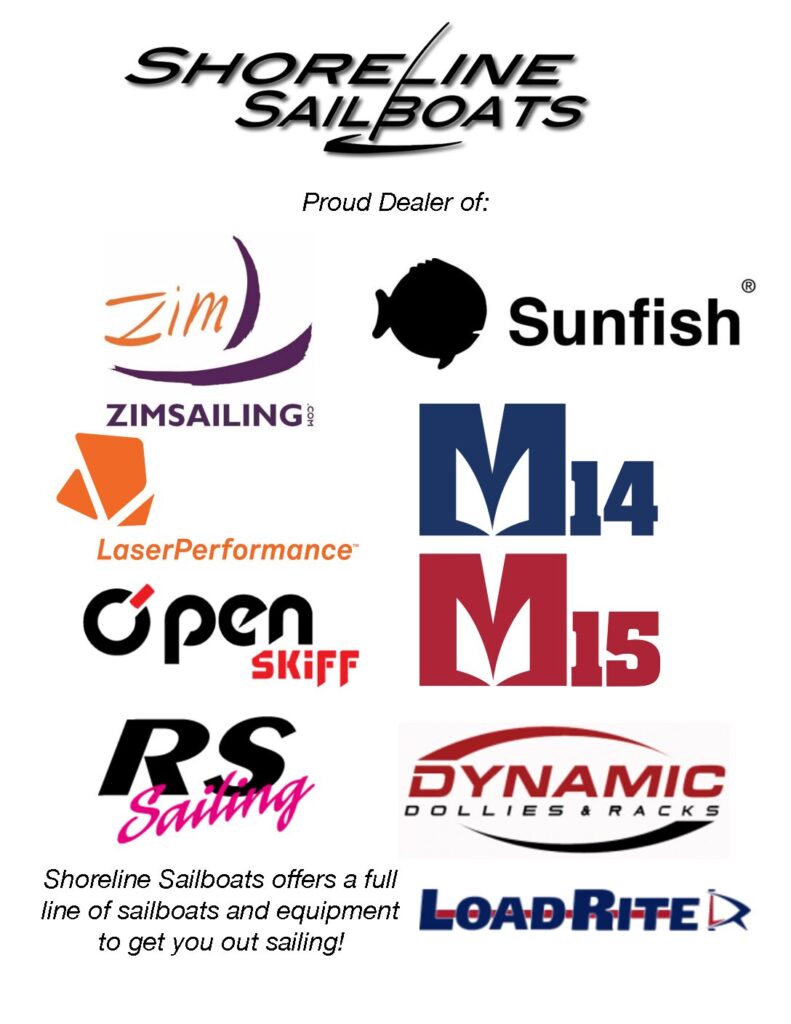
THE MELGES 15!
THE ROCKET! Built in the USA
SUNFISH – SAIL A CLASSIC!
Recent Posts

Hours & Info
Search products.
Contact us:
Any questions about the sailboats we sell, or the services we provide? We’re always eager to talk sailing and would enjoy helping you with any of your sailing needs. Contact Us
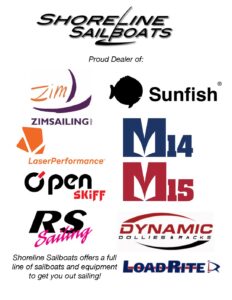
Designed by WPZOOM
International Laser Class Association
One Boat, One Sailor, One Design.

Introduction to Laser Sailing
by Jon Emmett
The Laser is truly the boat for all ages from our Junior 4.7s to our legendary (over 75 year old) Masters. No other adult class is raced in more countries in the World, in a class which takes grass roots to Olympic sailors. Come and join us to see why!
Not only are there nearly 215, 000 boats out there at the time of writing, but there is truly something for everyone in a combined class which covers the competitive weight range for nearly everyone from junior to adult, although it is not just about racing. Lasers form a key part of many sailing holiday fleets for people who just want to blast or potter around for fun.
Many of the world’s best sailors, difficult to mention them all, have come through the Laser rank. It seems like medalling in an international Laser event means you are likely to be able to medal in future classes as Laser sailors go on to compete in nearly every aspect of the sport. Ben Ainslie, Iain Percy, Paul Goodison, Robert Scheidt, Francesco Bruni, Tom Slingsby are probably the best known, and with so many to choose from it is hard to know where to start. Behind them, there is a whole host of talent with the level just getting higher and higher.
Photo by Jon Emmett
The inspiration for a young sailor joining the fleet is there for all to see. Yet for the Masters, the competition is in a way no less fierce and keeping active in older age is recommended on so many levels. After all, Laser sailing has been compared to cycling, so it certainly keeps testing you both physically and mentally, and the Masters’ European circuit continues to go from strength to strength.
The core skills you learn in Lasers: the starting, the tactics, and the fitness lifestyle are for life, not to mention the ability to surf downwind whilst within Rule 42, and navigate every type of wave upwind in a non-planing boat. We are always learning, and this is the reason the Laser remains as popular today as when it was first launched as a beach boat in 1969.
It is not only about having a rig for every weight but competition for every level. Of course, this varies from region to region. Another beauty of the Laser is the ability to jump on a plane and charter a boat when you get to the regatta. Due to the class’s numbers, there is no other class where this option is so widely available.
So, whether your aim is simply to have fun on those warm sunny days when the wind allows you to plane freely without getting blown off the water, or you have the Olympics firmly set in sight, there are step-by-step routes to success.
Club sailing: There are very few dinghy clubs anywhere in the world without a Laser or two, meaning that fleet racing is possible. This really is the true test of skill, racing against someone in an identical boat. Whilst handicap racing has its place and means, we can race our friends who are of very different body weights or sail very different boats, this is a far from perfect system because an overpowered boat will always tend to do well in light winds and an underpowered boat do well in strong winds, especially if it has a trapeze and can plane upwind!
Europa Cups are not only for European sailors. Indeed, we see many sailors from all over the world attend these and they make an excellent stepping stone to other international events. More and more, the other regions are having their own circuits of events.
Europeans: In recent years, probably the greatest depth of competition has been found in the European region, meaning those from other regions will travel to participate not only in the EurOlym regattas (Olympic class events in Europe) with world class venues such as Garda, Medemblik, Kiel, as well as the European Championships (and Open Trophy) themselves. For example, in Asia we have the Asian Games, in America the Pan-American Games.
For more information please see http://www.eurilca.eu/
However other regions are working hard to catch up.
Some useful links: Europe http://eurilca.org/
Asia http://www.asiansailing.org/
North America www.laser.org/
Australia http://www.lasersdownunder.com/
Worlds: For some, just qualifying for the Senior Worlds is a massive task, with the level going up and up and up. However, Laser sailing really does have World Championships for everyone with Junior (4.7), Youth, Under 21, and of course the other end of the scale, Masters’ Worlds! For more information please see http://www.laserinternational.org/
Perhaps the biggest Worlds is the Sailing World Championships run by World Sailing every 4 years, which features all Olympic classes, and sitting roughly in the middle of the Olympic cycle is the major country qualifier for the Olympics.
World Cups: Being an Olympic class, both the top Laser and Radial sailors will do the invitation only World Cup Series, which also forms a very important part of the World Sailing ranking (as these World Cup events generate a lot of ranking points). The circuit currently visits Asia, North America, Europe with a final, for an even further reduced number of sailors counting all three events. For more information, please see http://www.sailing.org/ .
Jon Emmett is an Olympic Gold medal-winning coach, guiding Lijia Xu from China to Gold in the Laser Radial class at the 2012 Olympic Games in London. He also sails competitively himself in worldwide regattas when he has the time. Check out his Facebook page, Jon Emmett Sailing, where he posts his latest training videos: https://www.facebook.com/jonemmettsailing/
Great choice! Your favorites are temporarily saved for this session. Sign in to save them permanently, access them on any device, and receive relevant alerts.
- Sailboat Guide
Laser (International)
Laser (International) is a 13 ′ 8 ″ / 4.2 m monohull sailboat designed by Bruce Kirby and Ian Bruce and built by Performance Sailcraft and LaserPerformance starting in 1970.

Rig and Sails
Auxilary power, accomodations, calculations.
The theoretical maximum speed that a displacement hull can move efficiently through the water is determined by it's waterline length and displacement. It may be unable to reach this speed if the boat is underpowered or heavily loaded, though it may exceed this speed given enough power. Read more.
Classic hull speed formula:
Hull Speed = 1.34 x √LWL
Max Speed/Length ratio = 8.26 ÷ Displacement/Length ratio .311 Hull Speed = Max Speed/Length ratio x √LWL
Sail Area / Displacement Ratio
A measure of the power of the sails relative to the weight of the boat. The higher the number, the higher the performance, but the harder the boat will be to handle. This ratio is a "non-dimensional" value that facilitates comparisons between boats of different types and sizes. Read more.
SA/D = SA ÷ (D ÷ 64) 2/3
- SA : Sail area in square feet, derived by adding the mainsail area to 100% of the foretriangle area (the lateral area above the deck between the mast and the forestay).
- D : Displacement in pounds.
Ballast / Displacement Ratio
A measure of the stability of a boat's hull that suggests how well a monohull will stand up to its sails. The ballast displacement ratio indicates how much of the weight of a boat is placed for maximum stability against capsizing and is an indicator of stiffness and resistance to capsize.
Ballast / Displacement * 100
Displacement / Length Ratio
A measure of the weight of the boat relative to it's length at the waterline. The higher a boat’s D/L ratio, the more easily it will carry a load and the more comfortable its motion will be. The lower a boat's ratio is, the less power it takes to drive the boat to its nominal hull speed or beyond. Read more.
D/L = (D ÷ 2240) ÷ (0.01 x LWL)³
- D: Displacement of the boat in pounds.
- LWL: Waterline length in feet
Comfort Ratio
This ratio assess how quickly and abruptly a boat’s hull reacts to waves in a significant seaway, these being the elements of a boat’s motion most likely to cause seasickness. Read more.
Comfort ratio = D ÷ (.65 x (.7 LWL + .3 LOA) x Beam 1.33 )
- D: Displacement of the boat in pounds
- LOA: Length overall in feet
- Beam: Width of boat at the widest point in feet
Capsize Screening Formula
This formula attempts to indicate whether a given boat might be too wide and light to readily right itself after being overturned in extreme conditions. Read more.
CSV = Beam ÷ ³√(D / 64)
First selected as Olympic class in 1996.
Embed this page on your own website by copying and pasting this code.
- About Sailboat Guide
©2024 Sea Time Tech, LLC
This site is protected by reCAPTCHA and the Google Privacy Policy and Terms of Service apply.
- Sailing Jackets
- Sailing Trousers
- Sailing Shorts
- Fleeces & Midlayers
- Sweatshirts & Tops
- T-Shirts & Polos
- Spraytops & Smocks
- Dinghy Boots
- Buoyancy Aids
- Dinghy Gloves
- Dinghy Headwear
- Sailing Boots
- Deck Runners
- Footwear Care
- Changing Robes
- Swimming Gloves
- Swimming Socks
- Swimming Goggles
- Safety Buoys
- Changing Mats
- Victorinox Swiss Army
- Clothing Care
- Flasks & Sports Bottles
- Sea Sickness Aids
- Paddleboarding
- Water Toys & Towables
- Clocks & Barometers
- Model Boats
- Brass Bells
- Clothing Gifts
- Miscellaneous
- Clothing Specials
- Clothing Clearance
- Lifejackets
- Lifejackets Accessories & Re Arm Kits
- EPIRBs & PLBs
- Lifebuoys & Liferafts
- Safety Accessories
- Winch Handles
- Tillers & Extensions
- Cleats & Clutches
- Wind Indicators
- Topper Hardware
- Topaz Boats Hardware
- ILCA / Laser Hardware
- Optimist Hardware
- All Dinghies
- Epoxy & Fillers
- Cleaning Products
- Bilge Pumps
- Dehumidifiers
- Stain Removers
- Water Treatment
- Shackles & Stainless Steel Fittings
- Navigation Lights
- Deck Equipment
- Inspection Hatches
- Pilots & Sailing Directions
- Charts & Navigation
- Instructional Reading
- Knots & Rope Work
- Technical Books
- Dinghy Books
- Bunkside Reading
- Kids Reading
- Topside Paint
- Paint Accessories
- Race Compasses
- Anemometers
- Shore Power
- Torches & Head Torches
- NKE Marine Electronics
- Gift Vouchers
- Sailing Dinghies
- Outboard Engines
- Electric Outboards
- Inflatable Dinghies
- Lubricants & Engine Oil
- Fuel Treatment
- Outboard Accessories
- Gift Voucher
- End of Season Boat Sale

- Fleeces & Midlayers
- Sweatshirts & Tops
- T-Shirts & Polos
- Spraytops & Smocks
- Flasks & Sports Bottles
- Water Toys & Towables
- Clocks & Barometers
- Lifejackets Accessories & Re Arm Kits
- EPIRBs & PLBs
- Lifebuoys & Liferafts
- Tillers & Extensions
- Cleats & Clutches
- Epoxy & Fillers
- Shackles & Stainless Steel Fittings
- Pilots & Sailing Directions
- Charts & Navigation
- Knots & Rope Work
- Torches & Head Torches
Which Laser sail is best for me, and what are they made from?

What is a Laser Dinghy?
A laser is a single - handed ILCA dinghy which is 4.2m in length and weighs 56.7kgs. It is one of the most popular single - handed dinghies in the world due to its simplicity and affordability. This class is protected by the strict one-design class rules which ensures no changes are allowed to be made to the boat unless they are specifically mentioned in the class rules. The laser is an Olympic class boat which first made an appearance in Atlanta in 1996. The class ensures the one - design rules allow sailors to excel based on their ability to sail the boat, not the condition of the sails etc. This one design rule means that if a laser hull is maintained the resale value of a laser remains very high.
The laser has a standard hull design with three different types of sails. This allows sailors to progress depending on their ability and weight and height, making it a boat that can be sailed for many many years by all ages. These rigs are known as ILCA 4, ILCA 6, ILCA 7 or otherwise more commonly known as 4.7, radial and standard rig.
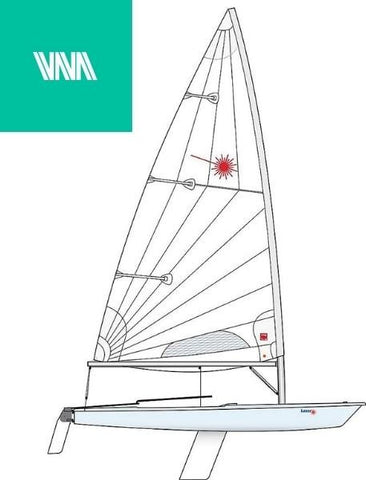
Which Laser rig is best suited for me?
The laser has a two part mast, allowing for interchangeable bottom sections as well as a sleeved sail which allows for easy rigging. This is unlike other dinghies which require extensive preparation in relation to rig set up.
The Laser 4.7 (ILCA 4) sail uses a short pre-bent lower section which in turn reduces the sail area by 35% compared to the standard rig. This creates a more balanced helm which compensates for the fact the sailor is lighter than a standard rig helm. This allows helms to learn the basics of sailing as a beginner and also provides sailors with a boat to transition into after smaller dinghies such as an optimist. This rig is ideal for lighter weighted sailors 35-55kg. This is also an ideal rig for a beginner who struggles to control a Laser Radial rig.
The Laser radial (ILCA 6) sail uses a more flexible, slightly shorter lower section compared to the standard rig. The sail area is 18% smaller than the standard making it easy to manoeuvre. The laser radial is by far the most common sail configuration which is used worldwide by over 200,000 sailors across 140 countries making it the most popular youth and single handed dinghy. This rig is used by the Olympic federation as the rig choice for women competing. It is the perfect rig for a 55-70kg sailor.
The Laser standard (ILCA 7) sail and rigging or otherwise known as a ‘full rig’ is ideally set up for heavier weighted people due to the increased sail area. This rig is the preferred choice for men competing in the Olympics. This sail requires a Standard bottom section which differs from the radial bottom section. This rig is suitable for sailors above 60kgs.
How can I tell the difference between the sails by looking at them?
These rigs are clearly identifiable looking at the Laser. The Laser 4.7 has a smaller sail area which is visible at the end of the boom as it is shorter than the other sails. The Laser radial has a blue patch at the clue and tack of the sail. This sail goes to the end of the boom unlike the 4.7 rig. Similarly, the standard rig extends to the end of the boom however, it does not have the blue patches on the sail like the radial.
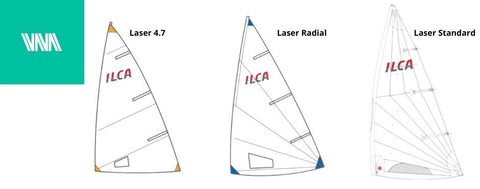
What is the new Laser Standard Sail design like?
In 2018, a new standard sail was ILCA approved which is referred to as ‘Mark II’ or ‘Mark 2’. There is no difference in size between the Mark I and Mark II however, the Mark 1 has horizontal cut panels compared to the Mark II which has radial cut panels. The Mark II sails also require Mark II battens rather then the Mark I battens . The Laser Class Association was determined to ensure the integrity and quality of the Mark I was not overshadowed by the new Mark II. They did this by creating the Mark II which focuses solely on durability. Therefore, the main difference between the two sails is durability. Clive Humphris, the ILCA Technical Officer is quoted in the class magazine as saying "The main objective of the design project for the Mark II was to create a sail with equal performance to the existing sail, but with better durability. We worked very hard to ensure that the Mark II was not a faster sail and wouldn't make all the existing sails obsolete overnight. The original Laser standard sail will continue to be available through authorized Laser dealers and we fully expect to see the two designs racing side-by-side for a number of years."
The new Mark II sail is made from a heavier cloth from 3.8 to 4.5 dacron material. There has been a change in the reinforcement patches which increases durability and maintains a better sail shape when under pressure. The window is noticeably bigger, as well as improved tapered battens with velcro batten pockets. The mast sleeve has been improved which reduces the amount of creases along the sail. The Laser Class Association successfully created a newer model sail for the Laser Radial without hampering the one design class which focuses on the condition of the boat, not the additional moving parts that can cause a substantial benefit to your racing.
What sail is best suited for me?
There are three types of Laser sails, Official Class Legal Sails, Class Compliant Sails and Training Sails.
Official Class Legal Sails - These sails are class compliant and are required for International and National events. There is a red button on these sails demonstrating that the supplier LaserPerformance has paid a contribution to the Laser class association. This allows them to be considered ILCA approved. These sails have 6 sail numbers on both sides with the first two numbers being red and the latter 4 coloured black.
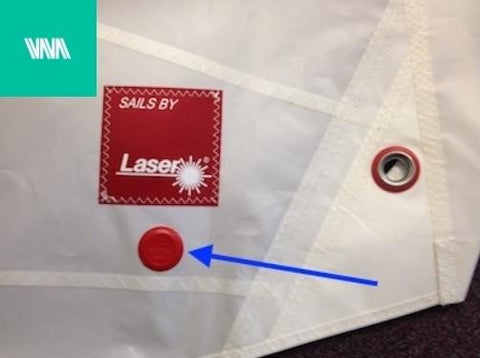
Class Compliant Sails - These sails are ideal for training camps or non class events. They are a higher standard than a training sail which provides a good basis for training and events with lesser importance. This sail has 6 sail numbers on both sides with the first two numbers being red and the latter 4 coloured black.
Training sails - These sails are made from a thinner material which reflect the cheaper price. They are ideal for sailors that are starting out and need a sail to compete in club races and training. This sail has 6 sail numbers on both sides with the first two numbers being red and the latter 4 coloured black.
Leave a comment
Please note, comments must be approved before they are published
- AROUND THE SAILING WORLD
- BOAT OF THE YEAR
- Email Newsletters
- America’s Cup
- St. Petersburg
- Caribbean Championship
- Boating Safety

Laser SB3: Review
- By Chuck Allen
- Updated: December 13, 2007
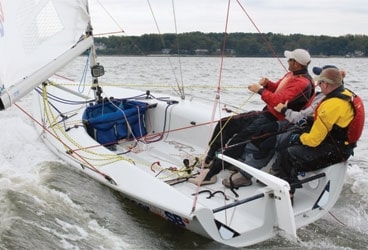
LaserSB3REview368
I’ve tested many sailboats while involved with Sailing World’s Boat of the Year program and one of the coolest I’ve ever encountered is the Laser SB3. The absolute simplicity of this boat is amazing. Upwind it locks into a groove, which in most boats you have to fight to maintain. Downwind is a dream; the SB3 is an incredibly stable platform with remarkable speed. Since its introduction in Europe in 2004, the SB3 has experienced tremendous growth, with more than 400 boats built. Two reasons for its popularity are that the boat has been designed to be sailed legs-in and all the controls are at the crew’s fingertips. Another key feature is that it can be rigged and launched in 45 minutes. The mast is light enough to make raising it a two-man job, allowing the third, and possibly fourth crewmember to rig the rest of the boat. The T-bulb keel, which is raised and lowered by an included, removable gantry, makes launching and hauling painless. As the boat only weighs 1,309 pounds, a mid-sized car can tow it. We sailed the SB3 twice, in 2 to 7 knots of breeze, and again in 25. Both times the SB3 found its groove easily and we found it nearly impossible to unintentionally slow down or fall off a plane. We tested moving our weight around, with the boat responding as expected. Light air and flat water required moving the crew forward and sitting close together, while in breeze and chop we moved aft. The boat sailed best in the light stuff with a lot of twist, and the long throw of the traveler made this easy; you can pull the car well to windward while easing the mainsheet for power. It was the exact opposite when the breeze was up; vang on, find the correct mainsheet tension and play the traveler up and down to control the angle of heel while maintaining good drive forward. All the controls are easily within reach and if someone needed to jump in to adjust a line, it wasn’t a big deal. You think the boat is going to tip over like a dinghy, but the high-aspect keel underneath keeps it on its feet. The boat has a great feeling upwind and because of the flared gunwales, is relatively dry.Downwind is an absolute blast; simply put, the SB3 rips! During our high-wind test we sailed consistently at around 15 to 18 knots of boatspeed. I would think when setting the 495-square foot kite at the offset in big fleets you would need to stay high, so easing the vang is a smart idea. When the kite reaches the sheave, it’s take-off time. Weight aft near the foot straps is the place to be. When driving in breeze, the helmsman is butted up against the backstay, the kite trimmer next forward (using the foot straps), and the bow person is the furthest forward, watching the vang while pumping the main. It’s quite obvious when a puff hits that you need to bear down a bit. Once you do so, the boatspeed jumps a couple of knots. A breeze spotter is the way to go, and can make a huge difference in one-design racing in a boat like this. Jibing is simple, especially with the long pole and high-clewed gennaker. I found the easiest way is to start the jibe slowly, wait until the clew got just past the centerline, and finish on the stronger side, coming out fully powered up. By starting slowly it also gives the crew some time to locate their position on the opposite side of the boat before take off. Sets and takedowns are very simple; there’s an enormous launching bag at the forward edge of the cockpit. Takedowns require a quick turn downwind to help the bow person get the kite in the boat completely. Overall, downwind sailing in the SB3 will be some of the best sailing you’ll ever do. The SB3 hull laminate is epoxy with a foam core, and there’s an internal frame and bulkheads providing strength and rigidity. The mast is an aluminum deck-stepped Proctor Selden rig with double spreaders. The boom, also by Proctor Selden, is aluminum as well, but the retractable pole is carbon fiber. The boat is mostly Harken equipped, with gear from the Carbo Block and Hexaratchet range. A Spinlock halyard cleating system offers easy lock and release even under load. The rudder is epoxy and core with carbon reinforcement, and the high-aspect ratio keel is based on a stainless steel main member with an epoxy, foam core, polyester skin, and a 770-pound lead bulb.The best thing the SB3 class has done is put a tight rein on its rules. The boats come complete from bow to stern and you cannot change anything. This ensures tight racing and keeps running costs down. One potential cost issue could be sail purchasing, which is unlimited [but sails are only available from Hyde Sails through Laser]. In Europe the top sailors are showing up with new sails for each big event. Otherwise, you are looking at a $39,000 program (includes sails, trailer, and a TackTick system), which seems high at first, but when you look at comparable boats and their costs, it’s right in line, if not better. The SB3 was clearly the best boat we sailed this year; if not the best boat we have sailed in all our BOTY years. With the buzz over the SB3 in Europe, it seems poised to take the U.S. market by storm. If you get the chance to take one for a sail, go for it; you’ll quickly see why we named the SB3 as our top choice.
For SW ‘s complete 2008 Boat of the Year coverage, click here
- More: Sailboats
- More Sailboats

Nautor Swan Has A New Pocket Rocket

Pogo Launches its Latest Coastal Rocket

A Deeper Dive Into the Storm 18

2024 Boat of the Year Best Recreational Racer: Z24

Luna Rossa’s New AC75 Marks Its Silver Age

Emirates Team New Zealand Splashes Defense Yacht

Wanderers of the Wayfarer Dinghy

Alinghi Red Bull Racing First to Reveal Its AC75

- Digital Edition
- Customer Service
- Privacy Policy
- Cruising World
- Sailing World
- Salt Water Sportsman
- Sport Fishing
- Wakeboarding
The story of the former Olympian who designed the world’s most beloved boat
In 1970, Bruce Kirby created the perfect single-person sailboat. What made the Laser so unbeatable?
By Andrew Blum | Published May 6, 2019 9:30 PM EDT
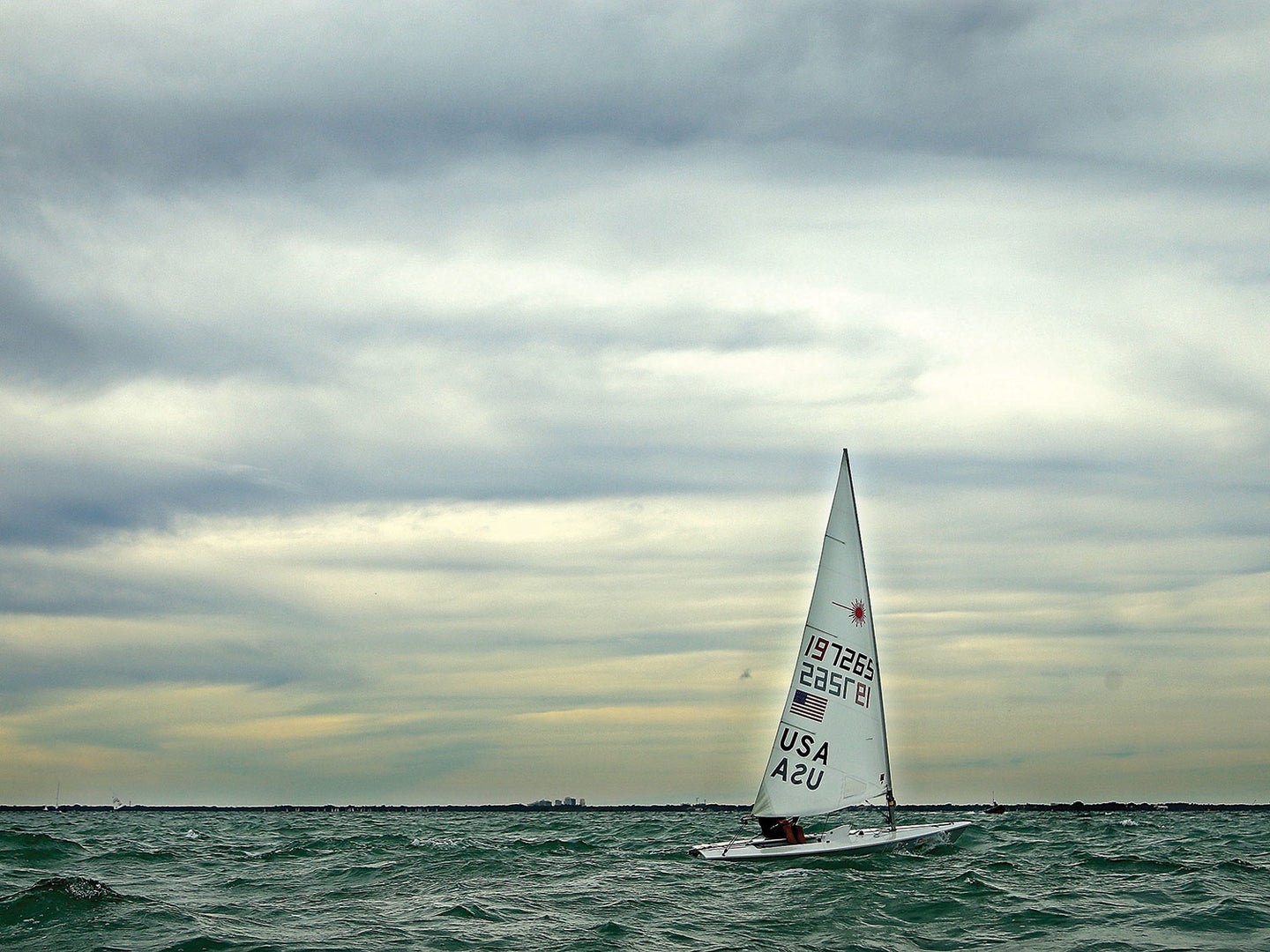
On a slate-gray day in September, 89-year-old Bruce Kirby leans against the pinstriped first-mate’s seat of Lulu as it motors in slow circles on Long Island Sound. Just outside the elegantly varnished cockpit, a fleet of small sailboats races by, its formation loose and shifting. Kirby follows the boats through a pair of binoculars. One, Jack , belongs to him; he’d be out there competing if it weren’t for his ailing back. But all of the boats are Kirby’s design.
Known as Sonars, Kirby drew their shape in 1979 with a day just like this in mind. The Noroton Yacht Club , Kirby’s home port in the suburban town of Darien, Connecticut, wanted a craft for its members to race—something nimble and fast, but also sturdy and well-behaved. The Sonar is a “one-design boat,” meaning its specifications and equipment are governed by strict rules to ensure that competing in one is a test of skill, not money. Sailing remains a sport of the wealthy, and left unchecked, they can take things to extremes. The superyachts of the America’s Cup have nine-figure R&D budgets, and crews who wear crash helmets and body armor to protect themselves at new limits of speed and performance. In contrast, a used Sonar can be had for under $10,000, and is stable enough that it’s been used by Paralympians since the 2000 games. Out on the sound that afternoon, 37 boats are vying for the Sonar North American Championship, with a few former Olympians among the skippers. The whole event is buoyed by Kirby’s presence.
Kirby is a world-class sailor and Olympian himself—he represented Canada in ’56, ’64, and ’68—but he is most famous as the designer of a slew of boats known for their swiftness, and also their clarity and simplicity. The epitome of his ethos was a blockbuster, one that defined his career and the course of sailing more broadly: the single-person racing dinghy known as the Laser.
Back on land, Kirby looks on as the competitors come off the water, windblown and skipping toward the toilets. A collision left one Sonar with a dinner-plate-size hole in its stern, and Kirby leans in for a closer look. The regatta’s press person asks him to do it again for the camera. During the awards ceremony, organizers call Kirby up to the stage for pictures with the winners, and the photographer makes everyone take off their shades, “except the rock star; he can leave his on.” The teasing is apt; among sailors, there are few bigger celebrities than Bruce Kirby. He comes by their affection honestly. His boats are a blast. “Who wants to design a slow boat?” Kirby likes to ask. “Or own one, for that matter.”
The wheel was a Neolithic invention. It appeared on the scene 5,000 or so years ago, part of a suite of advancements in agriculture. Sailboats came earlier. Australia was settled at least 50,000 years ago, and the first humans didn’t arrive on the continent by foot. Three thousand years ago, Odysseus himself was “sailing the winedark sea for ports of call on alien shores.” Christopher Columbus crossed the Atlantic, by sail, in 1492—marking the start of several hundred eventful years of wind-powered global travel. Only in the past 200 years have the steamship, internal-combustion engine, and jetliner erased the sailing ship’s primacy as a means of transportation. Sailboats themselves, however, have held on, not as necessity but as sport.

No surprise then that in 1969, when Bruce Kirby got a call from his friend, the Montreal-based industrial designer Ian Bruce, about drafting a new sailboat, the brief was for a piece of recreational equipment—a “car-topper” to go along with a line of outdoor gear (tents, cots, camping chairs) for the Hudson’s Bay Company retail chain. “I didn’t even know what a car-topper was,” Kirby recalls. The craft had to be easy to transport and rig in order to make it as painless as possible to get out on the water.
The dinghy wasn’t the first boat Kirby had dreamed up, but he wasn’t designing them full time. He was working as an editor at a sailing magazine, living (like now) on the Connecticut shore. As a designer, he was self-taught, nicking a copy of Skene’s Elements of Yacht Design , originally published in 1904, from a family friend and understanding, he estimates, about a third of it. But Kirby had “three-dimensional eyeballs,” as he describes it; he had no trouble envisioning the shape of a hull. And as a world-class racer of small boats, he knew what a fast one should feel like.
Kirby sketched on ruled paper as they talked. When they hung up, he brought it to his 7-foot drawing board and began to tinker. He knew he had to “get the numbers right.” His first consideration was what’s known as the prismatic coefficient, which defines the shape of the vessel. Is it a tub or a knife? Or, in the language of yacht design, is the hull “full” or “fine”? A rectangular barge has a prismatic coefficient of 1 because its hull entirely fills the prism made by its length, beam (or width), and draft (its depth). Most sailboats have a coefficient between 0.5 and 0.6, meaning about half that volume. If the prismatic coefficient is too high—if the boat is too fat—it will be slow, especially in light wind. But if the coefficient is too low—if the boat is too skinny—it will slice through the waves rather than ride up on top of them, or “plane.” A sailboat that planes well is fast, but more important, it’s fun. High up out of the water, wind and sail become more than the sum of their parts. Kirby settled on 0.55, a just-right number to make a well-balanced boat: fast but stable, neither too tippy nor too tubby.
But only if the sailor worked for it. Dinghies depend on “live ballast,” i.e., a person leaning, or “hiking,” out over the side. A big sail makes a boat zip, if its sailor can keep it flat. Basic physics says that their ability to do so depends on their weight, which of course varies from person to person. So, Kirby had a second number to choose: the ratio of sail size to the hull’s displacement, which depends on the weight of the boat plus its human. Kirby dialed in his dinghy to perform best with 180 pounds of flesh—in his words, “a good-size guy working like hell to go fast.” The decision was in part selfish; it described Kirby at the time.
Within a couple of weeks, Kirby had a sketch for Bruce. “He was in a bit of a hurry,” Kirby says. When Hudson’s Bay decided against selling a boat at all, Kirby told Bruce to hold on to the design: “I put a little more oomph in the boat than you asked for. It’s going to be a pretty hot little boat if we ever have a chance to build it.”
The chance came soon enough. In October 1970, Kirby’s magazine planned a promotional regatta for sailboats that cost less than $1,000, to be held at the Playboy Club in Lake Geneva, Wisconsin. Kirby and Bruce built a prototype of the car-topper and rigged it for the first time the day of the race. They came in second place. The bend of the mast didn’t match the shape of the sail, so they recut the cloth that night and won the next day’s contest. The little boat was fast and looked it, with a low profile that kept sailors close to the water. Spectators tried to buy it right off the beach.

Racing the wind
Back home, the friends began work on a second prototype, mailing plans back and forth across the border. They built it with an adjustable mast so they could play with different configurations. By December, it was ready for final testing. Doing laps on Lake Saint-Louis near Montreal, they moved the mast forward a few inches, cut its height, and took a foot off the end of the boom, looking for just the right feel. By the end of the cold weekend, they decided their hot little dinghy—13 feet, 10½ inches long—was ready for market. All it needed was a name. At a celebratory dinner, a sailing friend—a McGill University student—suggested it should be something youthful and international. “Why don’t you call it something like ‘Laser’?” he asked.
Ian Bruce had a small boatbuilding shop, and the men decided that he would manufacture the dinghy, while Kirby would receive royalties for the design. Bruce priced it at $695. At the New York Boat Show the next month, they collected orders for 144 Lasers. “We didn’t know what the hell was happening,” Kirby recalls.
There were societal factors at play. Postwar prosperity and the construction of new highways led to a boom in second-home ownership in the 1960s and ’70s. Many of those new residences were along lakes and reservoirs, and there were more of those too: Between 1933 and 1968, the Tennessee Valley Authority created more than 10,000 miles of new shoreline, while the Bureau of Land Management created 200 reservoirs. A new swath of the middle class could afford a lake house and, apparently, were ready for an inexpensive sailboat to go with it.
As intended, the Laser was cheap and easy to transport, rig, and bang into a dock. “From a technology standpoint, it’s a very simple boat, and just a great, great boat to learn how to sail fast,” says Scott MacLeod, a sailor at the Noroton Yacht Club who twice won the North American collegiate Singlehanded Championship in a Laser—1983 and 1985—and topped out at seventh place in the Worlds.
Laser sailors first organized themselves into an international class in 1974, codifying Kirby’s design into strictly defined specs, and setting the craft on a path toward the Olympics, where it debuted in Atlanta in 1996. In the ’80s, the introduction of a smaller sail, known as the Radial, allowed lighter sailors to be competitive in heavy winds, and became the standard for women’s Laser racing. The sport of sailing is said to be in perpetual decline, but Laser racing has persisted. The 2018 Laser Masters World Championships, held in Dún Laoghaire, Ireland, had 302 entries from 25 countries. (The apogee was the 1980 Laser Worlds, in Kingston, Ontario, a legendary event with 350 entries.) But there are also thousands of smaller weekend regattas, held everywhere from Sheepshead Bay in Brooklyn, New York, to the Victoria Nyanza Sailing Club in Kampala, Uganda.

All told, more than 220,000 Lasers have been built by licensed manufacturers on five continents. (Ian Bruce sold his boatbuilding business in the 1980s. He died in 2016.) With the exception of alternative rigs with smaller sails, like the Radial, the Laser has hardly changed. There have been slight upgrades, each one documented and approved in a “construction manual” maintained by the International Laser Class Association, a kind of worldwide club of Laser sailors. Each Laser factory is audited for conformity.
“Because it’s such a one-design boat, it really comes down to the sailor,” says Sarah Douglas, a contender for the Canadian 2020 Olympic sailing team who recently came in sixth at the Laser Worlds. “It’s not equipment differences or sail differences; it comes down to what the sailor is able to do out on the water,” she says. “At the end of the day, you can’t blame your boat. It’s just you. It is all you.”
For decades, Kirby and his wife, Margo, lived in a house on Connecticut’s little Five Mile River, just upstream from where it empties into Long Island Sound. It had a deepwater dock out the back, and Kirby’s Laser—sail number 0—was laid out on the lawn. (It’s now at the Mystic Seaport Museum .) But recently they moved a few blocks away, to a more modest Colonial with a two-car garage. There are still moving boxes to unpack, yet the walls are already hung with old photos of Kirby sailing his designs, and boat models known as half hulls mounted on plaques. The Laser gets pride of place. Next to the front door, there’s a framed action shot of the “hot little boat” at its best: in the sail position known as a reach, with spray skirting off the bow as if it had a jet engine underneath.
The Laser’s simplicity makes it something like the platonic ideal of a sailboat, like a child’s drawing with a line and a triangle—but enabled by the postwar innovations of fiberglass (for its hull), aluminum (for its mast), and Dacron (for its sail). It is the sort of definitive and lasting design that comes around only rarely, such as the iPhone or five-pocket bluejeans. Except bluejeans and iPhones are constantly being tweaked, evolving along with human taste or ingenuity. Each change widens the aperture of possibility. The object does a new thing, looks a new way, or serves a new purpose.
But a Laser is a sailboat. It moves by the power of the wind along the surface of the water, a function that hasn’t changed in millennia. Granted, Lasers rarely go anywhere, except in circles. They satisfy a basic human desire for speed and competition, each high on the hierarchy of pleasures. It’s all the more remarkable, then, that among innumerable variations of small sailboats over all time, the precise design of the Laser has ridden up on the wave of history, and stayed there, for 50 years—and counting.
This article was originally published in the Spring 2019 Transportation issue of Popular Science.
Like science, tech, and DIY projects?
Sign up to receive Popular Science's emails and get the highlights.

Step-by-Step Guide: Learn How to Rig a Laser Sailboat for Optimal Performance
Alex Morgan
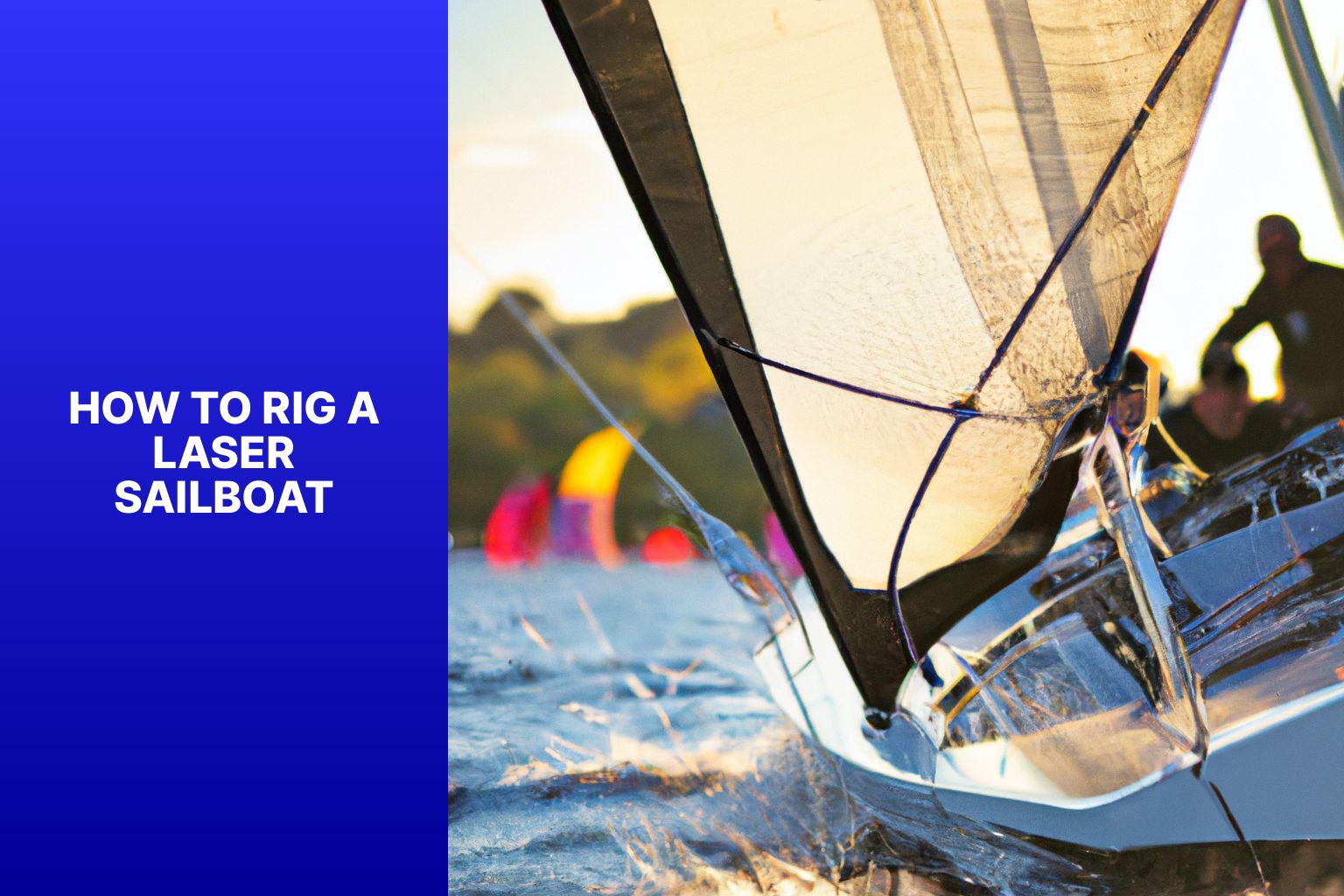
Rigging a Laser sailboat is an essential skill for anyone interested in sailing. Properly rigging a sailboat ensures that all components are securely in place, allowing for a safe and enjoyable sailing experience. This article will provide an introduction to rigging a Laser sailboat, explain the different components involved, and provide a step-by-step guide on how to rig the boat. It will offer tips and best practices to follow while rigging, as well as common mistakes to avoid. Whether you are a beginner or an experienced sailor, mastering the art of rigging a Laser sailboat is crucial for a successful outing on the water.
Key takeaway:
- Rigging a Laser sailboat requires understanding its components: The mast, boom, rigging lines, and sail are essential parts of a Laser sailboat rigging process.
- Following a step-by-step guide ensures proper rigging: Stepping the mast, attaching the boom, securing the rigging lines, and hoisting and adjusting the sail are necessary steps to rig a Laser sailboat correctly.
- Avoiding common mistakes and following best practices is crucial: To rig a Laser sailboat effectively, it is important to be aware of common mistakes and implement best practices for a successful rigging experience.
Understanding the Components of a Laser Sailboat
As we dive into the world of laser sailboats , it’s crucial to understand the nuts and bolts that make up these vessels. In this section, we’ll take a look at the key components that come together to form a laser sailboat . From the sturdy mast to the versatile boom , and the intricate rigging lines to the billowing sail , we’ll navigate through each element, unraveling their significance and how they contribute to a successful sailing experience. Get ready to explore the inner workings of laser sailboats and gain a deeper appreciation for their craftsmanship.
The mast is an essential component of a Laser sailboat as it provides vital support and stability to the sail. Constructed from either lightweight and strong carbon fiber or aluminum, the mast is designed to withstand the powerful forces of wind and water.
When rigging a Laser sailboat, the first crucial step is to carefully insert the mast into the mast step located at the base of the boat’s hull. Once inserted, it is important to raise the mast upright and secure it using a mast clamp or collar for stability.
The next important task is to attach the sail to the mast. This is achieved by raising the sail and securing it using halyards or sail ties. It is vital to properly tension the sail in order to optimize performance and maintain control while sailing.
Throughout the rigging process, it is imperative to regularly check the mast for any signs of damage or wear. It is essential to promptly address any cracks or weaknesses to ensure the safety of both the boat and the sailor while out on the water.
In order to prolong the longevity and enhance the performance of the mast, regular inspections, cleaning, and lubrication of the mast fittings are necessary. This will help prevent corrosion and ensure smooth operation during sailing sessions.
The boom is a necessary part of a Laser sailboat . It is a horizontal spar that extends from the mast. This sturdy pole controls the shape and position of the sail.
Attaching the boom is a crucial step in rigging a Laser sailboat . It involves sliding one end into a fitting on the mast called the gooseneck . The boom is secured with a boom vang , a line that runs from the mast to the boom . This vang controls the tension and angle of the boom , allowing sailors to adjust the sail’s shape and power.
Properly attaching and adjusting the boom is essential for efficient sailing. It allows the sailor to control the sail’s position and shape based on wind conditions. Adjusting the boom optimizes the sail’s power and performance, maximizing speed and maneuverability.
The use of booms in sailing has a long history. It originated from the use of horizontal spars to control the shape of sails on large sailing ships. Over time, booms have become an integral part of smaller sailboats, enhancing sailing performance and control. Nowadays, booms are used in various sailboat designs, including the Laser .
Rigging Lines
To properly rig a Laser sailboat, it is important to understand the components involved, including the rigging lines. Here are the steps to follow:
1. Begin by setting up the main halyard. Attach it to the head of the sail and run it through the top of the mast.
2. Next, secure the main sheet. Attach one end to the boom and run it through the blocks on the back of the boat.
3. Connect the cunningham line. Start by attaching one end to the cunningham eyelet on the front of the mast and run it through the block on the boom.
4. Establish the vang line. Attach one end to the vang fitting on the mast and run it through the block on the boom.
5. Attach the outhaul line. Connect one end to the outhaul fitting on the boom and run it through the outhaul block on the back of the boom.
6. Secure the traveler line. Attach one end to the traveler block and run it through the block on the back of the boat.
By following these steps, you can effectively rig the rigging lines on a Laser sailboat. It is important to check the lines for wear or damage before sailing to ensure a safe and enjoyable experience.
The sail is a crucial component of the Laser sailboat. It efficiently harnesses the power of the wind and propels the boat forward. The sail is carefully constructed using durable and lightweight materials, typically synthetic fibers like Dacron or Mylar .
The sail is securely attached to both the mast and the boom, forming a triangular shape that effectively captures the wind. The size of the sail plays a significant role in the boat’s overall performance. Sails of smaller sizes are ideal for lighter winds, whereas larger sails are more effective in stronger winds.
To properly rig the sail, it is important to securely attach the boom to the mast. Then, the sail should be hoisted up the mast, ensuring correct alignment and tension. The cunningham and outhaul lines can be adjusted to control the shape and tension of the sail.
Taking proper care and maintenance of the sail is crucial for its longevity and optimal performance. Prolonged exposure to direct sunlight should be avoided, as it can cause damage to the sail. Regular inspection for wear and tear is necessary, and any necessary repairs or replacements should be made promptly.
A well-rigged sail is essential for a successful sailing experience, allowing the boat to efficiently capture the power of the wind and maneuver through the water. By familiarizing yourself with the various components and following the correct rigging procedures, you can ensure that your Laser sailboat is ready for an exciting and rewarding adventure on the water.
Step-by-Step Guide on How to Rig a Laser Sailboat
Looking to hit the waves with your Laser Sailboat ? Mastering the rigging process is key to a successful sailing experience. In this step-by-step guide , we’ll walk you through the essentials of rigging a Laser Sailboat . From stepping the mast to hoisting and adjusting the sail, we’ve got you covered. Get ready to set sail with confidence and navigate the waters like a pro !
Stepping the Mast
To properly step the mast of a Laser sailboat, you should follow these steps:
- Position the sailboat upright on a flat surface, ensuring that the bow is facing into the wind.
- Securely insert the mast into the mast step.
- Lift the mast, bringing it into a vertical position.
- Make sure to fully insert the mast into the mast step, securing it firmly.
- Attach the mast base to the mast step by tightening the mast collar or locking mechanism.
- Ensure that the mast is straight and aligned with the centerline of the boat.
- If necessary, tighten any additional mast supports or stays to secure the mast further.
- Before moving forward with rigging the sailboat, double-check all connections to ensure they are secure and stable.
By following these steps, you can guarantee that the mast is properly stepped and securely fixed, providing a strong foundation for rigging the rest of the Laser sailboat.
Attaching the Boom
To attach the boom to a Laser sailboat , follow these steps:
1. Position the boom near the mast , aligning the gooseneck with the mast slot .
2. Slide the boom all the way through the mast slot .
3. Align the holes on the boom fitting with the holes on the mast fitting .
4. Insert the boom bolt through the holes and securely fasten it with a nut if needed.
5. Check that the boom is securely attached and moves smoothly along the mast .
True story: When rigging my Laser sailboat for the first time, I struggled to align the boom fitting with the mast fitting . After a few attempts, I realized I needed to adjust the boom’s position slightly for proper alignment. Once adjusted, the boom slid into place smoothly, and I secured it with the bolt . This experience taught me the importance of attention to detail when rigging a sailboat.
Securing the Rigging Lines
To secure the rigging lines on a laser sailboat, follow these steps:
- Attach the main halyard to the head of the sail.
- Secure the Cunningham line to the front of the mast.
- Attach the outhaul line to the clew of the sail.
- Secure the downhaul line to the tack of the sail.
- Double-check the security of all the rigging lines and make any necessary adjustments for proper tension and alignment.
- Engage the cleats or other fastening mechanisms for the rigging lines to prevent slippage during sailing.
- Check all the rigging lines again to ensure they are secure and properly tensioned before launching the boat.
By securing the rigging lines on a laser sailboat, the sail will be correctly positioned and tensioned for optimal performance on the water.
Hoisting and Adjusting the Sail
In order to hoist and adjust the sail properly, ensure that the halyard is properly attached to the sail and securely fastened . Stand towards the mast and pull on the halyard to raise the sail up the mast. Continue pulling until the sail is fully hoisted to the top of the mast, making sure there are no twists or tangles.
To achieve the desired sail shape based on wind conditions and personal preference, adjust the halyard tension. You can tighten or loosen the halyard to adjust the sail shape. Tightening the halyard will flatten the sail, while loosening it will add more depth .
For different wind conditions, make small adjustments and observe how the sail responds to find the optimal setting. Once the desired sail shape is achieved, secure the halyard by tying it off or using a cleat.
Let me share a true story: One time during a race, while I was hoisting the sail on my Laser sailboat, a sudden gust of wind caught the sail and caused it to billow dramatically . Fortunately, I quickly adjusted the halyard tension and regained control of the sail. This experience taught me the importance of properly hoisting and adjusting the sail to maintain stability and control on the water.
Tips and Best Practices for Rigging a Laser Sailboat
– Start with a well-maintained boat: Check for any damages or wear and tear that may affect the rigging process.
– Properly attach the mast: Use the mast step to securely attach the mast to the boat and ensure proper alignment.
– Attach the boom: Connect the boom to the mast using the gooseneck fitting and make sure it is securely fastened and aligned.
– Attach the mainsheet: Thread the mainsheet through the mainsheet blocks and tightly secure it to the boom for proper control while sailing.
– Attach the sail: Carefully center and align the sail on the mast, securing all sail ties to prevent it from coming loose.
– Tension the rigging: Optimize sailboat performance by adjusting the rigging tension to control the sail shape and maximize speed.
– Check all fittings and lines: Before setting off, inspect all connections to ensure they are secure and in good condition, including the halyard, vang, cunningham, and outhaul.
A sailor followed all the rigging steps meticulously, resulting in a well-rigged laser sailboat that effortlessly glided through the water during a regatta. Their attention to detail paid off as they sailed to victory, impressing their competitors with their skills and precision. This experience highlights the importance of following best practices and tips for rigging a laser sailboat to achieve success on the water.
Common Mistakes to Avoid while Rigging a Laser Sailboat
When rigging a Laser sailboat, it is important to avoid common mistakes that can negatively affect performance and safety. Here are some key points to keep in mind:
1. Correct sail positioning: Make sure to hoist and tension the sail properly. Incorrect positioning can result in poor trim and reduced speed.
2. Adequate rig tension: Proper tension is crucial for optimal performance. Avoiding insufficient tension will prevent a loose sail and decrease control.
3. Mast alignment: Always align the mast with the boat’s centerline. Deviation from this alignment can affect weight distribution and stability.
4. Efficient use of controls: Take the time to familiarize yourself with the cunningham, vang, and outhaul controls. Proper use of these controls will allow for adjustments to changing conditions.
5. Regular maintenance: Regularly inspect the rigging for any signs of wear or damage. Neglecting maintenance can lead to equipment failure and compromise safety.
By avoiding these common mistakes, you will enhance your sailing experience and ensure optimal performance. Remember to practice proper rigging techniques and comply with Laser Class rules.
Some Facts About How To Rig A Laser Sailboat:
- ✅ Rigging a Laser sailboat can be overwhelming for beginners, but with practice and guidance, it becomes easier. (Source: lasersailingtips.com)
- ✅ There is no specific order to rigging a Laser sailboat, as there are many combinations and methods. (Source: lasersailingtips.com)
- ✅ It is recommended to rig up a few times at home before heading out to ensure confidence and familiarity with the process. (Source: lasersailingtips.com)
- ✅ Before heading out, it is important to check the weather forecast and pack all the necessary gear neatly. (Source: lasersailingtips.com)
- ✅ The rigging process begins by laying the boom on the deck and feeding the mainsheet rope through the blocks and eyelets on the boom and cockpit. (Source: lasersailingtips.com)
Frequently Asked Questions
Faqs on how to rig a laser sailboat, 1. how do i assemble the mast of a laser sailboat.
To assemble the mast, slide the bottom of the top half into the top of the bottom half. Then, slide the sail over the mast using the pocket along one side of the sail. Insert the battens into the sail and ensure they are secured.
2. How do I attach the boom and rig the mainsheet?
Attach the front end of the boom to the gooseneck on the mast. Then, walk around to the flapping end of the sail while holding the boom on the gooseneck. Run the outhaul rope through the eye at the end of the boom and cleat it off. Rig the mainsheet by tying one end around the eye on the bottom of the pulley at the end of the boom and running the other end through the traveler on the stern of the boat, through the pulley on the end of the boom, and down through the main block at the front of the cockpit.
3. How do I stand up the mast and attach the boom vang?
To stand up the mast, carefully lift it and place it into the mast step at the front of the laser. Use the middle of the mast for better control and walk forward while pushing the sail up. As for the boom vang, attach it to the bottom of the mast and slide it into the metal clip on the bottom of the boom. Pull down on the hanging line and cleat it off.
4. How do I attach the rudder, tiller, and daggerboard?
Attach the rudder by inserting it into place and securing it with the tiller. Make sure the lift stop clicks into place. For the daggerboard, tie a long loop of elastic to the eye at the end of the dagger board and secure it to the boat.
5. What should I pack and check before rigging a Laser sailboat?
Before rigging, check the weather forecast and pack all necessary gear, including the sail, ropes, foils, and spars. Also, ensure that the hull plug is screwed into the drain hole in the stern of the boat. Check that you have a life jacket and other personal safety equipment.
6. How should I tidy up and secure the boat before launching?
Before launching, tidy up the area and ensure the boat is secure. If needed, detach the trailer or dolly from the car and position it close to the launch area. Double-check that all gear is packed and ready. When in deep water, always put on a rash vest and googles for added protection.
About the author
Leave a Reply Cancel reply
Your email address will not be published. Required fields are marked *
Save my name, email, and website in this browser for the next time I comment.
Latest posts

The history of sailing – from ancient times to modern adventures
History of Sailing Sailing is a time-honored tradition that has evolved over millennia, from its humble beginnings as a means of transportation to a beloved modern-day recreational activity. The history of sailing is a fascinating journey that spans cultures and centuries, rich in innovation and adventure. In this article, we’ll explore the remarkable evolution of…

Sailing Solo: Adventures and Challenges of Single-Handed Sailing
Solo Sailing Sailing has always been a pursuit of freedom, adventure, and self-discovery. While sailing with a crew is a fantastic experience, there’s a unique allure to sailing solo – just you, the wind, and the open sea. Single-handed sailing, as it’s often called, is a journey of self-reliance, resilience, and the ultimate test of…

Sustainable Sailing: Eco-Friendly Practices on the boat
Eco Friendly Sailing Sailing is an exhilarating and timeless way to explore the beauty of the open water, but it’s important to remember that our oceans and environment need our protection. Sustainable sailing, which involves eco-friendly practices and mindful decision-making, allows sailors to enjoy their adventures while minimizing their impact on the environment. In this…

How Long Is A Laser Sailboat?

Last Updated by
Daniel Wade
May 22, 2023
Key Takeaways
- A Laser is an ideal boat for those wanting to dinghy race or be active on the water
- Laser boats are 13.78 feet long and some use a smaller sail depending on your weight
- The Laser hull is an excellent dinghy design with a few sail modifications
- Laser sailors are able to transport the boat on a trailer or the top of a typical car
- Laser sailing is arguably the best dinghy since it utilizes an ideal weight and boat length
Laser sailboats are a popular racing dinghy that are compact and easy to handle. But how long is a laser sailboat?
A Laser sailboat is approximately 13.78 feet long and comes in three different rigging versions depending on your sailing needs. These boats include the Laser Standard, Laser Radial, and the Laser 4.7. Each rig type still remains just under 14 feet in boat length.
After careful analysis the Laser appears to have a perfect design and great boat length to accommodate any type of sailor no matter their experience. It is estimated that over 200,000 Laser boats are in about 140 countries and makes it the most popular racing dinghy out there.
Table of contents
Differences in Laser Boats
Laser boats all remain the same boat length of 13.78 feet so there will be a level of familiarity if you were to move from one rigging type to another. Since they are a one design boat they are typically the same style but newer models might have something that the older ones do not.
The only differences will be in the rigging that you choose upon your purchase. You can see the rigging types below and how they might apply to your skill and body type.
Laser Standard - Best All Around
The Laser Standard has a 76 feet squared sail and is meant for sailors that are more athletic or have a heavier build. The skill level ranges between beginner and expert but most adults with some sailing experience will opt for this rigging type.
Laser Radial - Best for Lighter Sailors
The Laser Radial has a 62 feet squared sail and is meant for women or lighter weight sailors. The skill level ranges between beginner and expert but most that have limited experience will likely choose this one.
Laser 4.7 - Best Beginner or Youth Sailing
The Laser 4.7 has a 50.59 feet squared sail and is best of youth sailors or lighter sailors in general. The skill level still ranges between beginner and expert but this is a perfect introduction into dinghy sailing for anyone.
The Charecteristics of a Laser Boat
A Laser boat is made up of many different parts. Each part makes the boat unique and is why it is able to be around 14 feet in length. If any one of these parts are damaged or missing you will not be able to experience the Laser as it was intended to be.
Mast Section and Boom
The mast is adjustable into two different parts. One of them being the shorter lower mast section and allows you to change direction based on the wind.
The boom is similar to the mast in that it helps control the angle of the wind hitting the sail. This is located at the bottom of the sail along the footing.
Various Types of Sails
The sails are any of the three types that were mentioned above. The size of your sails will depend on your personal weight so it is important for the right balance and performance to find the sails that are accommodating to you.
Stability with Daggerboard and Rudders
The daggerboard is a keel type that enters through a slot on the hull. This is essential for a boats stability. Rudders have to be down while sailing in order to properly steer the boat.
Steering with a Tiller
The tiller allows you to steer the boat through the rudder and is necessary if you want to sail. Most Laser boat racers opt for a tiller extender so that they can control the boat while leaning over the edge for balance.
Best Tips for the Purchase of a Laser Boat
Laser sailing is a one of a kind experience on the water and not meant for simple cruising. These boat types are used in the Laser World Championships and have their own Laser class among dinghy races throughout the world. They are governed by the International Laser Class Association and races have a set of Laser class rules.
Bruce Kirby and his innovation helped sketched and designed the first Laser boat in 1970. This paved the way for a revolutionary brand.
Since the earliest models it has gained a lot of popularity among dinghy sailing. Today you can still find some original Laser Standard sail and many newer models that could fit within your budget or sailing goals.
What to Look for in a Laser Boat
You could look to purchase a Laser boats based on a variety of factors. These could be new or used but will ultimately vary depending on the desired use.
If you happen to find an older Laser boat you should give it some thought. These boats are designed with the same hull type over the years and the quality has been consistent.
Hull’s Condition
The hull needs to be in good shape no matter if it is new or used. Make sure there are not any holes or spots that are soft which would later become a hole.
The hull weight should also be around 130 pounds since that is what new Laser boats are weighing. If used you should ask the owner how they stored the boat whether on land or left at a marina in the water.
Age of Laser
Laser boats can be great if they are taken care of over time. A 1970 version will obviously look and feel much different than a 2023 model.
A lot of models have the same hull and same specifications since they are a one design boat. If applicable you can check the hull number and look it up to get an accurate representation of the boats age.
Average Cost to Expect
Laser boats range in price depending on a variety of factors. If the boat was taken care of over the years then a used version will definitely be a the best bang for your buck.
A Laser boat that is used but in good condition could vary between $2,000 and $5,000. A newer Laser boat could start around $5,000 and be as high as nearly $6,000.
It is best if you can shop around to find a great deal on a Laser boat. Since there are over 200,000 Laser boats in regulation around the world the chances of finding one at a good price near you is highly likely.
Why You Might Consider Purchasing a Laser Boat
Laser boats are a great way to be active on the water and get a feel for sailing. The best thing about it is that you can have a good time without needing a ton of experience sailing beforehand.
Ease of Transportation
These are compact boats that can be easily transported by a truck or trailer. It would be best to transport with a trailer but not everyone has that capability. Some small cars can carry these if you can figure out a safe way to transport the boat.
Different Versions and Rig Setups
They make two different hardware versions and three different rigging types. Since the design is essentially the same over the years many sailors of different experience levels can work on their sailing skills.
XD is best for sailors wanting to find performance. Race is best for those wanting to sail recreationally or for racing in clubs.
Easy to Learn Sailing Skills
If you have never sailed on a boat like this then it will take some practice. There is a slight learning curve since you need to use your body to help balance the boat while racing. They are great for anyone with a competitive spirit and that love to go fast.
Related Articles
I've personally had thousands of questions about sailing and sailboats over the years. As I learn and experience sailing, and the community, I share the answers that work and make sense to me, here on Life of Sailing.
by this author
Learn About Sailboats
Most Recent

Affordable Sailboats You Can Build at Home
September 13, 2023

Best Small Sailboat Ornaments
September 12, 2023
Important Legal Info
Lifeofsailing.com is a participant in the Amazon Services LLC Associates Program, an affiliate advertising program designed to provide a means for sites to earn advertising fees by advertising and linking to Amazon. This site also participates in other affiliate programs and is compensated for referring traffic and business to these companies.
Similar Posts

Discover the Magic of Hydrofoil Sailboats
December 11, 2023

Hunter Sailboats: Are They Built for Bluewater Cruising?
August 29, 2023

What Is A Furler On A Sailboat?
August 22, 2023
Popular Posts

Best Liveaboard Catamaran Sailboats
December 28, 2023

Can a Novice Sail Around the World?
Elizabeth O'Malley
June 15, 2022

4 Best Electric Outboard Motors

How Long Did It Take The Vikings To Sail To England?

10 Best Sailboat Brands (And Why)
December 20, 2023

7 Best Places To Liveaboard A Sailboat
Get the best sailing content.
Top Rated Posts
Lifeofsailing.com is a participant in the Amazon Services LLC Associates Program, an affiliate advertising program designed to provide a means for sites to earn advertising fees by advertising and linking to Amazon. This site also participates in other affiliate programs and is compensated for referring traffic and business to these companies. (866) 342-SAIL
© 2024 Life of Sailing Email: [email protected] Address: 11816 Inwood Rd #3024 Dallas, TX 75244 Disclaimer Privacy Policy
Better Sailing
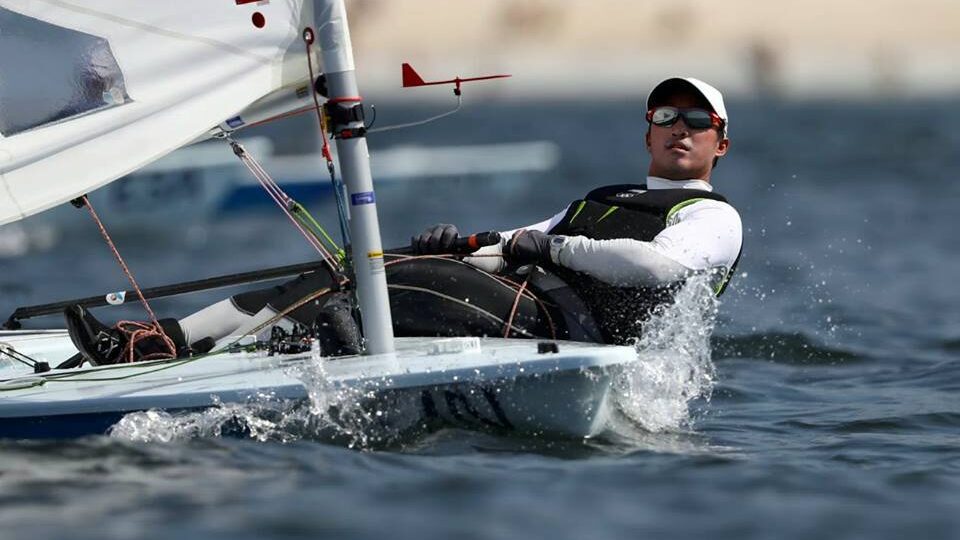
How Fast is a Laser Sailboat? Laser Sailboat Top Speed
A single-handed racing dinghy; it’s the Laser. The Laser dinghy’s most appealing feature is that it is protected by rigorous one-design class rules, which means that no changes to the boat are permitted unless it’s specified in the rules. As a result, whether a boat is brand new or ten years old, all Laser boats are nearly identical, allowing the sailor to win the race rather than the boat. The Laser is a difficult boat that rewards athleticism, sophisticated steering and trimming methods, and tactical mastery. Note that it’s a singlehanded Olympic class boat that is sailed at the club, national, and international levels by both men and women. It is the world’s most popular adult and junior racing sailboat, with over 200,000 boats in 140 nations. So, in this article, I will give information about the Laser boats as well as the speeds they can attain. So, keep reading!
The Laser Formula
The Laser Formula combines a single hull with three rigs: standard, radial, and 4.7. Young sailors who start out in the 4.7 can progress in rig size as they improve physically and tactically. They also don’t have to buy a new boat every few years. Because of the one-design protection, the Laser will never be obsolete. And, this explains why Lasers generally have high resale prices.
The Laser Formula also refers to the choice of rigs for different weights of people. It’s basically like having three boats in one. The Laser can be sailed easily in all wind conditions by modifying only the sail and lower mast. And it provides exhilarating yet controlled sailing for any sailor weighing as little as 35 kg.
So, the Laser Formula is a three-rigged sailboat that has been adopted by a number of sailing schools as a simple and cost-effective solution to keep sailing in all winds and reduce “downtime.” The Laser 4.7 has a 35 percent reduced sail area than the Laser Standard and a short pre-bent lower mast to maintain a balanced helm. It’s perfect for those learning to sail or those graduating from the Optimist class.
The next step up is the Laser Radial. It has a lower mast that is more flexible and slightly shorter, as well as a sail area that is 18% smaller than the Laser Standard. National and international regattas, as well as World Open and Youth Championships, attract as many countries and competitors as the Laser Standard Rig. The Laser Radial has large popularity among lighter weight sailors, as well as children, women, and masters racing.
Many countries now offer a comprehensive Laser Radial Youth program. The majority of national yachting authorities responded that the Laser Radial was their favorite youth boat in a study done by the International Sailing Federation. In moderate winds, any weight can sail the Laser Standard, but as the wind increases, it is better suited to heavier sailor weights. Apart from the significant second-hand market for Lasers with the Laser Standard rig, the lower mast and sails for Laser Radial and Laser 4.7 as a separate package from the hull have an even stronger second-hand market. Finally, a strong class association that actively promotes and advances Laser sailing around the world allows for mass manufacture of the Laser, lowering the cost of the boats and spares.
A Comparison of the Rigs
The Laser sailboat offers a variety of rig sizes, with the goal of making the boat sailable by a wide range of sailors and sailor weights. This happens by swapping out the lower mast section and leaving all other components the same. There are three different rig sizes now available. These are the ‘Standard,’ ‘Radial,’ and ‘4.7.’ Below is a graphic that compares the three rigs, and we’ll go through each one in detail in the next part.

Laser Standard
This is the most popular Laser rig size, as well as the one that came standard on the boat when it was built. It has a sail area of 7.06 square meters (about 76 square feet). The Laser Class approved a new ‘Standard’ sail in 2018, known as the ‘MKII’ or ‘Mark 2’ to differentiate it from the previous version. The difference is in the panels, among other things. Horizontal cut panels were used on the original ‘Standard’ sail. Note that radial cut panels are featured on the new MKII sail. Note that there is no size difference between these two variants. Moreover, all-new Laser Standard sails are now available in this upgraded version.
Keep in mind that when you look at the panels you can identify if you have a ‘Standard’ sail. It’s most likely a conventional sail if they’re horizontal. Then, you can measure the luff or the front edge of the sail along the mast sleeve. From the peak of the sail to the bottom, this measurement should be around 5130 mm or 200 inches. Note that the ‘Standard’ lower mast portion should be 2865 mm (113 inches) in length. In comparison to the two smaller mast portions, it is a rather sturdy mast section.
The Laser 4.7 (also known as the ILCA 5) is the smallest of the three Laser sails. It was firstly used for young sailors. The 4.7 lower mast part is one-of-a-kind because it features a pre-bend near the boom fitting. This makes depowering the sail considerably easier. This is the smallest Laser sail size, and if you have an ancient one, it’s unlikely it’s a 4.7 sail. The 4.7 sail has cross-cut panels, similar to the traditional ‘Standard’ sail. Many 4.7 sails also include a 4.7 logo on the material.
You can also measure the luff which is the front edge of the sail along the mast sleeve. From the peak of the sail to the bottom, this measurement should be around 4080 mm or 160 inches. Note that the lower mast part of the ‘4.7 features a pre-bend and should measure around 1810 mm (71 inches). The bend is the most obvious feature that distinguishes it from the others.
Laser Radial
The Laser ‘Radial’ sail, formerly known as the ‘M’ rig, is smaller than the ‘Standard’ sail, measuring 5.76 square meters (62 square feet). It was the only Laser sail at the time to include radial cut panels, which made de-powering the sail easier in strong gusts. Both the Standard and Radial sails have the radial cut design, as mentioned above for the ‘Standard’ rig. The blue panels at the tack and clew of the sail are another telltale sign of a Radial sail size.
Looking at the panels is the first and most obvious way to identify if you have a ‘Radial’ sail. It’s most likely a radial sail if they’re radial, as in radiating out from the center. From the peak of the sail to the bottom, this measurement should be around 4560 mm or 180 inches. Note that the lowest mast part of the ‘Radial’ should be 2262 mm (89 inches) in length. It’s also a little smaller than the usual portion in diameter.
Laser Sailing
Sailing on a laser differs significantly from sailing on other boats. There is no motor, paddle, or oars on a laser dinghy. To move your boat across the water, you must master the technique of harnessing the wind. It could be a calm breeze one day, making sailing a peaceful contact with nature. And then a violent gust the next, putting your talent in syncing your movements with the boat, the wind, and the water to the test.
The Laser dinghy is used in laser sailing, which is a popular water sport. Despite the boat’s simple design, Laser sailors and racers encounter a unique set of hurdles that necessitate specific physical abilities. Laser sailing requires a high level of fitness in order for a sailor to be able to handle the trekking and body-twisting skills that are required in sailing, particularly when sailing upwind.
Keep in mind that Laser radial sailing is often reserved for sailors of a lighter weight. The Laser Radial, as opposed to the Laser Standard, has a smaller sail and is chosen by many female laser sailors. The International Class Association, like the Laser Standard, has stringent supervision over the design. The size of the sail as well as the lower half of the mast are the only differences.
Different Wind Conditions and Laser Sailing
It’s all about getting your head out of the boat in light winds because even a small increase in wind speed results in a significant difference in boat speed. To maintain maximum water-line length, sailors place themselves well forward in the boat. In other words, their bodyweight must be just behind the centerboard. Not only is this faster, but it also gives the rudder a better feel with the bow in. In addition, it avoids the urge to produce too much leeward heel, which many people do only to obtain a greater rudder feel.
In medium winds, you just focus on the power. Meaning that you need to modify the sail controls to stay fully powered but not overpowering. This is especially crucial if you see a gradual increase or drop in wind speed during the race or course. So, it’s important that you hike “straight out.” To get the proper fore and aft trim with the waves, active body movement, or “kinetics,” is essential. Remember that if you spend most of your time leaning forward, you will most likely set too far back, and vice versa. You should spend approximately the same time for forwarding and backward body movements.
In strong winds, it’s natural to want to use as much power as possible, but this isn’t the same as making maximum upwind progress. Holding on to too much sheet will actually reduce your velocity, whereas loosening the sheet will not only maintain the boat flat. It will also assist it to accelerate in the wind rather than just heeling over and slide sideways. You may feel as if you’re pointing at the boat to leeward if you bear away somewhat. But in really strong gusts, you’re probably retaining your height better. The Laser will slip less sideways if it maintains its pace. As a result, sailing “fast and low” is frequently effective here. The most important suggestion is to maintain a steady heel angle. If the boat “staggers” upwind, it is not only slow, but it also means you are putting in the extra effort.
>>Also Read: How To Sail Single Handed
How Fast Do Laser Sailboats Go?
The fastest recorded speed for a laser sailboat is 18.6 knots. The fastest recorded speed was at 18.6 knots in 2017 in the United Kingdom. The previous record was set in Honolulu in 2009, when the Laser reached a speed of 16.8 knots. Mark Denzer of Honolulu, Hawaii, has held the official Laser sailboat speed record of 16.8 knots since January 16, 2009. High wind warnings, civil defense alerts, state government closures, and gusts up to 60 knots made for a great day for Laser sailing on this record-breaking day. However, the wind never went beyond 30 knots during the record-breaking attempt.
In gusts of approximately 15 mph, you can typically get the full-rig to plane (reaching) if you’re lightweight. Even at lesser wind speeds, it’s possible. However, by today’s standards, the Laser is hardly a fast boat; a Hobie 16 would be faster. And GPS-recorded speeds can sometimes be inaccurate. Without going into the technical gritty of how a GPS device measures velocity, it’s important to distinguish between instantaneous speed (for example, down a wave) and speed maintained over some specific distance. As a side note, ‘official’ speed records are set over a 500-meter course. Keep in mind that the upper wind strengths for a Laser are in the 30-40 mph range.
Using a GPS, you can record some incredible speeds. These speeds, of course, do not stay long because they are caused by position variations in the GPS system. That’s why GPS’s average speed over time is so important. As a result, it is dependent on how this speed was measured, under what conditions, and for how long.
In a medium breeze upwind, most laser sailors will attain a hull speed of just under 5 knots, which is why you’ll often see the crew condensed at the windward mark in a specific range of wind. When the breeze is steady, with minimal shifts and a consistent velocity, the leaders in the crew have a lot less to work with. And, the sailors further down the crew have fewer external inputs, so they make fewer mistakes. You can see how, once everyone hits maximum hull speed, most boats sit at the same speed upwind with little opportunity to break through that barrier.
In lighter winds, more skilled sailors will make better use of the available wind energy. And, as a result, maintain higher average speeds around the course than sailors further down the crew who move around too much. They also have a sail set up in a less-than-optimal shape and steer in such a way that energy isn’t converted into forward drive as efficiently.
In severe winds, on the other hand, expert sailors can now sail upwind at hull speed almost constantly. However, there’s the exception of brief times when tacking or navigating through a tough area of water. And they will occasionally exceed it through steering technique and very powerful hiking, allowing the boat to surf or semi-plane for short periods of time. But, further down the fleet, this additional wind, and wave energy becomes a hindrance. So, the boat and sailor will begin to fight it as they deal with increased weather helm. The water will constantly come over the bow, gusts will knock you sideways instead of straight ahead, and so on.
>>Also Read: Best Pocket Cruisers Under 20 Feet
Laser Sailing Upwind
Balance is the key to sailing upwind. The more balanced your boat is, the faster it will travel. You have three tools to regulate the boat speed, just as the pro sailors. The first step is to trim your sail. It is critical that your sail is properly set up. When your sail is properly set, the Laser’s balance should be great. Bear in mind that sailing is a very dynamic sport in which conditions can change rapidly. Meaning that the balance in your boat will change every time the wind strength or direction changes. So, the balance in the Laser will get disturbed every time you hit a tiny or larger wave. And, in order to maintain balance, you have to counteract the boat’s movements.
Your rudder is the second thing you’ll need to keep your Laser balanced while sailing. The rudder can be used to offset disruptive conditions like wind and water. So, you can use the rudder to change course when the wind direction changes slightly. Like this, the pressure in the sail remains constant and your boat remains balanced. You may also use the rudder to balance the boat when it hits a wave. Your bodyweight is the third and last option for balancing the boat. When the boat’s nose starts to rise due to a wave, you have to proceed forward. But, move back as soon as the wave passes and the boat wants to continue down again. This minimizes the disturbance in your Laser and maximizes the boat’s balance. The faster you go, the better balanced your Laser is.
Offshore, the wind can be quite shifty depending on the course’s proximity to the coast. This is sometimes exceedingly close due to stadium racing so that the audience can watch from the shore. This involves taking advantage (and tacking) on every shift in classes like the Laser, which tacks quickly. The angle at which you sail to the windward mark varies a lot. Keep in mind that this will necessitate quick sailing.
Onshore there may be huge waves, as well as a more steady wind, depending on the strength of the wind and the depth of the sea. At this point, we’re focusing on tack minimization since the wind is more likely to be stable, and it takes longer to get up to full speed. In other words, the potential tack loss is much higher. To ensure you can exit with maximum speed, you must choose where to tack extremely carefully. This applies both in terms of the shift and layline, and especially where you tack on the wave.
Laser Sailboat Top Speed – The Bottom Line
So, it is possible for a Laser to hit 20 knots for limited periods of time. These can be when going down the face of a wave. Who among us hasn’t sailed down a wave in 20+ mph only to have the boom swing into the centreline with an unloaded sail? Much more than 20 knots, though, is quite rare, as as you reach higher winds, such as around 30 knots. This is because the sail will stay out and always have some load on it, even on a huge offshore wave.
When sailing upwind, the best Laser sailors in the world all have the same goal in mind. They have, however, mastered the art of perfecting this technique. They are quite proactive in addressing all of the minor variables. As a result, their modifications are smaller, the balance is improved, and the boat moves faster. You may, however, learn to sail the laser as balanced as the experienced guys do so.
In general, I’ve found that the sustained boat speed is usually around 1/2 the wind speed, up to about 10-12 knots. In 15 knots of wind, the Laser will do 7-8 knots, and in 20 knots, it will do 10 knots. Around 6-7 knots boat speed, it appears to come up onto a plane. As it approaches 10 knots, steering becomes more challenging in order to keep the sail full and pulling. It also prevents being hit by a wave that knocks the boat speed down much or causes you to lose excellent sail trim.
Note that any “lash” (free movement) between the tiller and the rudder creates a serious challenge in trying to preserve accurate control of heading. So, trim and consistent power, and the boat direction becomes increasingly responsive to waves and harder to control. As the Laser approaches 12-13 knots through the water, it gets increasingly difficult to maintain the pace for an extended period of time.
Overall, a Laser will cruise at close to hull speed upwind as soon as the wind picks up enough to get the boat moving. Also, in planing conditions, 10+ knots beam reaching and close to that speed downwind regularly occur around a course. I hope this article gave you the answers and necessary information you wanted to learn.
I wish you all safe, pleasant & fast sailing!
Peter is the editor of Better Sailing. He has sailed for countless hours and has maintained his own boats and sailboats for years. After years of trial and error, he decided to start this website to share the knowledge.
Related Posts


Atlantic vs Pacific: Which is More Dangerous for Sailing?

Lagoon Catamaran Review: Are Lagoon Catamarans Good?

Best Inboard Boat Engine Brands

Are O’Day Sailboats Good? A Closer Look at a Classic Brand
- Buyer's Guide
- Destinations
- Maintenance
- Sailing Info
Hit enter to search or ESC to close.

The best things in life have only one thing in common:
They are unique…
Laserperformance

OUR COMMITMENT
75% SHARE OF RENEWABLE ENERGY
Eu target: 32% reduction.
CARBON NEUTRALITY WITH ZERO NET GREENHOUSE GAS EMISSIONS
Eu target: 40% reduction, sailing news, sunfish quality report 2023, mediterranean games, sunfish worlds.
- Parts & Accessories
Privacy Overview
hanse electric sailboat
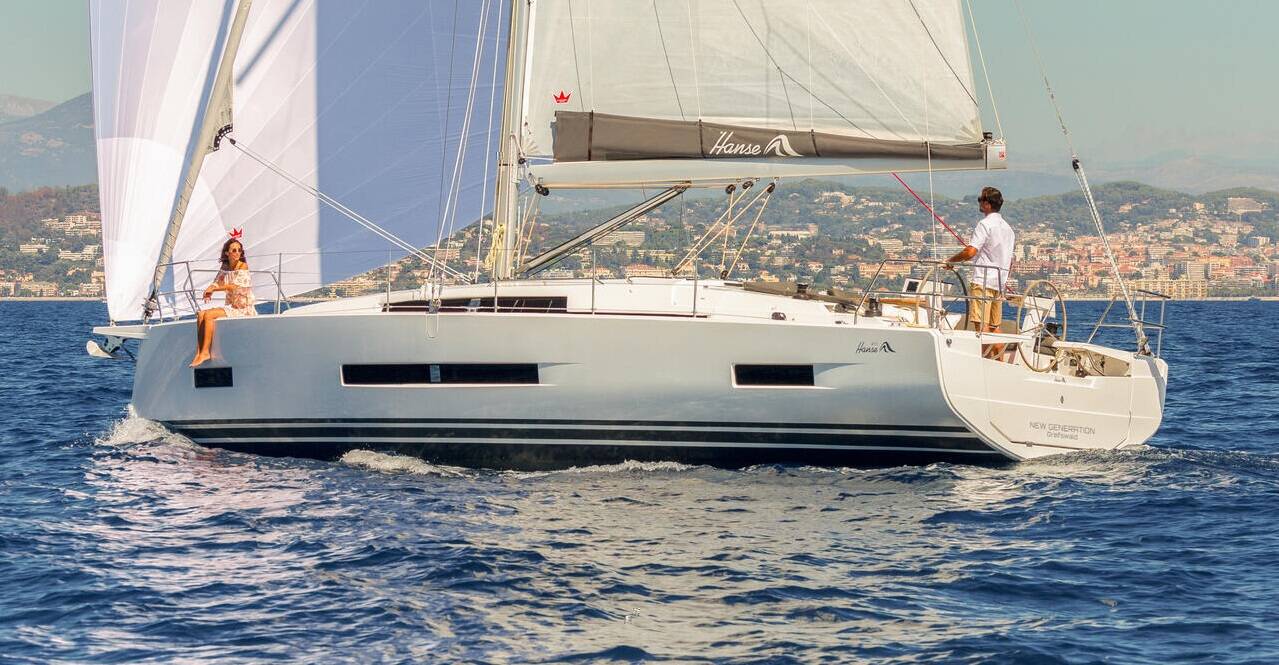
- Model Range

Design for the future. The Hanse 410.
Step into the future with the Hanse 410, where fashionable sailing harmonizes with eco-conscious values. The optimized hull design of this 41-foot yacht, featuring chines at the bow and stern, ensures a sleek waterline, providing the Hanse-typical uncompromising performance and ease while sailing. For the first time, the Hanse 410 introduces an optional electric propulsion system, boasting a remarkable range of up to 55 nautical miles. For even greater independence, a fuel cell delivers emission-free energy. Or, turn to the proven power of solar technology to keep essential appliances running on board without burning any fuel. The exclusive Sustainable Performance Sail (SPS) by Elvstrøm Sails is even made from recycled polyester, not only environmentally friendly but also fast on the water. Up to three expansive cabins and a welcoming salon, offer a genuine sanctuary with abundant space for relaxation. Cook in style on the waves! Experience a splash of gourmet in our galley, featuring ample storage, roomy workspace, and superior refrigeration. The Hanse 410 redefines elegance on the seas. With its class-first dual cockpit tables, there's an abundance of space and luxury seating, amplifying the sheer joy of a wind-driven journey.
Technical Specification
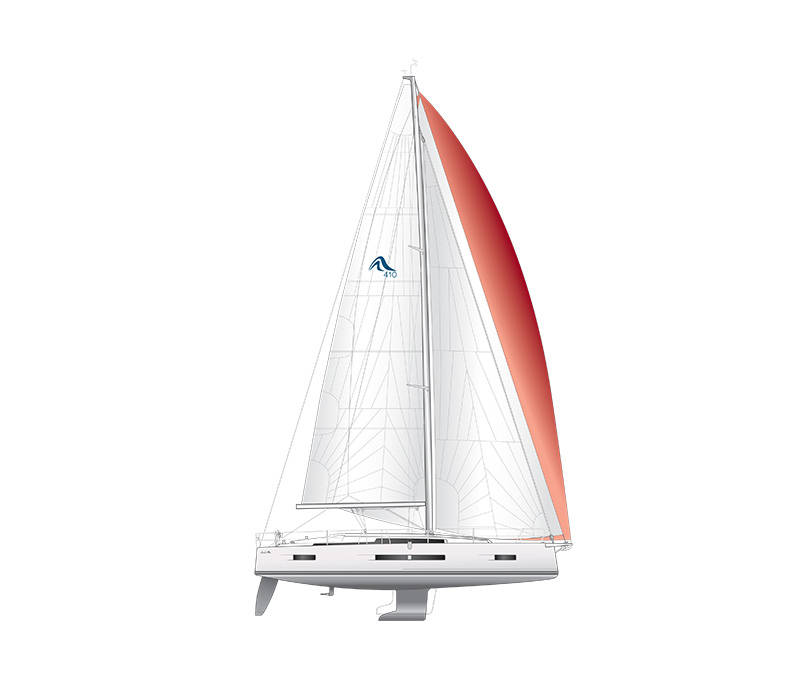
Try and Buy
Clear all doubts and experience your potentially new yacht firsthand before committing and final purchase.

Hanse Yacht World charter management program
Looking for the easiest way to your own boat? Choose our Hanse Yachting World charter management program that has already been recognized by many boat owners. Become a Hanse Yacht owner with minimal investment and enjoy the yacht's ownership without worrying about its maintenance.
If you are interested in buying yacht or need help planning your perfect vacation, contact us and our experts will gladly answer to all of your questions.
Request offer
You can find us in our headquarters:.
Address: Dražanac 2/a , 21 000 Split, CROATIA
Sales Office: +385 21 332 348
E-mail: croatia-yachting.hr
Office working hours: 8:00 – 16:00 CET
Feel free to ask us anything – our team is on your side!
For any yacht sales questions during the office hours please call our booking team in our Split headquarters on +385 21 332 348 or send us an e-mail on the address croatia-yachting.hr .
For urgent inquiries after working hours, you can contact our sales advisors individually on their mobile phones or send an e-mail and you will get a response as soon as possible:
e-mail: hanseyachts.hr
Mr. Domagoj Milisic - Sales manager
Mobile: +385 91 332 3320
Mr. Igor Karmelic - Yacht sales advisor
Mobile: +385 91 332 3322
Mr. Ivan Grabovac- Yacht sales advisor
Mobile: +385 91 332 3330
Croatia Yachting d.o.o. 2024. © All rights reserved.

E-Motion Rudder Drive, an electric engine with… the Propeller installed into the Rudder

Hanse Yachts introduces E-Motion Rudder Drive – an interesting propulsion type, with a special folding propeller….
An electric engine and a folding propeller have been installed into the rudder shaft, replacing the combination of diesel engine and sail drive. As a result, the propeller thrust is in line with the rudder position. This enables turning in the smallest circles or rotating around your own keel; it could be a perfect solution for maneuvering in narrow ports.
Making 4.5 knots with calm seas, the new Hanse 315 equipped with four lithium-ion batteries has a range of up to to 30 nautical miles – enough for all European inland waters and many coastal waters. At lower speeds, the range is significantly increased. The Rudder Drive can also be used with two batteries if a shorter range is required. The maximum speed is 6.1 knots – nearing the maximum speed of the diesel version.
The quiet Rudder Drive is also lightweight: 100 kg less than the diesel saildrive option. The Rudder Drive does not require a hole through the hull, lowering the resistance while sailing. The electric drive’s simplicity means less maintenance, as well.
E-Motion Rudder Drive: watch the video

From a standstill position, the yacht immediately starts to turn without having to pick up speed first. In addition, you enjoy all benefits of an electric engine. It will be the future?
7 Bluewater Cruising Sailboats We Love
Group beneteau: record full-year earnings in 2023, the countdown has begun for the new ice 66 rs, lagoon 60, freedom of space and panoramic views, live your passion, subscribe to our mailing list.
I think is a very good idea… I need to know if you sale this ingenio and to know the price and date of sending …Well as mucht as you can . Congratulations for that and awaiting for your news Carlos F Morante from Malaga Spain. For north wing 435
Dear Carlos, no we don’t sell it. We are a News Magazine. You have to contact Hanse Yachts (www.hanseyachts.com).
Best regards!
Nice, the space the engine takes is a lot. This would be great for smaller boats.
What provides the power? Diesel driving dc generator for the dc motor?
Yachting World
- Digital Edition

Hanse 460 review: First in a new range
- David Harding
- January 26, 2023
The Hanse 460 is the first in a new range of Hanses. From new designers, she is already a big hit, with over 200 sold and a European Yacht of the Year win to its name. David Harding reports

Product Overview
Price as reviewed:.
For some of us, sailing has always been about the functional and fundamental. We enjoy sailing for sailing’s sake. But today people want so much more from a boat and, in many respects, today’s yachts undoubtedly offer a lot more and the Hanse 460 attempts to do just that.
What you might loosely call the mainstream European builders of family cruising yachts have been following this path for some time, making each generation of designs bigger and plusher than the last. For Hanse in particular, it has been a rapid evolution from the small, basic and functional to the large and luxurious.
This latest Hanse is the first to be designed by Berret-Racoupeau. After the earliest models, which used the moulds of discontinued, slim-hulled Scandinavian designs, every Hanse has been designed by Judel/Vrolijk in what became one of boatbuilding’s most enduring and successful partnerships.
In line with modern trends, each new wave of Hanses has been higher, wider and more voluminous than the last. Founder Michael Schmidt never lost sight of the performance side, however. For all their growing girths and towering topsides, Hanse has always made boats that sail – competitively-priced, high-volume cruisers but with easy handling (self-tacking jibs were used from the early days) and better performance than many of the alternatives.
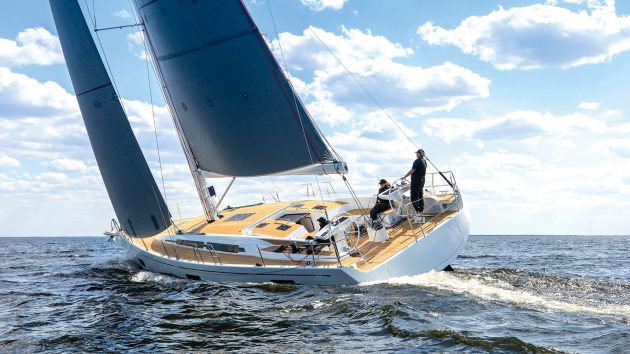
The single rudder is light and responsive on the helm. Photo: HanseYachts/Nico Krauss
The Hanse 460 is different. Very different. The first model from a new alliance with the French designers, it promptly won the European Yacht of the Year as the best Family Cruiser for 2022. A Hanse 510 version now follows.
The big question was whether Hanse had managed to do something different while retaining the qualities that its owners had traditionally sought.
At a glance, the Hanse 460 looks sleeker and sportier than earlier models; more angular, with a reverse rake to the bow and a pronounced knuckle running to about half-way aft. In Hanse tradition there are no hard-angled chines but, in this case, a pronounced soft chine towards the stern. In plan view you see full forward sections which, combined with the broad stern, generous freeboard and ample beam, hold the promise of enormous interior volume.

The 460’s generous and uncluttered cockpit. Photo: HanseYachts/Nico Krauss
At the other end, a moulded bowsprit projects the anchor clear of the stem and provides an attachment point for an outer forestay which can carry a reaching headsail. Large windows in the topsides help to break up the high freeboard.
Scale those topsides and you’re faced with an expanse of wide, flat deck and coachroof. Moulded bulwarks edge the side decks to help keep feet where they belong should you venture forward when the boat’s heeled. Otherwise what stands out is the uncluttered appearance – lines are led aft beneath separate mouldings – and the plethora of deck hatches hinged every which way, including one that opens to reveal a large bow locker.
There was certainly nothing to complain about in the performance and handling department. We slipped along very nicely on a flat sea in 12-14 knots of wind, clocking around 7.5 knots with the apparent wind at just under 30°, and tacking through around 80° by the compass.

Moulded bowsprit keeps anchor clear of the stem and provides attachment for the optional outer forestay. Photo: Andreas Lindlahr/EYOTY
Enjoyable sailing
Weather helm was slight and the load on the wheels increased relatively little if I tried bearing away with the sheets pinned in, the single rudder providing plenty of grip. Provoked in the opposite direction, she coped well when pinched mercilessly and also when thrown into tight spins, only stalling briefly.
At least in the flat water and modest breeze we encountered, the cockpit worked well. In any wind and seaway you would be pleased to have the optional second table to port as a bracing point. At the helm stations you have a comfortable perch outboard of the wheel or, for energetic downwind sailing when you might need both hands, behind it. The Jefa linkage is light and direct, giving a good feel from the rudder. On the starboard side you can wind down the bifurcated backstay when extra headstay tension is needed.

Hanse 460 is from Berret-Racoupeau. Photo: Andreas Lindlahr/EYOTY
Today’s cockpits are no longer just places from where you control the boat. Controlling the boat in itself is so much easier anyway, especially if – as most owners of the Hanse 460 will – you upgrade to electric winches, electric in-mast reefing and electric furling for the genoa on the outer forestay.
Other push-button options are for the hinge-down bathing platform and the cockpit tables (either side or both), which can be lowered to create large lounging areas. Alternatively there are fixed tables, as we had on the port side. A wet-bar can be added between the helm seats. It’s all part of making the cockpit a multi-function space in which every part can serve a variety of purposes. Cockpit stowage is in the form of a half-depth locker each side and – a first for Hanse – a dedicated liferaft locker right aft to starboard. With the electric-lowering option for the starboard table comes an extra moulded seat pod, which provides readily-accessible shallow stowage forward of the starboard helm and would be good to have for that reason alone.

Portlights and windows flood the saloon with natural light. Photo: HanseYachts/Nico Krauss
Moving about the deck and cockpit, and from one to the other, is easy in good weather. The wide open spaces let you simply stroll around – or lounge if you’re so inclined. Then again, they tend to present more of a challenge when a boat’s bouncing and heeling.
Lifestyle choices
Externally, the hull lines clearly differentiate the 460 from her earlier stablemates, but down below it’s a world apart. It’s certainly a more classy finish than we’ve seen before from Hanse; restrained in tone and a level above what we have become used to. Berret-Racoupeau is one of relatively few yacht design studios to have its own interior-design division.

Stateroom forecabin has generous stowage above and below the bed. Photo: HanseYachts/Nico Krauss
A host of interior layouts is available, from three to five cabins, up to four showers and from six to 10 berths. About the only constant is the presence of twin double cabins in the stern. Otherwise you can have different arrangements in the bow (cabins and heads) and amidships with a long or short linear galley and a bunk cabin or utility room to starboard where our boat had a chart table and heads compartment.
Details include backrests that hinge down in the saloon to provide trays and drinks-holders. You can press a button to lower the table, press another to pop up the TV from its central pod, and settle in for the evening.
Down here it’s all about sight-lines, integrating the different areas so no one feels left out, and ensuring that, as in the cockpit, every part of the layout performs multiple functions. In practice it creates a thoroughly pleasant and remarkably light environment.
If you enjoyed this….
Yachting World is the world’s leading magazine for bluewater cruisers and offshore sailors. Every month we have inspirational adventures and practical features to help you realise your sailing dreams. Build your knowledge with a subscription delivered to your door. See our latest offers and save at least 30% off the cover price.
Sometimes you come across a boat that makes you realise not only that yacht design has changed irrevocably, but also why it has changed and why it’s not going back. The Hanse 460 is unquestionably such a boat. How the crew lives aboard and moves around, both above and below decks, has clearly been thought about in the context of modern lifestyles. And this boat exudes style. If you like the fundamental design, you will be able to tailor many of the options and details to suit your tastes. A yacht like this is unlikely to slice to windward in heavy weather as comfortably as, say, a first-generation Swan 46, but most people aren’t really interested in that these days. I suspect the new Hanse will prove to be a pretty quick and competent all-rounder nonetheless. Simple sailing? The technology is not remotely simple any more. But with the Hanse 460, the sailing itself is simple and can still be a lot of fun.
JavaScript functionality for your browser has been deactivate. Please activate JavaScript so you can use all functions on this page.
- Back to overview
- Big Picture
- Press Releases
Technology cooperation for new sailing yacht drive
Rudder Drive, the new electric propulsion system for sailing yachts developed by Torqeedo together with the large-scale boat builder Hanse Yachts and rudder manufacturer Jefa, combines outstanding maneuverability and minimal weight with a powerful emission-free motor.
The core of this innovative concept is the proven and specially adapted Torqeedo Cruise 4.0 with folding propeller, designed in to the rudder blade itself. The streamlined system replaces the combustion inboard or saildrive and removes the need for a separate thruster on the new sailing yacht Hanse 315 e-motion rudder drive, which debuts at the end of October.
Outstanding maneuverability
Due to the unique rudder placement of the 4 kW (8 horsepower equivalent) Torqeedo electric motor, the motor can apply efficient, directional thrust. The Jefa rudder blade’s range of motion was extended to a total of 100 degrees. Demanding maneuvers can now be accomplished without a separate thruster. While motoring, the yacht can spin on its own axis – both forward and in reverse. While docking, the stern can easily be maneuvered into the proper position. This is highly useful in windy conditions or in narrow slips.
Exceptional endurance with minimal weight
Power generation while sailing
With integrated Torqeedo fast chargers, the emission-free version of the Hanse 315 is fully charged in just three hours. The batteries can be recharged at the dock or during sailing when the Rudder Drive’s folding propeller is used to generate power. Torqeedo is the only manufacturer of electric boat propulsion systems offering industrial engineering, complete system integration and ISO 9001 certified serial production in Germany.
World launch at the Hanseboot Hamburg
For the first time, the new propulsion system will be presented installed in the Hanse 315 e-motion rudder drive at the International Boat Show Hanseboot 2016 in Hamburg. We are looking forward to welcoming you to the Hanse Yachts booth (hall 6, booth C108) on Sunday, October 30, 2016 at 2 pm.
PDF Download
Pictures: Hanse 315 e-motion rudder drive motoring, Rudder Drive renderings
Published by Torqeedo GmbH Friedrichshafener Str. 4a 82205 Gilching Germany
Reprinting free of charge. 1 copy requested.
Next Articles
5 AUGUST 2016
12 JULY 2016
21 JUNE 2016
30 MAY 2016
Exalto Emirates LLC is Torqeedo’s new sales partner in the United Arab Emirates.
25 APRIL 2016
- BOAT OF THE YEAR
- Newsletters
- Sailboat Reviews
- Boating Safety
- Sailing Totem
- Charter Resources
- Destinations
- Galley Recipes
- Living Aboard
- Sails and Rigging
- Maintenance
- Best Marine Electronics & Technology

Nominee Spotlight: Hanse 510
- By Andrew Parkinson
- October 5, 2023
The Berret-Racoupeau-designed Hanse 460 turned heads as a 2022 Boat of the Year nominee with a fresh take on comfort and volume but with an eye better sailing performance. The second model in the new range designed by the Berret-Racoupeau team, the Hanse 510 is set to make its US premiere at the 2023 Annapolis Sailboat Show—again as a Boat of the Year contender. From what our editors saw at the model’s recent showing in Cannes, the 510 is expected to be a formidable opponent in its category during CW ’s Boat of the Year judging.
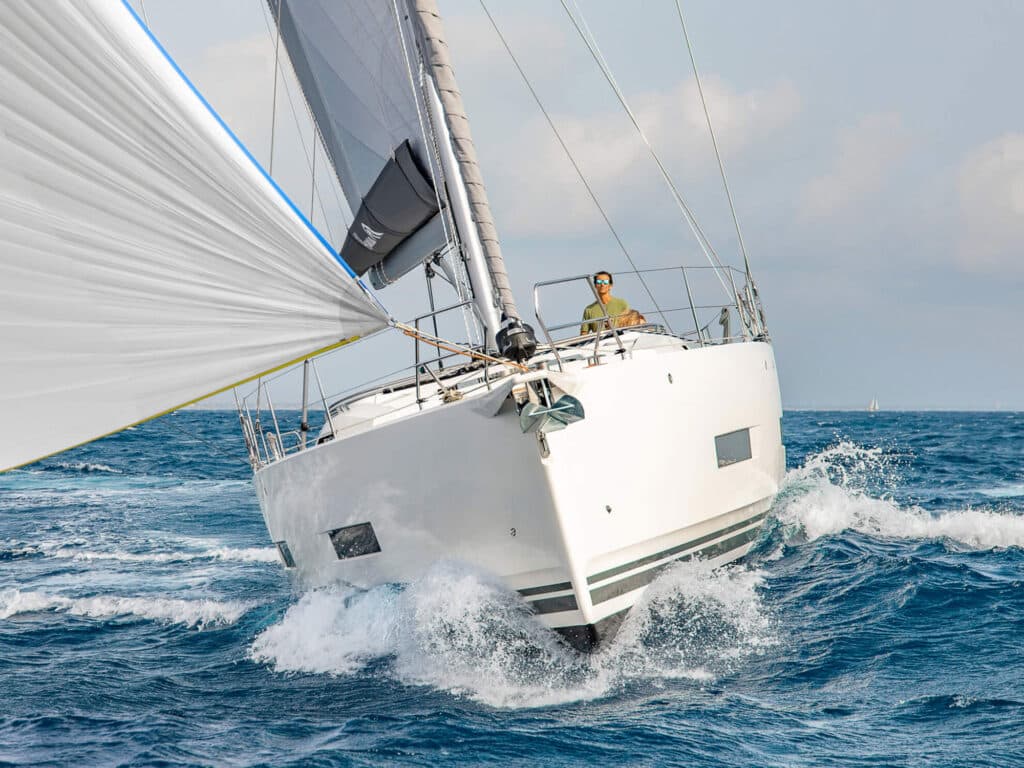
As for dockside demeanor, this new range’s calling card appears to be a marked chine on the bow and an inverted bow to optimize sailing performance. According to the designers, attention was also paid to refining the hull shape to maximize interior space. The result is an easy-on-the-eyes 51-footer that values smooth sailing and fast, comfortable cruising.
According to the builder, the Hanse 510 offers unrivalled volume in the 50-foot class, courtesy of an optimized hull design. Chines at the bow and aft further allow for a slim waterline, ensuring prime performance and easy sailing.
The 510 is equipped with a large, practical dinghy garage, capable of holding an inflated dinghy of up to 8.8 feet; and the optional, newly developed Hanse Smart Tender System makes launching that dinghy as simple as “driving a car out of the garage.” Convenience and style dominate the interior. Even the crew cabin gets in on the volume action, as it’s much more than the typical (read: small) crew sleeping space—it is a room worthy of staying a while. The options list is lengthy, and the boat can be highly customized to meet owners’ needs.
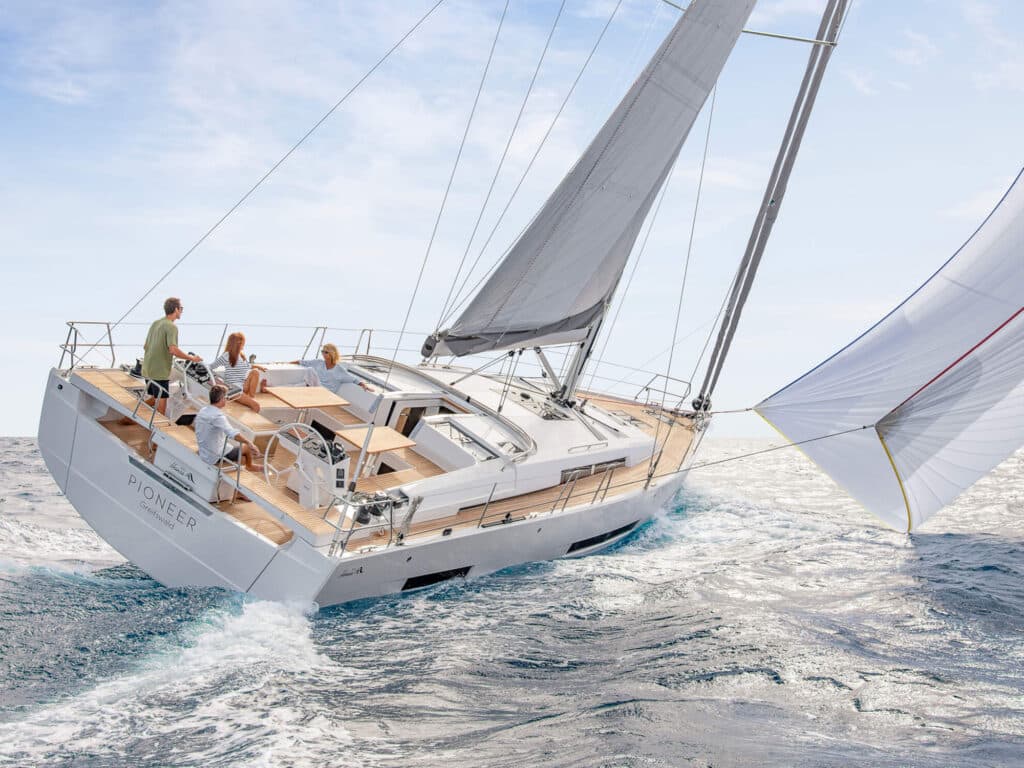
“Expectations were high after the outstandingly successful Hanse 460, which has been awarded European Yacht of the Year,” says Hanjo Runde, CEO of HanseYachts. “The new Hanse 510 is the logical and consistent further development of the new concept. With her impressive volume, tremendously dynamic lines and countless options, she is redefining the 50-foot class. It is an easy to sail and enormously spacious private retreat.”
The key talking points of the 510 are numerous. A hydrodynamic design with a slender waterline promotes better hull speed. Chines fore and aft allow for a wider hull and more interior space. The reverse, wave-piercing bow makes the yacht pitch less in strong winds, while the pronounced bow chines keep the foredeck as dry as possible. On deck, the strategically placed helm position promotes total control of the Hanse 510 in any situation, with all navigation and performance information easily accessible, as well as all lines and even the electric winches on the port side. An optional hardtop shades the entire cockpit including the steering positions, and it blends seamlessly with the boat’s silhouette. It is also available in several colors and accommodates special lighting and solar panels. A fixed windscreen is another option.
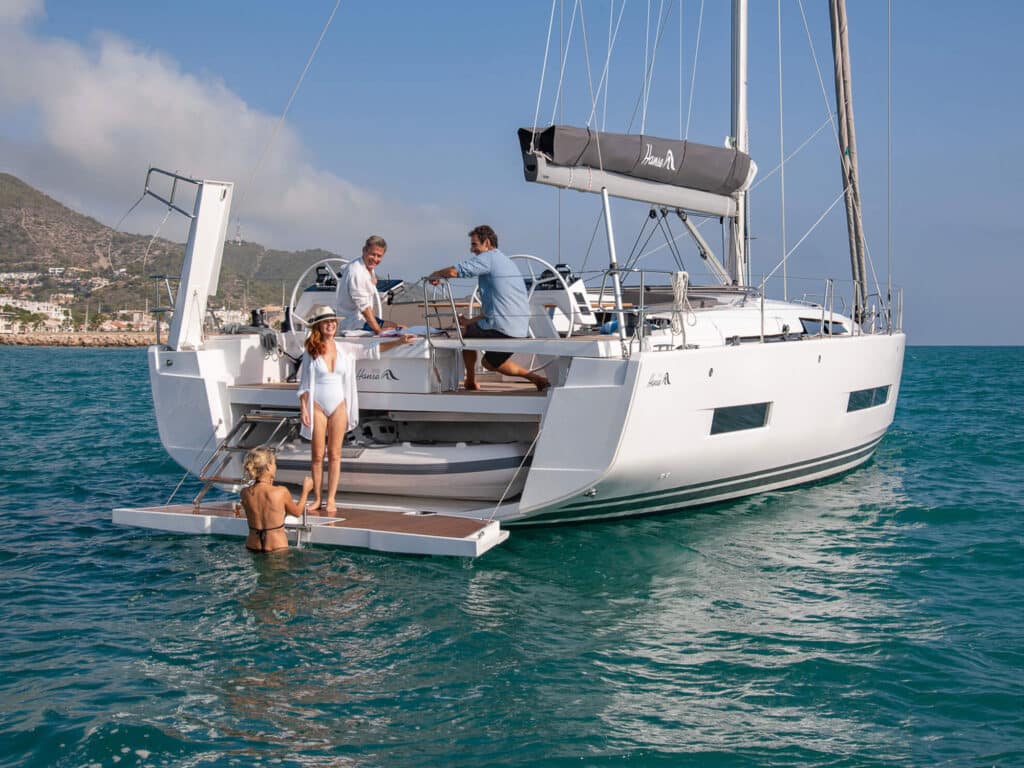
The novel dinghy garage is capable of holding a dinghy of up to 8.8 ft without having to deflate it. Combined with the optional automatic comfort stairs and the newly developed Hanse Smart Tender System, a single crew member can safely and comfortably deploy the dinghy, including engine, in minutes.
Another novelty on the Hanse 510 is the easy-to-open life raft storage space in the cockpit. Situated just in front of the companionway, it’s easily accessible and has space for standard 8-person life raft containers. An optional wet bar with grill and sink is hinged at the stern so as not to absorb precious cockpit space.
The boat comes rigged with a self-tacking jib, and all lines run back to the cockpit for simple sail handling of the 710 sq. ft. mainsail and various headsails. The jib is 570 sq. ft. and the reacher measures 1,011 sq. ft., set up using a Solent-style rig on the custom bowsprit. Air draft of the deck-stepped mast is just over 77 feet above the waterline. Optional electric furling systems and winches make light work of handling halyards and sheets for the optimum in performance, short-handed sailing. The standard boat comes with a single, 80 hp saildrive, although an upgraded, optional 110 hp diesel is also available.
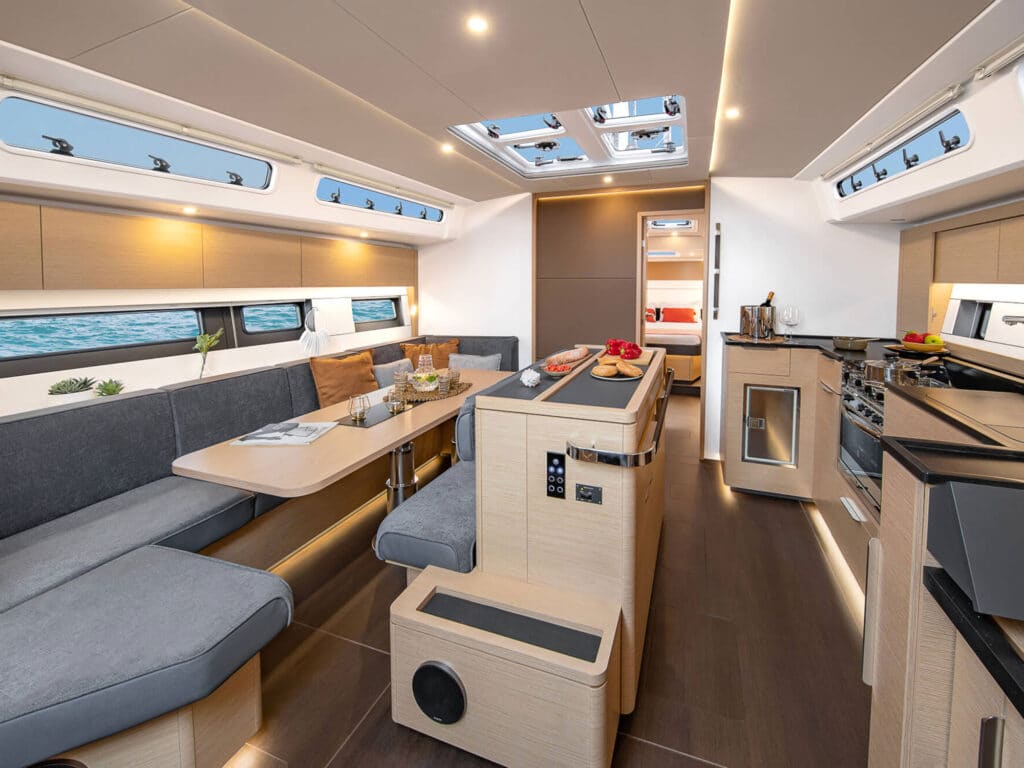
Within the interior, 14 well positioned opening hatches and eight opening windows and portholes permit maximum light and ventilation below deck. A long list of layout options are said to be available for the interior arrangement, from an “owner’s yacht” with a best-in-class sized master cabin, to a “charter yacht” with 10 berths, three bathrooms and an additional skipper cabin. The galley can be fully adapted to the owner’s needs as well: In addition to various refrigerator and freezer options, there is room for a wine cooler, dishwasher and a three-burner gas cooker plus an oven in the longitudinal pantry, which can be customized with a vast choice of colors and materials. Another option is a fully equipped navigation area with a forward-facing seat and a large salon table. The extensive options list, ranging from a washing machine in the utility room to flatscreens in the master cabin and salon, is crowned by the Flagship Package, which includes highest-end fabrics and materials, not to mention a “hidden” bar behind the folding backrest in the salon.
At its core, the Hanse 510 emphasizes a roomy cockpit, large but manageable sail plan, and overall performance that is easily managed by a couple, but perhaps what really sets the Hanse 510 apart from other sailboats in its class is the limitless level of customization the builder is willing to offer. The Hanse 510 also comes with a CE rating of A-12, so it is well suited for those who want to venture longer distances.
Hanse 510 Specifications
- More: 2024 Boat of the Year , Boat of the Year , hanse , Sailboats
- More Sailboats

Balance 442 “Lasai” Set to Debut

Sailboat Review: Tartan 455

Meet the Bali 5.8

Celebrating a Classic

Kirsten Neuschäfer Receives CCA Blue Water Medal

2024 Regata del Sol al Sol Registration Closing Soon

US Sailing Honors Bob Johnstone

Bitter End Expands Watersports Program
- Customer Service
- Privacy Policy
- Email Newsletters
- Cruising World
- Sailing World
- Salt Water Sportsman
- Sport Fishing
- Wakeboarding
The NKD Sailor
Electric Sailboats
For prospective buyers, here is a list of new sailboats that at the time of writing have an electric motor in their specifications , either in the standard configuration or as an option. (Updated 19.1.2022)
Please comment or send me an email ( [email protected] ) if you find errors or omissions.
Alva Yachts
- Ocean Sail 72 , 135 kW electric motor
- Ocean Sail 82 , 135 kW electric motor
Arcona Yachts
- Arcona 345 , Oceanvolt
- Arcona 385 , Oceanvolt
- Arcona 415 , Oceanvolt 15 kW
- Arcona 435 , Oceanvolt
- Arcona 465 , Oceanvolt
Domani Yachts
- Design S30 , Torqueedo Cruise 24V e-saildrive
- Design S32L , Torqueedo Cruise 48V e-saildrive, 4kW
Elan Yachts
- Elan E3 , Oceanvolt 8 kW.
- Elan E4 , Oceanvolt 8-10 kW.
- Elan E5 , Oceanvolt 10-15 kW.
- Elan E6 , Oceanvolt 15 kW or Oceanvolt 10 kW twin.
- Elan i40.1 , Oceanvolt 10-15 kW.
- Elan i45.1 , Oceanvolt 15 kW.
- Elan i50.1 , Oceanvolt 15 kW twin.
- Elan GT5 , Oceanvolt 15 kW or Oceanvolt 10 kW twin.
- Elan GT6 , Oceanvolt 15 kW twin.
Hanse Yachts
- Hanse 315 , Torqeedo e-motion rudder drive ,
Jeremy Rodgers Limited
- Contessa 32 new build , Beta/Hybrid-Marine ,
Salona Yachts
- Salona 33 , Oceanvolt 8 kW.
- Salona 35 , Oceanvolt 8 kW.
- Salona 38 , Oceanvolt 8 kW.
- Salona 41 , Oceanvolt 10 kW.
- Salona 46 , Oceanvolt 15 kW ( also with 2 x 10 kW ).
Spirit Yachts
- SPIRIT 44CR(E) , Oceanvolt 15 kW.
Viator Marine
- Viator Explorer 42 DS , 2 x Bellmarine DriveMaster 15kW 48V
- Viator Explorer 54 DS , 2 x ISCAD V50 50kW 48V
- WALLYNANO MKII , Oceanvolt 6 kW.
Antares Catamarans
- Antares 44 Hybrid , Hybrid Marine 40 HP Yanmar Parallel hybrid system
DNA Performance Sailing
- DNA G4 , Oceanvolt 6 kW.
HH Catamarans
- HH44 , 2 x BETA 30 + 2 x 10 kW parallel hybrid drives
- OC44 , 2 x BETA 30 + 2 x 10 kW parallel hybrid drives
- HopYacht 30 , 2 x 6 kW E-propulsion pod drive .
Independent Catamaran
- IC36 Independence , 2 x Oceanvolt 6 kW.
ITA Catamarans
- ITA 14.99 , 2 x Oceanvolt 15 kW with 1 x 15 kW generator.
Lady Hawke Catamarans
- LH 33 Comfort Eco , 2 x Oceanvolt 6 kW
Maverick Yachts
- Maverick 440 Hybrid , 2 x Oceanvolt 15 kW
Open Waters Yachts
- Open Waters ESC40 , 2 x 10 kW electric motors
- Outremer 4.zero , 2 x Oceanvolt 10 kW.
SeaQuest Catamarans
- SeaQuest 46 , 2 x Oceanvolt 15.1 kW
Slyder Catamarans
- Slyder 49 , 2 x 22 kW electric motors
- Slyder 59 , 2 x 25 kW electric motors
Sunreef Yachts
- Sunreef 50 Eco Yacht , 2 x 40 kW electric motors
- Sunreef 60 Eco Yacht , 2 x 70 kW electric motors
- Sunreef 70 Eco Yacht , 2 x 90 kW electric motors
- Sunreef 80 Eco Yacht , 2 x 160 kW electric motors
- Sunreef 100 Eco Yacht , 2 x 270 kW electric motors
Vaan Yachts
- VAAN R4 , 2 x Torqeedo FP10 10 kW saildrive (standard), 2 x Oceanvolt 15 kW (option)
- VAAN R5 , 2 x Torqeedo Deep Blue saildrive 25 kW or 2 x Oceanvolt 15 kW
- Windelo 50 Adventure (also Yachting and Sport versions), 2 x Bellmarine 20 kW electric motors.
- Windelo 54 Adventure (also Yachting and Sport versions), 2 x 24 kW Bellmarine electric motors.
The little (electric) engine that could: The Port of San Diego unveils the nation’s first all-electric tug boat
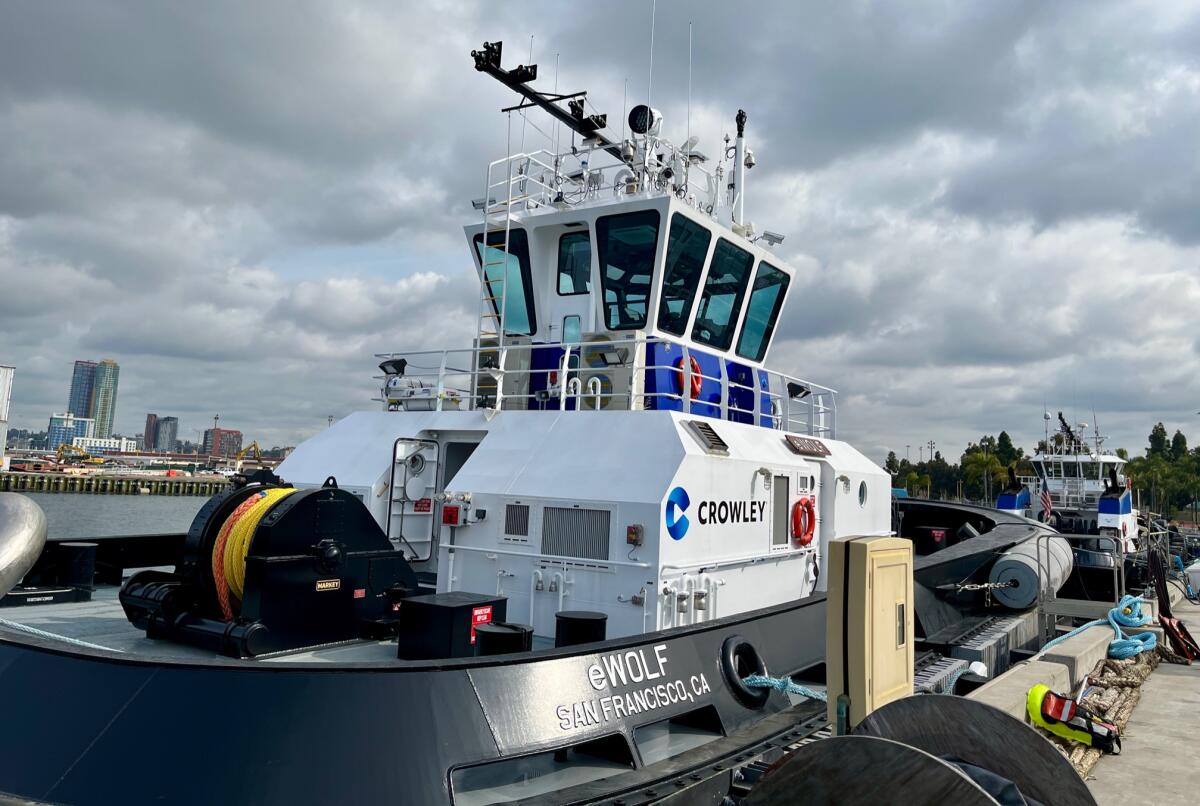
The 82-foot eWolf expects to eliminate 3,100 metric tons of carbon dioxide
- Show more sharing options
- Copy Link URL Copied!
The nation’s first all-electric tug boat has docked at the Port of San Diego and expects to begin emissions-free operations in about a month.
Operated by Crowley Maritime Corporation , the 82-foot eWolf will escort ships entering and leaving the Tenth Avenue Marine Terminal using electric power instead of diesel fuel, helping slash greenhouse gas emissions at the port and its neighbors in Barrio Logan and National City.
For the record:
1:58 p.m. March 13, 2024 This story has been updated to show the correct amount of government funding that went to the project.
“This is a big deal,” said port chairman Frank Urtasun at a news conference Monday. “This is new technology.”
Capable of speeds of up to 12 knots, the eWolf is powered by a 6.2 megawatt-hour main propulsion battery and two electric drives. The tug has thrust — also known as bollard pull in the parlance of the shipping industry — of 76.8 short tons, which is more powerful than the diesel-powered counterparts at the port.
Constructed in Alabama, the eWolf is equipped with two small generators for emergency use that allow the boat to travel longer distances at a reduced speed.
“Like an electric car, you step on the gas and it jumps,” said Paul Manzi, vice president of Crowley Shipping, based in Jacksonville, Fla. “All of the attributes that you have with an electric motor operation in a car or in an electric truck, you see here in the (eWolf) at massive scale. And it’s extremely quiet so when it pulls away from the dock you literally won’t hear any noise.”
The tug boat’s electricity will come from a charging station that is part of a microgrid facility equipped with two energy storage containers. Battery modules in each container have storage capacity of nearly 1.5 megawatt-hours.
Interconnected with the help of San Diego Gas & Electric, the charging station at the port is designed to allow the vessel to recharge quickly and reduce peak loads on the electric grid.
Operators plan to charge the eWolf overnight so it can perform its chores during daytime hours.
“This technology has individually been around for a while, but it hasn’t necessarily been integrated and optimized to all work together — and that’s kind of our role,” said Bruce Strupp, vice president at ABB Marine & Ports , the company that designed the boat’s propulsion system. “Some of the technology is our technology, some of it’s third-party technology, but we integrate it all together.”
The electric tug boat is expected to begin commercial operations at the port in mid- to late-April, depending on the completion of the charging station.

Officials at Crowley did not release the eWolf’s price tag Monday, saying only that it cost about twice as much as a conventional diesel-powered tug boat of comparable size.
But, Manzi said, the company expects the eWolf’s maintenance and operating costs will be “dramatically lower” than what’s spent on a diesel-powered tug boat because the electric model has fewer moving parts.
The entire project — the vessel as well as the charging station — received four grants that added up to $13.67 million, with two grants of $10.9 million from the San Diego Air Pollution Control District, one grant of just over $2 million from the U.S. Environmental Protection Agency and $750,000 from the federal government’s Maritime Administration.
In 2020, Gov. Gavin Newsom signed an executive order that directed state agencies to transition off-road vehicles — including tug boats — and equipment to 100 percent zero emissions by 2035.
By replacing one of the port’s diesel-powered tugs, the eWolf is expected to eliminate the consumption of about 35,000 gallons of diesel fuel per year. In its first 10 years of use, the electric tug boat is expected to reduce about 3,100 metric tons of carbon dioxide from the port and its surrounding areas such as Barrio Logan and National City.
“We’re trying to be good neighbors and trying to be able to help to reduce emissions here to help the electrification movement,” Urtasun said, adding that the port has spent about $130 million on various electrification projects.
Last year, the Port of San Diego became the first in North America to install a pair of all-electric cranes to load and off-load heavy cargo. Each 262 feet high, the cranes replaced an older crane that ran on diesel fuel. Together, the cranes expect to help the port reduce greenhouse gas emissions by 47 metric tons per year.
Get U-T Business in your inbox on Mondays
Get ready for your week with the week’s top business stories from San Diego and California, in your inbox Monday mornings.
You may occasionally receive promotional content from the San Diego Union-Tribune.

More from this Author
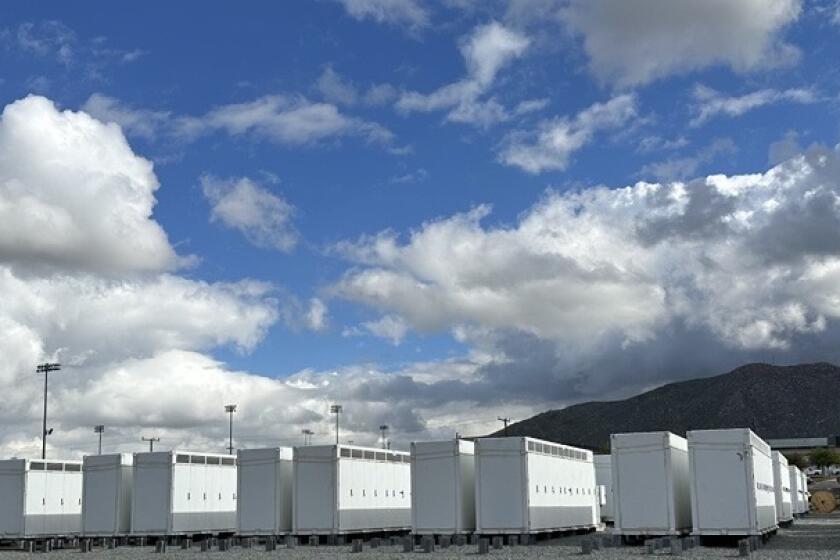
San Diego Community Power signs agreement for big energy storage project that could power 45,000 homes
March 21, 2024
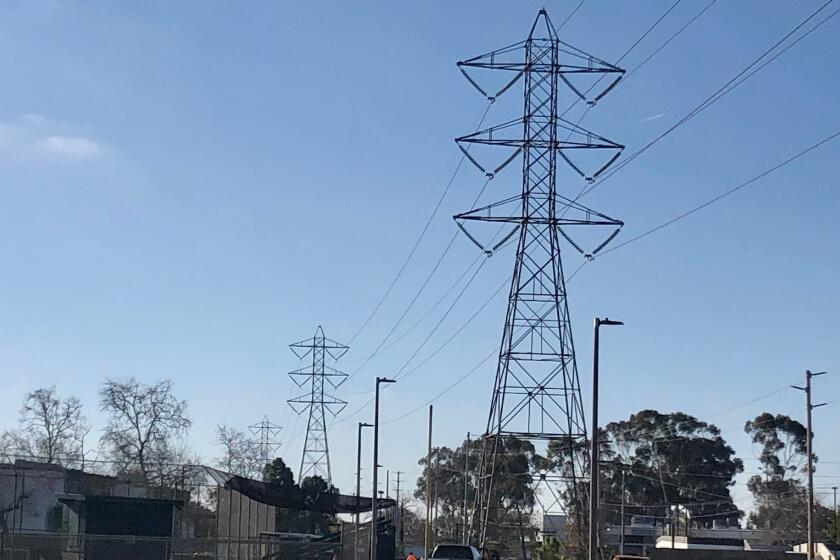
If the city of San Diego ran its own municipal utility instead of using SDG&E, how much would it cost?
March 15, 2024
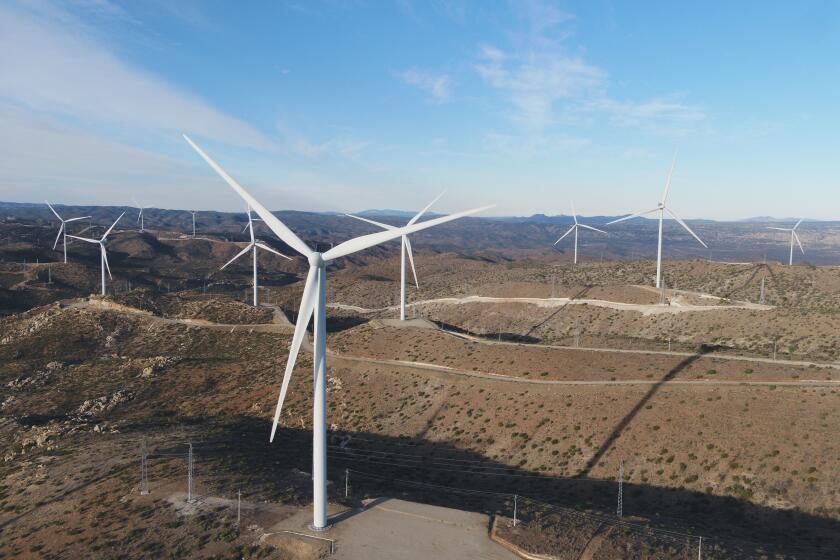
Blowin’ south of the border: Sempra subsidiary will build a new wind farm in Mexico

San Diego EV charging company completes $1 million deal with the U.K.’s defense ministry
March 12, 2024
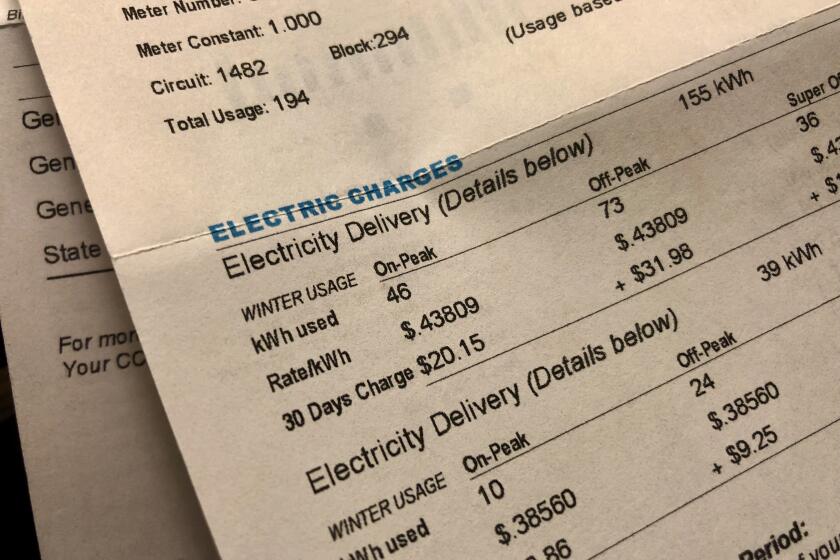
Here’s how many San Diego customers are behind on their utility bills
March 10, 2024

Biden hits the pause button on new LNG projects. It may cloud expansion plans at a Sempra project in Texas
Feb. 29, 2024
More in this section

National Business
Requiring ugly images of smoking’s harm on cigarettes won’t breach First Amendment, court says
A federal appeals court says a requirement that cigarette packs and advertising include graphic images demonstrating the effects of smoking does not violate the First Amendment

EU Commission proposes to impose tariffs on imports of grain from Russia
The European Union’s executive arm is proposing to member countries to impose tariffs on grain imports from Russia and Belarus

PIRCH, Oceanside-based luxury home appliance merchant, abruptly ‘pauses’ operations
PIRCH’s two San Diego County stores, in Solana Beach and Westfield UTC mall, announced they are now temporarily closed through the weekend, with future plans still unknown.
Antitrust lawsuits accuse major US sugar companies of conspiring to fix prices
Three antitrust lawsuits filed by food businesses in federal court in Minnesota this week accuse some of the largest U.S. sugar-producing companies of conspiring to fix prices

Need to ‘borrow’ miles from your kid to get that free flight? A big airline will let you do that
What if you don’t have enough airline miles for that free flight, but a family member does

Firing of Ohtani’s interpreter highlights how sports betting is still illegal in California
The firing of Shohei Ohtani’s interpreter by the Los Angeles Dodgers over allegations of illegal gambling and theft has highlighted an issue many outside of California don’t realize: Sports betting is still against the law in the nation’s most populous state
EJET Eco-Friendly Electric Motor & Drivetrain Yacht Tenders: New Model Announced
Boat engineering and design company EJET Electric Yacht Tenders has announced the development of its latest electric motor 9X yacht tender model.
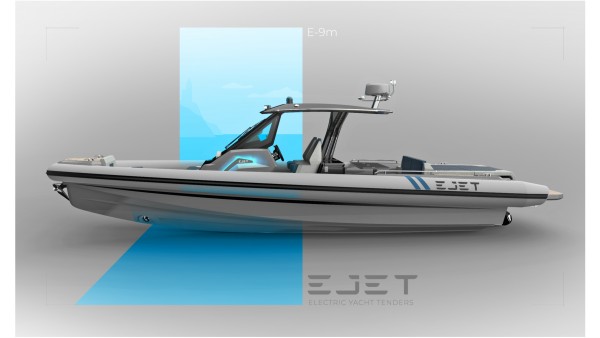
Ljubljana, Slovenia - March 21, 2024 —
Much like their highly acclaimed 4X tender, the upcoming 9X model sports EJET’s proprietary electric motor and drivetrain, going in line with founder Žiga Jarc’s mission of providing sustainable transportation options for yacht owners and guests. Both models will be available in the summer, with the 9X build slated for initial testing in July.
For more information, please visit https://ejet.co/
The announcement follows EJET’s recent appearance at the Boot Düsseldorf Boat Show. Having received the International Boat Industry’s Rising Star Award, the company revealed the development of its larger 9X model with the aim of promoting environmental responsibility within the boating industry.
Designed to be lightweight and compact without sacrificing output or speed, the new tender will be powered by a 220 kWh battery and a 300 kW motor, with an option to upgrade to 340 kW, ensuring 98% efficiency and making it suitable for sports such as water skiing. The boat’s V-shaped hull has been adjusted to accommodate EJET’s custom electric powertrain and is capable of withstanding turbulent waters and inclement weather conditions. Each boat is built with standard hydraulic steering mechanisms, along with the company’s military-grade jet system, allowing for easy maneuvering, reversing, and sudden stops in both low- and high-speed scenarios.
The 9X model will also feature a digital interface, which boaters will be able to use to select different driving modes and dynamics, view real-time GPS navigation and system data, and access the smart audio Bluetooth system. Additionally, amenities such as a hydraulic bathing platform, an electric grill, an ice maker, and a refrigerator will all be available as upgrade options for all 9X tenders.
About EJET Electric Yacht Tenders
Founded in 2016 by Žiga Jarc, EJET began with the goal of developing a zero-emissions electric yacht tender that did not compromise performance or safety. The company has since become a pioneer in electric propulsion systems and remains committed to future innovations in the boating industry. EJET tenders are currently the only products on the market with custom electric drivetrains.
EJET Electric Yacht Tenders, under the leadership of founder Žiga Jarc, is actively engaged in the development of its proprietary electric propulsion technology. The initiative is part of the company's broader commitment to innovation in high-performance, long-range powertrain technology for the marine industry. This effort underscores EJET's focus on delivering solutions characterized by their lightweight and compact design, high power output, and exceptional motor efficiency of up to 98%. With a specific emphasis on extending battery life, the company aims to set new benchmarks for what is achievable in electric propulsion within the boating sector.
“We built the company and the brand on three pillars: driver-centric experience, sustainability with clean electric power, and advanced electric propulsion technology,” says Ziga Jarc. “We cooperate with the best nautical partners to create unforgettable experiences for our customers.”
Interested parties can learn more by visiting https://ejet.co/contact-us/
Contact Info: Name: Žiga Jarc Email: Send Email Organization: EJET Electric Yacht Tenders Address: 16C Mokrška ulica, Ljubljana, Ljubljana 1000, Slovenia Phone: +386-41-688-998 Website: https://ejet.co/
Release ID: 89125030
If there are any errors, inconsistencies, or queries arising from the content contained within this press release that require attention or if you need assistance with a press release takedown, we kindly request that you inform us immediately by contacting [email protected] . Our reliable team will be available to promptly respond within 8 hours, taking proactive measures to rectify any identified issues or providing guidance on the removal process. Ensuring accurate and dependable information is our top priority.
More From Forbes
What candela’s electric hydrofoiling passenger ferry means for sustainable transportation.
- Share to Facebook
- Share to Twitter
- Share to Linkedin
The all-electric-powered Candela P-12 ferry flies over the water on hydrofoils
I would never say “I told you so,” but…now that Candela , the world’s leading producer of all-electric-powered hydrofoiling boats, has just closed the largest funding round in the company's history, I might be bold enough to say…”I’m not surprised.”
That’s because I’ve been closely following the development of this wonderfully smart company’s hydrofoiling boats since I test flew a P-7 near their small and efficient shop in Stockholm in 2021. So, I’m really not surprised they just raised over $25 million to expand production of their game-changing P-12 ferry. And since yacht building powerhouse Groupe Beneteau is a key partner in the largest fundraising round Candela has ever completed it appears Candela’s brand of tech-controled hydrofoiling is about to go global.
“Our investment perfectly aligns with Groupe Beneteau‘s ecological transition objectives, scaling up innovative solutions for more sustainable boating and unparalleled experiences,” says Bruno Thivoyon, CEO of Groupe Beneteau, the world's largest boat manufacturer (15 factories, 9 brands, and more than 8,000 yachts built annually) with a total revenue of over $1.5 billion in 2023. “Candela’s technology, enabling significantly more efficient electric vessels, will transform waterborne transport into its next sustainable phase.”
A Candela P-8 and P-12 underway near Stockholm, Sweden
“We couldn’t be more excited about having Groupe Beneteau on board,” says Gustav Hasselskog, Founder and CEO of Candela. “As the leading global boat company, their trust is a stamp of approval for our technology to transform waterborne transportation. We’re excited for the possibilities ahead."
Best High-Yield Savings Accounts Of 2024
Best 5% interest savings accounts of 2024.
The new investment round will help to scale up production to meet demand for the recently launched Candela P-12, the world’s first electric hydrofoil ferry. The P-12 is the first fast and long-range electric ferry on the market. Its efficient hydrofoil technology cuts lifetime emissions by 97.5% compared to diesel vessels, while simultaneously allowing operators to save up to 50% in operating costs. Since it generates minimal wake, the P-12 has been granted exemptions from speed limits, as for example on its maiden route in Stockholm, where it from July will cut travel times in half compared to road transport and legacy diesel vessels.
And it’s pretty obvious Hasselskog and company are on the right track. According to some projections the market for electric vessels is expected to be worth $14.2 Billion USD in 2030.
“We’ve spent years developing the technological maturity, and now we’re fit for scaling to commercial vessels. As in any industry, the fastest-scaling company will dominate the market,” says Hasselskog.
The Candela P-8 and P-12 hardly make a ripple as they fly over the water on computer-controlled ... [+] hydrofoils
Other backers in the round include longtime investors EQT Ventures , Ocean Zero LLC , and Kan Dela AB. The new investment brings total funding since Candela’s inception to over $75 million.
“EQT Ventures has steadfastly backed Candela's vision to accelerate the shift towards fossil fuel-free lakes and oceans since 2021. The launch of Candela's P-12 vessels signifies a watershed moment in sustainable transport", says Lars Jörnow, Partner at EQT Ventures.
The only question is: when will we see a P-12 ferry here in the US?

- Editorial Standards
- Reprints & Permissions
Candela’s electric ferries multiply as the startup lines up $25M in new funding
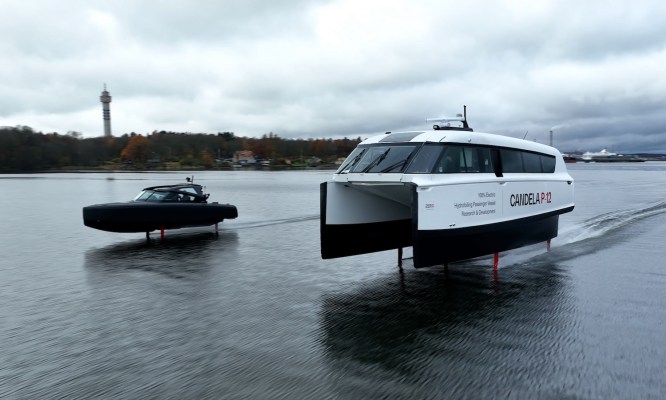
Electric boat maker Candela is approaching cruising speed with $25 million in new funding and the first commercial deployment of its new P-12 ferry in New Zealand. The company has global ambitions for its highly efficient boats and has completed and delivered dozens of them — which is a lot in this industry!
Candela has been slowly upping the size of its vessels for years, starting with the considerably smaller C-7 and C-8 (noting the length in meters) — of which, as of this week, they have now produced a total of 70. The P-12, a ferry design that can handle up to 30 passengers, made its debut late last year .
Just last week, the P-12 was given its first assignment: ferry people around New Zealand’s Lake Manapōuri , a scenic destination but also, more importantly, the site of the country’s largest hydroelectric power station. And now staff at that station can get to work via clean-running boat rather than driving, which the companies estimate will save around 240 tons of emissions per year. It’s a start, and it will help keep the lake clean and quiet.
International interest in these boats is also evident in the participation of Groupe Beneteau, a more than century-old boating company that makes thousands of vessels yearly, in the funding round. Groupe Beneteau CEO Bruno Thivoyon expressed in the press release that investing in Candela makes sense as part of the company’s “ecological transition objectives, scaling up innovative solutions for more sustainable boating.”
Many legacy boating companies are embracing electric engines and next-generation tech; I spoke with the head of another major manufacturer, Brunswick’s Dave Foulkes, at CES about it. He said that the collaborations are fruitful because the small, growing companies need the income and reach, while the larger ones need ready-to-deploy tech. Like any other industry, you have to know when to buy and when to build, and big boating companies are happy to buy — or invest.
Candela’s boats use hydrofoils with electric engines mounted on the bottom to effectively fly above the surface of the water once they get past a certain speed, vastly reducing energy consumption — historically and understandably a sticking point for electric boating. The approach does necessitate a powerful autopilot to keep it balanced, and despite their assurances, I wonder about how they’d handle log collisions, but overall the advantages seem to outweigh the drawbacks.
I drove one over the summer in Seattle (watching closely for logs, rather common in Elliott Bay) and wished they would replace the gas-chugging fast passenger ferries with P-12s. Candela isn’t the only one pursuing this market, either; Navier is also attempting to woo coastal communities with the draw of quiet, energy-efficient transit and is currently shuttling Stripe employees around the Bay Area . And while Zin Boats has been quiet for some time, they are also nailing down markets for the next version of their vessel.
The $25 million round was led, as mentioned, by Beneteau, with participation from EQT Ventures, Ocean Zero LLC, and Kan Dela AB.
Breaking rules, setting trends
- Open search box
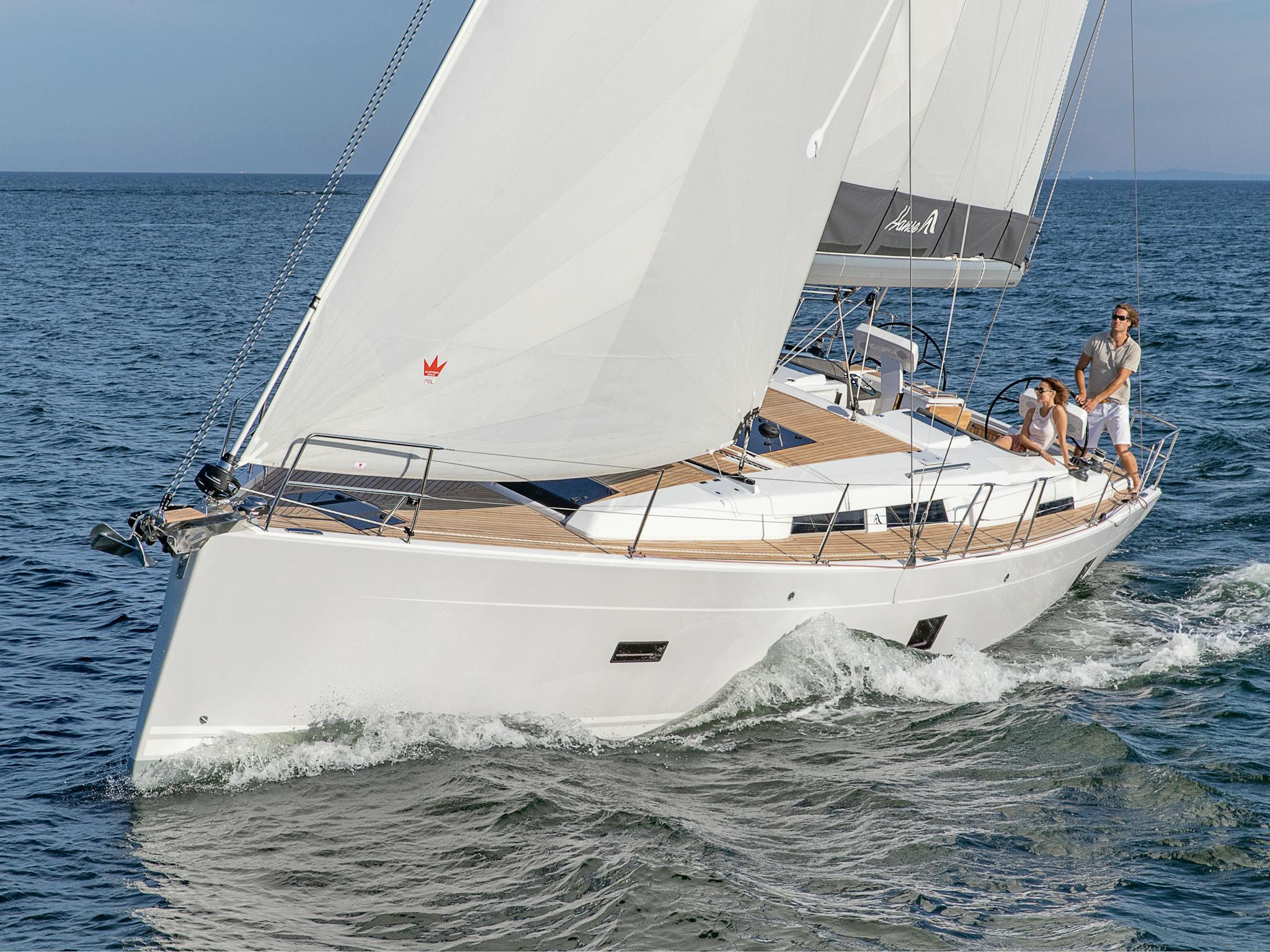
Legacy Model: Hanse 458
The new Hanse 458 is the yacht for all of those who set trends. With a pioneering design and the most thrilling performance in its class. With an exquisite interior and an exceptionally diverse range of customization options. The Hanse 458 caters to the highest demands on contemporary style and quality of life. Let yourself be amazed by excellence across 45 feet (ca. 14 m).
Exterior design
Our yachts combine excellent nautical characteristics, easy handling and breathtaking design.
Interior design
In our interiors you will find unique solutions that provide the ultimate in comfort and storage, a home-like experience and astonishing design.
The most important information about your Hanse.
Keep the most important information about your yacht at hand and read it even without the internet whenever you want to!
No documents found
Explore current Hanse models
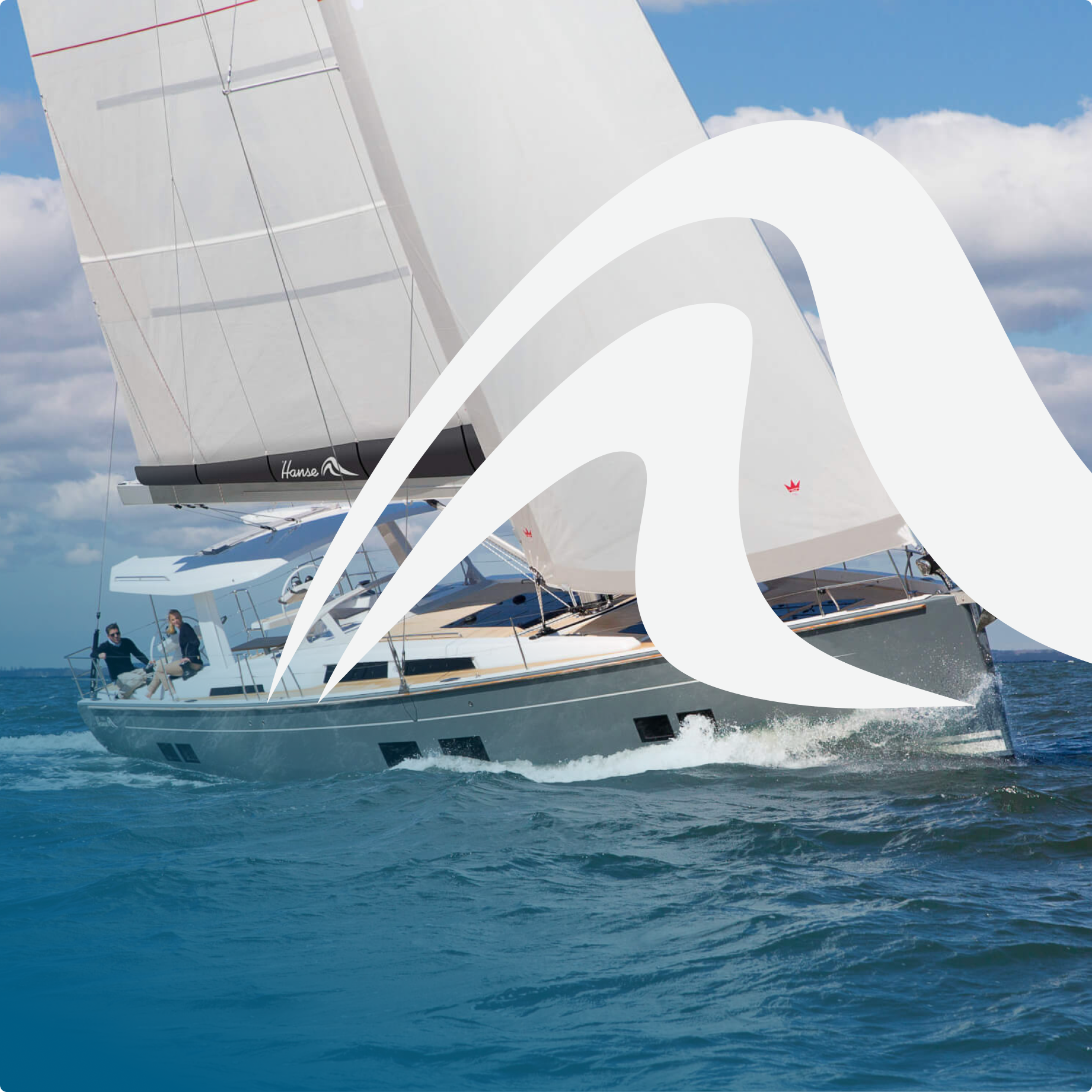
Customise your dream yacht in seconds!

Seize the moment - schedule your appointment today.

Friday 11 April 2014
Moscow metro - spirit of a city (e.p).

No comments:
Post a comment.

Turn Your Curiosity Into Discovery
Latest facts.

Facts About The Research in Epithalon Properties Overview Analysis

How To Protect Children From Junk Food Marketing
40 facts about elektrostal.
Written by Lanette Mayes
Modified & Updated: 02 Mar 2024
Reviewed by Jessica Corbett

Elektrostal is a vibrant city located in the Moscow Oblast region of Russia. With a rich history, stunning architecture, and a thriving community, Elektrostal is a city that has much to offer. Whether you are a history buff, nature enthusiast, or simply curious about different cultures, Elektrostal is sure to captivate you.
This article will provide you with 40 fascinating facts about Elektrostal, giving you a better understanding of why this city is worth exploring. From its origins as an industrial hub to its modern-day charm, we will delve into the various aspects that make Elektrostal a unique and must-visit destination.
So, join us as we uncover the hidden treasures of Elektrostal and discover what makes this city a true gem in the heart of Russia.
Key Takeaways:
- Elektrostal, known as the “Motor City of Russia,” is a vibrant and growing city with a rich industrial history, offering diverse cultural experiences and a strong commitment to environmental sustainability.
- With its convenient location near Moscow, Elektrostal provides a picturesque landscape, vibrant nightlife, and a range of recreational activities, making it an ideal destination for residents and visitors alike.
Known as the “Motor City of Russia.”
Elektrostal, a city located in the Moscow Oblast region of Russia, earned the nickname “Motor City” due to its significant involvement in the automotive industry.
Home to the Elektrostal Metallurgical Plant.
Elektrostal is renowned for its metallurgical plant, which has been producing high-quality steel and alloys since its establishment in 1916.
Boasts a rich industrial heritage.
Elektrostal has a long history of industrial development, contributing to the growth and progress of the region.
Founded in 1916.
The city of Elektrostal was founded in 1916 as a result of the construction of the Elektrostal Metallurgical Plant.
Located approximately 50 kilometers east of Moscow.
Elektrostal is situated in close proximity to the Russian capital, making it easily accessible for both residents and visitors.
Known for its vibrant cultural scene.
Elektrostal is home to several cultural institutions, including museums, theaters, and art galleries that showcase the city’s rich artistic heritage.
A popular destination for nature lovers.
Surrounded by picturesque landscapes and forests, Elektrostal offers ample opportunities for outdoor activities such as hiking, camping, and birdwatching.
Hosts the annual Elektrostal City Day celebrations.
Every year, Elektrostal organizes festive events and activities to celebrate its founding, bringing together residents and visitors in a spirit of unity and joy.
Has a population of approximately 160,000 people.
Elektrostal is home to a diverse and vibrant community of around 160,000 residents, contributing to its dynamic atmosphere.
Boasts excellent education facilities.
The city is known for its well-established educational institutions, providing quality education to students of all ages.
A center for scientific research and innovation.
Elektrostal serves as an important hub for scientific research, particularly in the fields of metallurgy, materials science, and engineering.
Surrounded by picturesque lakes.
The city is blessed with numerous beautiful lakes, offering scenic views and recreational opportunities for locals and visitors alike.
Well-connected transportation system.
Elektrostal benefits from an efficient transportation network, including highways, railways, and public transportation options, ensuring convenient travel within and beyond the city.
Famous for its traditional Russian cuisine.
Food enthusiasts can indulge in authentic Russian dishes at numerous restaurants and cafes scattered throughout Elektrostal.
Home to notable architectural landmarks.
Elektrostal boasts impressive architecture, including the Church of the Transfiguration of the Lord and the Elektrostal Palace of Culture.
Offers a wide range of recreational facilities.
Residents and visitors can enjoy various recreational activities, such as sports complexes, swimming pools, and fitness centers, enhancing the overall quality of life.
Provides a high standard of healthcare.
Elektrostal is equipped with modern medical facilities, ensuring residents have access to quality healthcare services.
Home to the Elektrostal History Museum.
The Elektrostal History Museum showcases the city’s fascinating past through exhibitions and displays.
A hub for sports enthusiasts.
Elektrostal is passionate about sports, with numerous stadiums, arenas, and sports clubs offering opportunities for athletes and spectators.
Celebrates diverse cultural festivals.
Throughout the year, Elektrostal hosts a variety of cultural festivals, celebrating different ethnicities, traditions, and art forms.
Electric power played a significant role in its early development.
Elektrostal owes its name and initial growth to the establishment of electric power stations and the utilization of electricity in the industrial sector.
Boasts a thriving economy.
The city’s strong industrial base, coupled with its strategic location near Moscow, has contributed to Elektrostal’s prosperous economic status.
Houses the Elektrostal Drama Theater.
The Elektrostal Drama Theater is a cultural centerpiece, attracting theater enthusiasts from far and wide.
Popular destination for winter sports.
Elektrostal’s proximity to ski resorts and winter sport facilities makes it a favorite destination for skiing, snowboarding, and other winter activities.
Promotes environmental sustainability.
Elektrostal prioritizes environmental protection and sustainability, implementing initiatives to reduce pollution and preserve natural resources.
Home to renowned educational institutions.
Elektrostal is known for its prestigious schools and universities, offering a wide range of academic programs to students.
Committed to cultural preservation.
The city values its cultural heritage and takes active steps to preserve and promote traditional customs, crafts, and arts.
Hosts an annual International Film Festival.
The Elektrostal International Film Festival attracts filmmakers and cinema enthusiasts from around the world, showcasing a diverse range of films.
Encourages entrepreneurship and innovation.
Elektrostal supports aspiring entrepreneurs and fosters a culture of innovation, providing opportunities for startups and business development.
Offers a range of housing options.
Elektrostal provides diverse housing options, including apartments, houses, and residential complexes, catering to different lifestyles and budgets.
Home to notable sports teams.
Elektrostal is proud of its sports legacy, with several successful sports teams competing at regional and national levels.
Boasts a vibrant nightlife scene.
Residents and visitors can enjoy a lively nightlife in Elektrostal, with numerous bars, clubs, and entertainment venues.
Promotes cultural exchange and international relations.
Elektrostal actively engages in international partnerships, cultural exchanges, and diplomatic collaborations to foster global connections.
Surrounded by beautiful nature reserves.
Nearby nature reserves, such as the Barybino Forest and Luchinskoye Lake, offer opportunities for nature enthusiasts to explore and appreciate the region’s biodiversity.
Commemorates historical events.
The city pays tribute to significant historical events through memorials, monuments, and exhibitions, ensuring the preservation of collective memory.
Promotes sports and youth development.
Elektrostal invests in sports infrastructure and programs to encourage youth participation, health, and physical fitness.
Hosts annual cultural and artistic festivals.
Throughout the year, Elektrostal celebrates its cultural diversity through festivals dedicated to music, dance, art, and theater.
Provides a picturesque landscape for photography enthusiasts.
The city’s scenic beauty, architectural landmarks, and natural surroundings make it a paradise for photographers.
Connects to Moscow via a direct train line.
The convenient train connection between Elektrostal and Moscow makes commuting between the two cities effortless.
A city with a bright future.
Elektrostal continues to grow and develop, aiming to become a model city in terms of infrastructure, sustainability, and quality of life for its residents.
In conclusion, Elektrostal is a fascinating city with a rich history and a vibrant present. From its origins as a center of steel production to its modern-day status as a hub for education and industry, Elektrostal has plenty to offer both residents and visitors. With its beautiful parks, cultural attractions, and proximity to Moscow, there is no shortage of things to see and do in this dynamic city. Whether you’re interested in exploring its historical landmarks, enjoying outdoor activities, or immersing yourself in the local culture, Elektrostal has something for everyone. So, next time you find yourself in the Moscow region, don’t miss the opportunity to discover the hidden gems of Elektrostal.
Q: What is the population of Elektrostal?
A: As of the latest data, the population of Elektrostal is approximately XXXX.
Q: How far is Elektrostal from Moscow?
A: Elektrostal is located approximately XX kilometers away from Moscow.
Q: Are there any famous landmarks in Elektrostal?
A: Yes, Elektrostal is home to several notable landmarks, including XXXX and XXXX.
Q: What industries are prominent in Elektrostal?
A: Elektrostal is known for its steel production industry and is also a center for engineering and manufacturing.
Q: Are there any universities or educational institutions in Elektrostal?
A: Yes, Elektrostal is home to XXXX University and several other educational institutions.
Q: What are some popular outdoor activities in Elektrostal?
A: Elektrostal offers several outdoor activities, such as hiking, cycling, and picnicking in its beautiful parks.
Q: Is Elektrostal well-connected in terms of transportation?
A: Yes, Elektrostal has good transportation links, including trains and buses, making it easily accessible from nearby cities.
Q: Are there any annual events or festivals in Elektrostal?
A: Yes, Elektrostal hosts various events and festivals throughout the year, including XXXX and XXXX.
Was this page helpful?
Our commitment to delivering trustworthy and engaging content is at the heart of what we do. Each fact on our site is contributed by real users like you, bringing a wealth of diverse insights and information. To ensure the highest standards of accuracy and reliability, our dedicated editors meticulously review each submission. This process guarantees that the facts we share are not only fascinating but also credible. Trust in our commitment to quality and authenticity as you explore and learn with us.
Share this Fact:
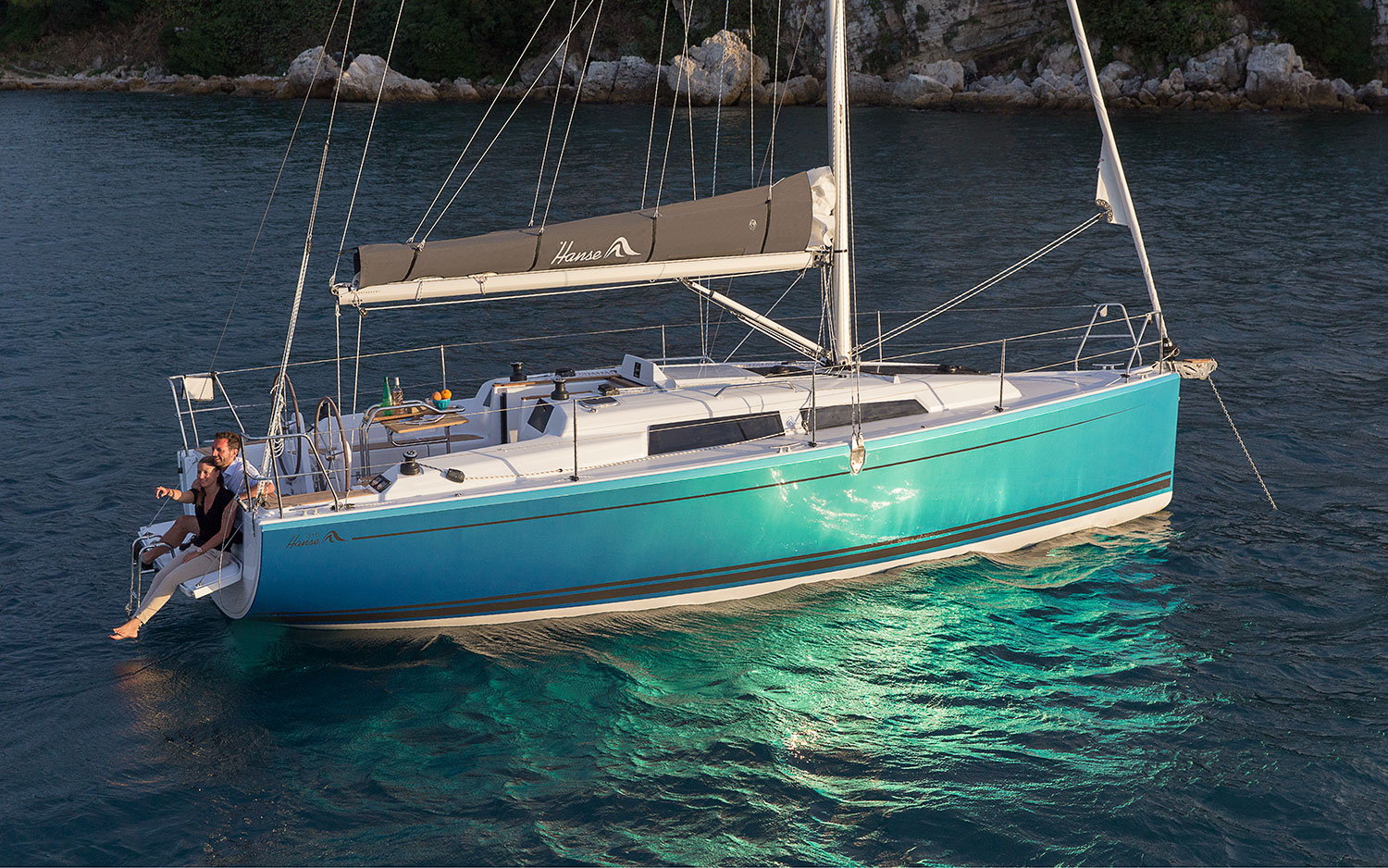
Apr 24, 2018. Hanse's E-motion electric rudder drive represents a true breakthrough in auxiliary propulsion for saiboats. When news that Hanse Yachts had launched a new form of electric-powered yacht first broke in the winter of 2016, it was widely reported. After all, Hanse is one of the world's biggest builders of sailing boats, so this ...
For the first time, the Hanse 410 offers optional electric propulsion with an enormous range of up to 55 nautical miles. This means that even without wind, most destinations can be reached in a climate-friendly way. Hanjo Runde, CEO of HanseYachts : " This innovative electric drive is an important step towards making our product range even ...
The E-MOTION RUDDER DRIVE is a revolution in Yachting.The Hanse 315 e-motion rudder drive was developed in cooperation with the partners Jefa and Torqeedo an...
Hanse 410. Step into the future. Redefining elegance on the seas, her optimized hull featuring chines at the bow and stern provides the uncompromising performance and easy sailing typical for Hanse. Optional electric propulsion and other sustainability features minimise her environmental footprint. And up to three expansive cabins and the ...
The world's third largest boatbuilder, Hanse Yachts, is perhaps the most advanced - offering its entry-level Hanse 315 with an electric rudder-drive option. The system takes up less space than ...
For the first time, the Hanse 410 introduces an optional electric propulsion system, boasting a remarkable range of up to 55 nautical miles. For even greater independence, a fuel cell delivers emission-free energy. Or, turn to the proven power of solar technology to keep essential appliances running on board without burning any fuel.
Its innovative hull shape ensures unrestricted performance. With its unprecedented 51-foot dimensions, the Hanse 510 offers the largest dinghy garage in its class. The spacious cockpit is the perfect place to relax with family and friends. From the generous owner's cabin to the salon to the comfortable crew cabin, this yacht offers exquisite ...
Oct 31, 2016. In Hanse's innovative Rudder Drive system, a Torqeedo electric motor embedded in the boat's rudder provides propulsion. The system will make its debut on the new Hanse 315 e-motion. It was developed by Hanse in conjunction with fellow German company Torqeedo, a leader in electric propulsion, and Jefa, the Danish steering ...
Hanse Yachts introduces E-Motion Rudder Drive - an interesting propulsion type, with a special folding propeller….. An electric engine and a folding propeller have been installed into the rudder shaft, replacing the combination of diesel engine and sail drive. As a result, the propeller thrust is in line with the rudder position. This enables turning in the smallest circles or rotating ...
How it works the new electric propulsion system created by Hanse Yachts and Torqeedo.
Hanse returned to Berret-Racoupeau, who also designed the 460 (a Top 10 Best Boats 2023 winner), to create the 510, and the result can leave you lingering over the lines. Starting with an aggressive, wave-piercing reverse bow, the relatively flat sheer and low deckhouse give this boat a fast, agreeably sharkish look even sitting still, despite ...
Controlling the boat in itself is so much easier anyway, especially if - as most owners of the Hanse 460 will - you upgrade to electric winches, electric in-mast reefing and electric furling ...
World launch at the Hanseboot Hamburg. For the first time, the new propulsion system will be presented installed in the Hanse 315 e-motion rudder drive at the International Boat Show Hanseboot 2016 in Hamburg. We are looking forward to welcoming you to the Hanse Yachts booth (hall 6, booth C108) on Sunday, October 30, 2016 at 2 pm. PDF Download.
Hanse 315. Voted European Yacht of the Year right after its launch, the Hanse 315 is the epitome of what makes a yacht great. With its perfect sailing characteristics and easy handling, the 31-foot entry-level model is easy to maneuver. Two staterooms, a spacious salon with L-shaped pantry and the largest cockpit in its class provide true comfort.
Hanse. Hanse is a yacht brand that currently has 310 yachts for sale on YachtWorld, including 95 new vessels and 215 used yachts, listed by experienced yacht brokers mainly in the following countries: United States, Germany, Spain, Greece and Croatia. The selection of models featured on YachtWorld spans a spectrum of sizes and lengths ...
The Berret-Racoupeau-designed Hanse 460 turned heads as a 2022 Boat of the Year nominee with a fresh take on comfort and volume but with an eye better sailing performance. The second model in the new range designed by the Berret-Racoupeau team, the Hanse 510 is set to make its US premiere at the 2023 Annapolis Sailboat Show—again as a Boat of the Year contender.
Hanse Yachts. Hanse 315, Torqeedo e-motion rudder drive, Jeremy Rodgers Limited. Contessa 32 new build, Beta/Hybrid ... (also with 2 x 10 kW). Salona 46, also known as the "almost perfect electric sailboat" in this Sailing Uma video. Picture from salonayachts.com. Spirit Yachts. SPIRIT 44CR(E), Oceanvolt 15 kW. Viator Marine. Viator ...
The nation's first all-electric tug boat has docked at the Port of San Diego and expects to begin emissions-free operations in about a month. Operated by Crowley Maritime Corporation, the 82 ...
Boat engineering and design company EJET Electric Yacht Tenders has announced the development of its latest electric motor 9X yacht tender model. Ljubljana, Slovenia - March 21, 2024 — Much like ...
Check out this Used 2024 Hanse 418 for sale in Newport, RI 02840. View this Cruisers and other Sail boats on boattrader.com. ... all while enjoying the elegance and style of the very well-designed HANSE Yachts 418. Feel right at home on the open seas with the trademark fast hull line and impressive sail plan, crafted by the world-renowned yacht ...
The all-electric-powered Candela P-12 ferry flies over the water on hydrofoils. Candela. I would never say "I told you so," but…now that Candela, the world's leading producer of all ...
Boat Review: Hanse 315. The baby of the Hanse 5 series, the 315, looks surprisingly serious at the dock. She's got an almost predatory look, even compared to any 50-footers that might be in the area—which seems funny until she gets out on the water and kicks some booty. Between her easy-sailing rig that cuts down on tacking drama and her ...
Electric boat maker Candela is approaching cruising speed with $25 million in new funding and the first commercial deployment of its new P-12 ferry in New Zealand. The company has global ambitions ...
Hanse 458. The new Hanse 458 is the yacht for all of those who set trends. With a pioneering design and the most thrilling performance in its class. With an exquisite interior and an exceptionally diverse range of customization options. The Hanse 458 caters to the highest demands on contemporary style and quality of life.
Find company research, competitor information, contact details & financial data for BETA GIDA, OOO of Elektrostal, Moscow region. Get the latest business insights from Dun & Bradstreet.
It has been over a year since first being introduced to Limerick based 4-piece Moscow Metro* through their wonderful debut double-A side containing the tracks "Spirit of a City" and "Cosmos" for free, which sounded near perfect in spite of the band only being together for a few months at the time of recording. Now fast-forward 12 months, and as a result of the initial love for the band, they ...
Known as the "Motor City of Russia." Elektrostal, a city located in the Moscow Oblast region of Russia, earned the nickname "Motor City" due to its significant involvement in the automotive industry.. Home to the Elektrostal Metallurgical Plant. Elektrostal is renowned for its metallurgical plant, which has been producing high-quality steel and alloys since its establishment in 1916.
Local band Moscow Metro (featuring Barry McNulty, Sean Corcoran, Dylan Casey & Alan Holmes) will perform on the Cosby Stage at 12.55pm on Saturday at the Electric Picnic.

IMAGES
VIDEO
COMMENTS
Michael Blackburn's book says optimal weight for big rig is 78-83 kg, for Radial 65-72 kg. Glenn Bourke's book says 78-80 kg (172-176 lb) is "the key weight for good all-round performance, although you can get away with being 76 kg (168 lb) or up to 84 kg (185 lb)." When I've spoken to guys like Michael about weight and mentioned that Stu ...
Thanks to the three rig sizes in the Laser class, the weight range in the Laser is quite large. Generally, the Laser Radial (ILCA 6) is suitable for sailors between 60kg and 75kg while the Laser Standard (ILCA 7) is suitable for sailors 75kg to over 90kg. The Laser 4.7 (ILCA 4) is designed specifically for younger and lighter sailors with an ...
The Laser Dinghy - 3 Sailboats In 1. The Laser Dinghy - 3 sailboats in 1. The laser dinghy comes in 3 rig sizes: 4.7 / ILCA 4. Radial / ILCA 6, and. Full/Standard / ILCA 7 rig. This means that sailors of just about any ability or age can enter the sport, and advance with minimal cost. Rigging is easy using a sleeved sail over a mast with no ...
The Laser is a class of single-handed, one-design sailing dinghies using a common hull design with three interchangeable rigs of different sail areas, appropriate to a given combination of wind strength and crew weight. Ian Bruce and Bruce Kirby designed the Laser in 1970 with an emphasis on simplicity and performance.. The Laser is a widely produced class of dinghies.
Laser Standard / MK2 / ILCA 7. This is the most common Laser rig size, and the original rig on the boat when it was designed. It features a 7.06 square meter sail (about 76 square feet). In 2018, the Laser Class approved a new 'Standard' sail, which is referred to as the 'MKII' or 'Mark 2' to distinguish it from the first version.
It takes into consideration "reported" sail area, displacement and length at waterline. The higher the number the faster speed prediction for the boat. A cat with a number 0.6 is likely to sail 6kts in 10kts wind, a cat with a number of 0.7 is likely to sail at 7kts in 10kts wind. KSP = (Lwl*SA÷D)^0.5*0.5
Standard - 7.1sqm sail for heavier and more athletic sailors. Radial - 5.1sqm sail for women, and lighter sailors. 4.7 - 4.7sqm for youth and lighter females. The Laser is a true sailing phenomenon. With nearly 200,000 boats in 140 countries, it is clearly the world's most popular adult and youth racing sailboat.
The ILCA 4 uses a short pre-bent lower mast to maintain a balanced helm and a sail area that is 35% smaller than the ILCA 7. It is ideal for the lighter-weight sailor graduating from Optimist. The ILCA 6 is the next step up in size. It uses a more flexible and slightly shorter lower mast together with a sail area 18% smaller than the ILCA 7.
4.7 Rig - Designed for smaller sailors 110 - 140 lbs. (50 - 65 kg). Radial Rig - Used as the women's Olympic class, and designed for sailors 140 - 175 lbs. (65-80 kg). Full or Standard Rig - Used as the men's Olympic class, and designed for sailors 165 lbs.+ (75 kg+)."Olympic sailors are in the 180 lbs. range but club sailors ...
Introduction to Laser Sailing. April 3, 2018 Katie Olsen How To. by Jon Emmett. The Laser is truly the boat for all ages from our Junior 4.7s to our legendary (over 75 year old) Masters. No other adult class is raced in more countries in the World, in a class which takes grass roots to Olympic sailors. Come and join us to see why!
Sail Area / Displacement Ratio. A measure of the power of the sails relative to the weight of the boat. The higher the number, the higher the performance, but the harder the boat will be to handle. This ratio is a "non-dimensional" value that facilitates comparisons between boats of different types and sizes. Read more. Formula. SA/D = SA ÷ (D ...
CASCAIS FUN. Designed to be fast, fun and safe, the Cascais Fun is the perfect option for those seeking to learn how to sail or want to have a day of enjoyable sailing. It has aluminium spars and foils and Dacron sails. It can be rigged with main, main and jib or if you are looking for most complete experience you can add the optional gennaker.
It is the perfect rig for a 55-70kg sailor. The Laser standard (ILCA 7) sail and rigging or otherwise known as a 'full rig' is ideally set up for heavier weighted people due to the increased sail area. ... This allows sailors to progress depending on their ability and weight and height, making it a boat that can be sailed for many many ...
The absolute simplicity of this boat is amazing. Upwind it locks into a groove, which in most boats you have to fight to maintain. Downwind is a dream; the SB3 is an incredibly stable platform ...
Kirby is a world-class sailor and Olympian himself—he represented Canada in '56, '64, and '68—but he is most famous as the designer of a slew of boats known for their swiftness, and also ...
To properly rig a Laser sailboat, it is important to understand the components involved, including the rigging lines. Here are the steps to follow: 1. Begin by setting up the main halyard. Attach it to the head of the sail and run it through the top of the mast. 2.
Laser boats are 13.78 feet long and some use a smaller sail depending on your weight. The Laser hull is an excellent dinghy design with a few sail modifications. Laser sailors are able to transport the boat on a trailer or the top of a typical car. Laser sailing is arguably the best dinghy since it utilizes an ideal weight and boat length.
In moderate winds, any weight can sail the Laser Standard, but as the wind increases, it is better suited to heavier sailor weights. Apart from the significant second-hand market for Lasers with the Laser Standard rig, the lower mast and sails for Laser Radial and Laser 4.7 as a separate package from the hull have an even stronger second-hand ...
The Laser is the world's most popular adult racing class boat. True to box one design standards, each Laser in the world is identical ensuring the best sailor on the water wins the race, not the boat. The Laser is a challenging boat that rewards athleticism, subtle steering and trimming techniques, as well as the tactical excellence of the ...
Exceptional endurance with minimal weight. Making 4.5 knots with calm seas, the new Hanse 315 equipped with four lithium-ion batteries has a range of up to to 30 nautical miles - enough for all European inland waters and many coastal waters. ... The NKD Sailor. Electric Sailboats. For prospective buyers, here is a list of new sailboats that ...
There have been more than 30 laser attacks on pilots since the start of the year, compared with five in 2010. The majority of the incidents took place near airports in Moscow and Rostov-on-Don ...
J H. M. S. Pinafore or the Lass that Loved a Sailor (1878)No. 1 "We sail the ocean blue": men's chorus with altos 2'16" 2 No. 6 and No. 7 "Over the bight ...